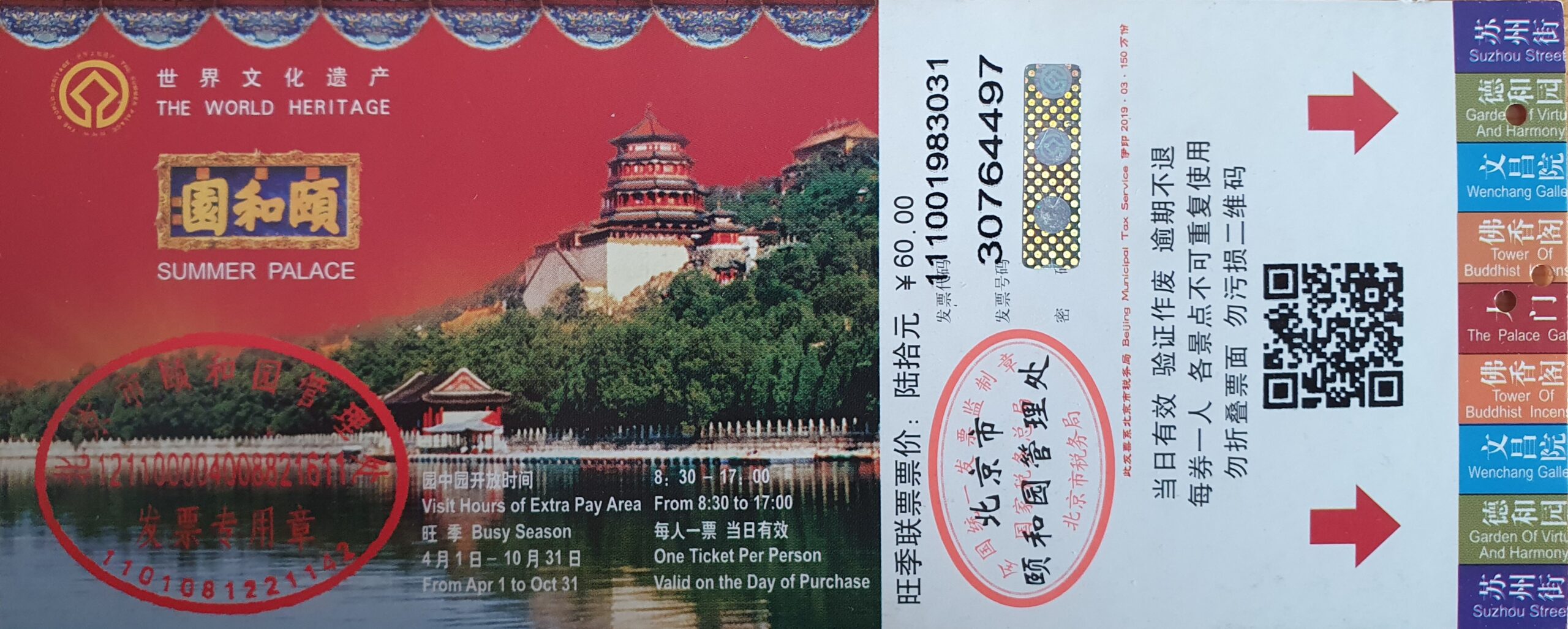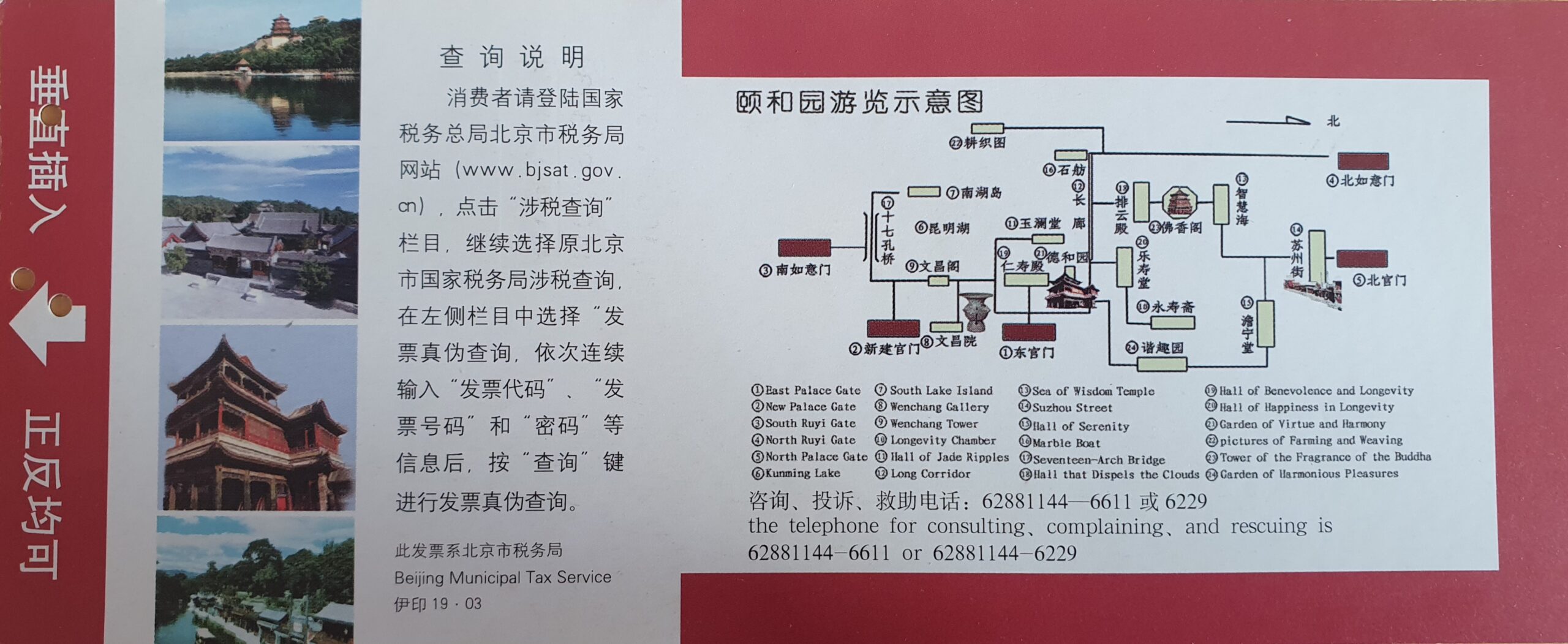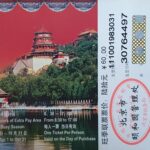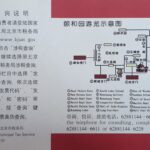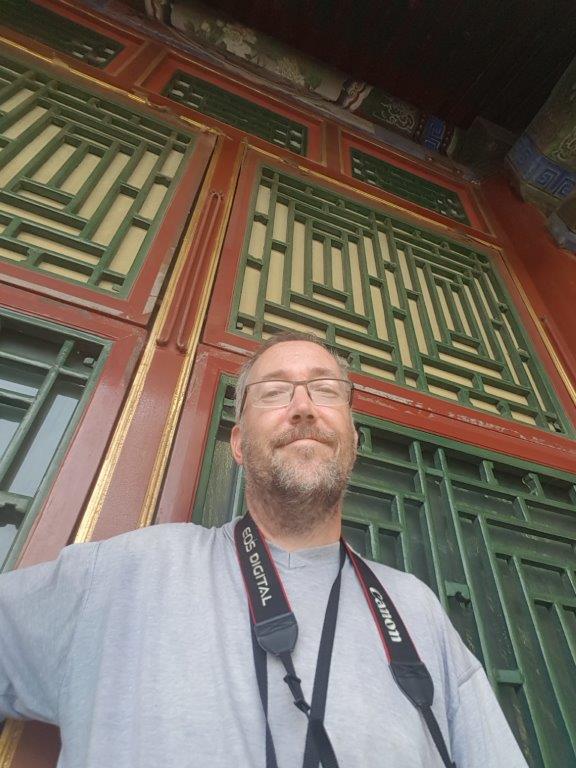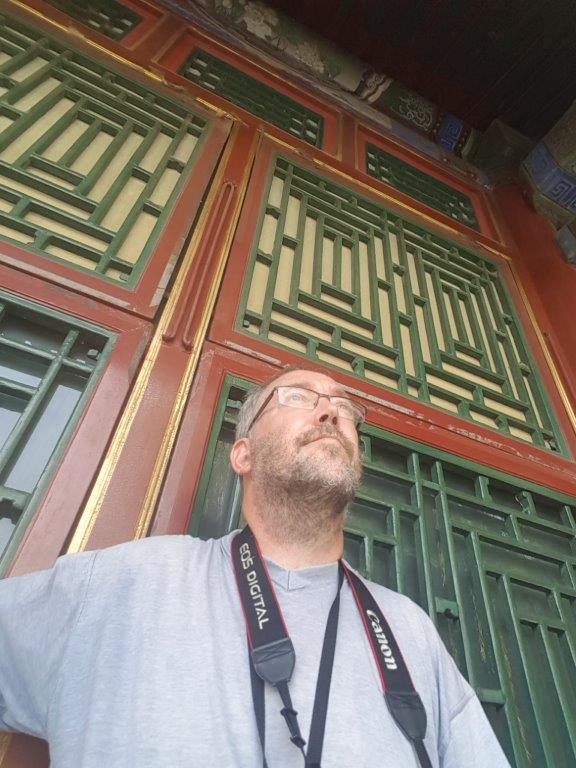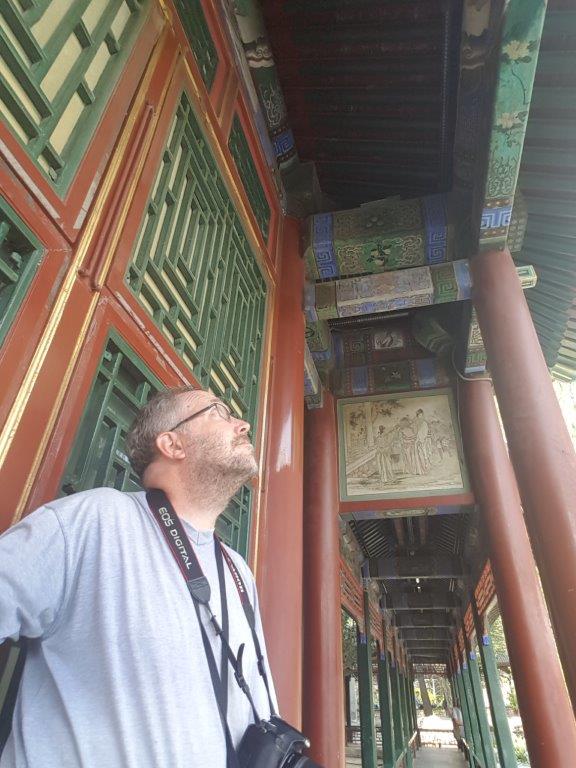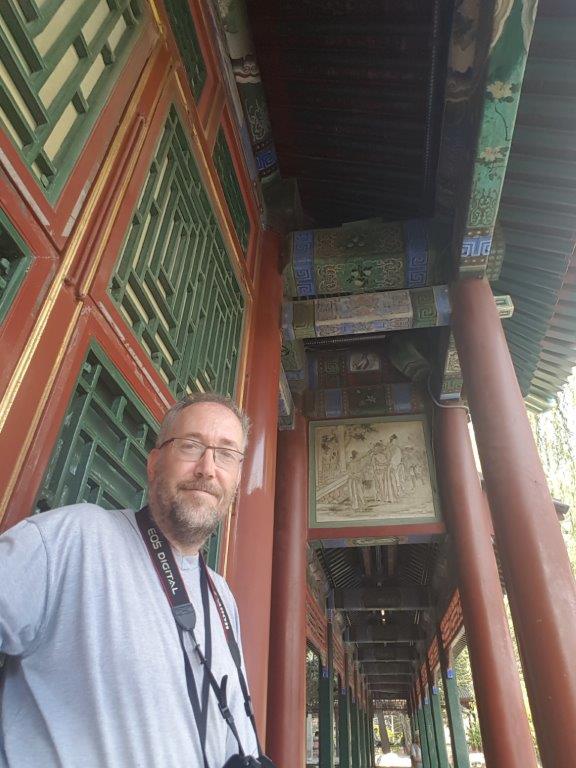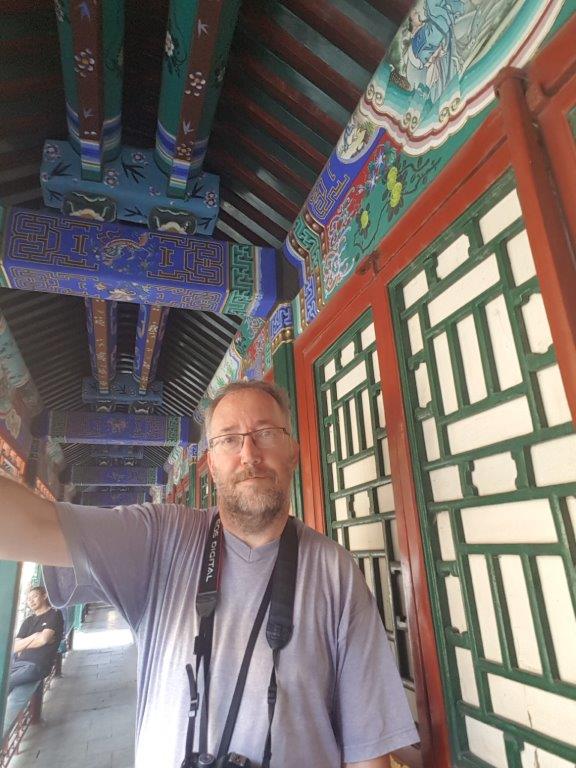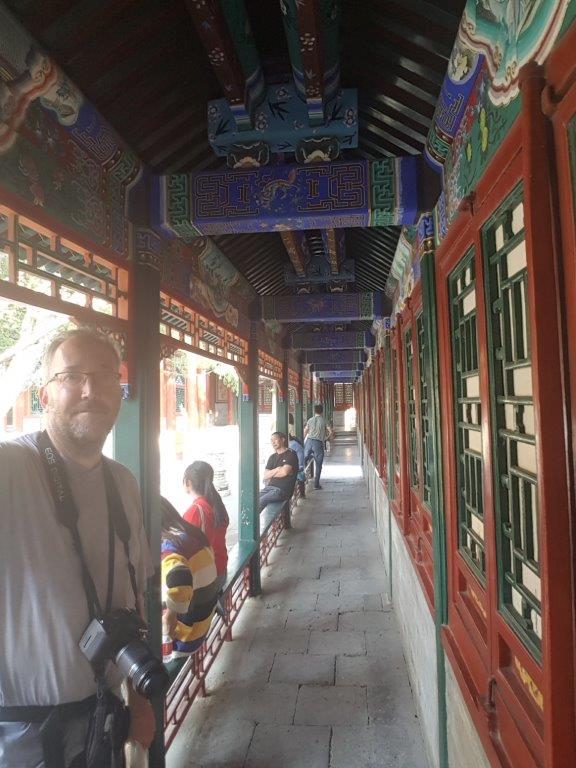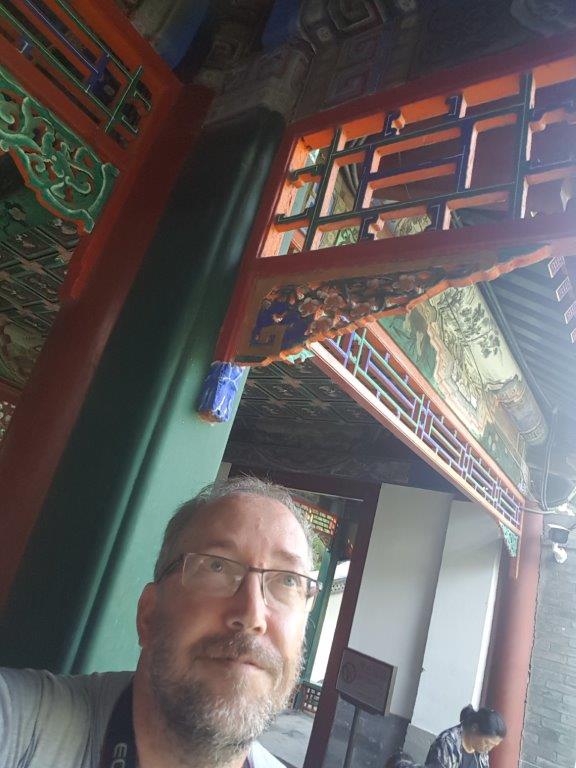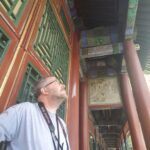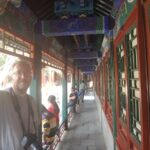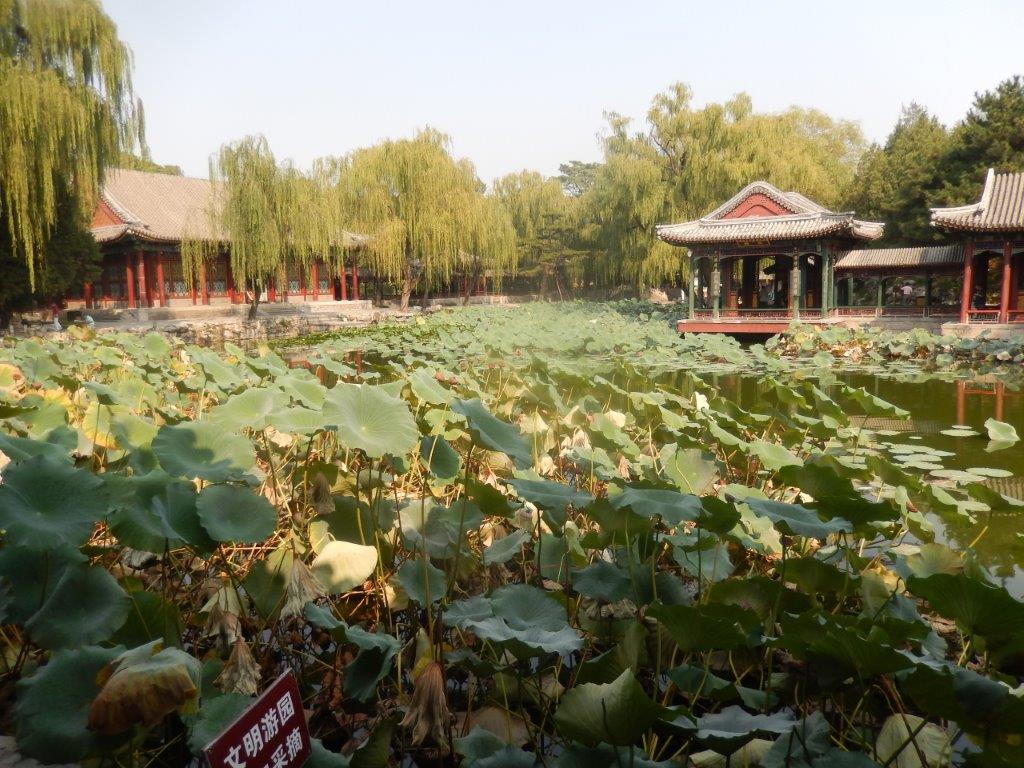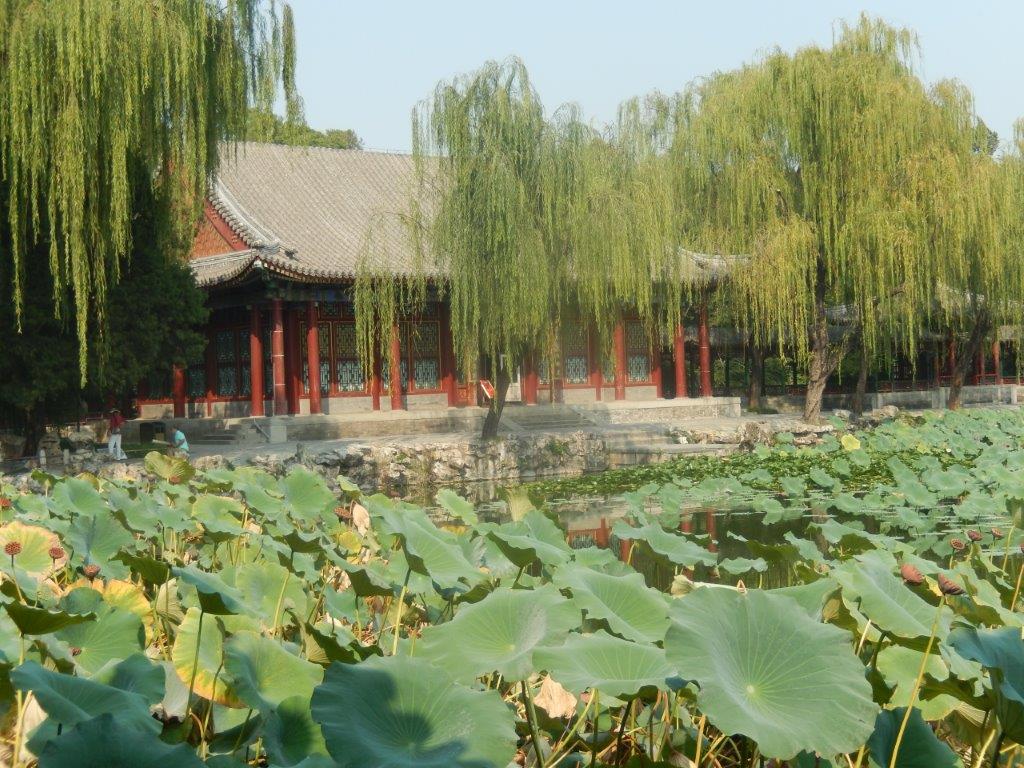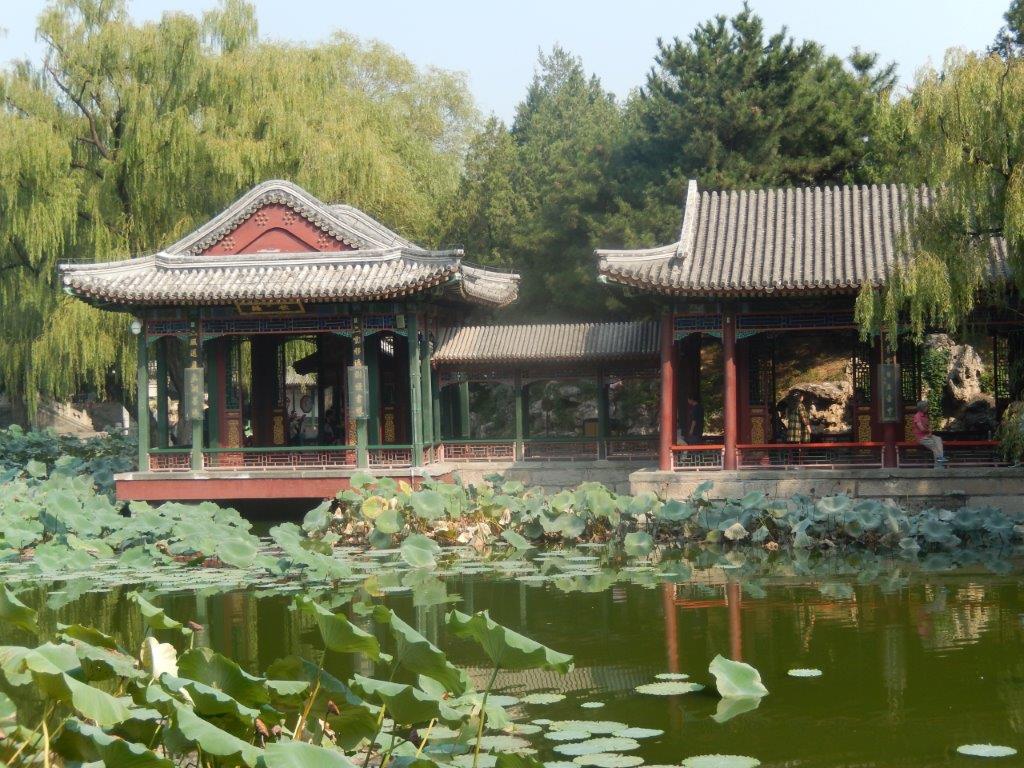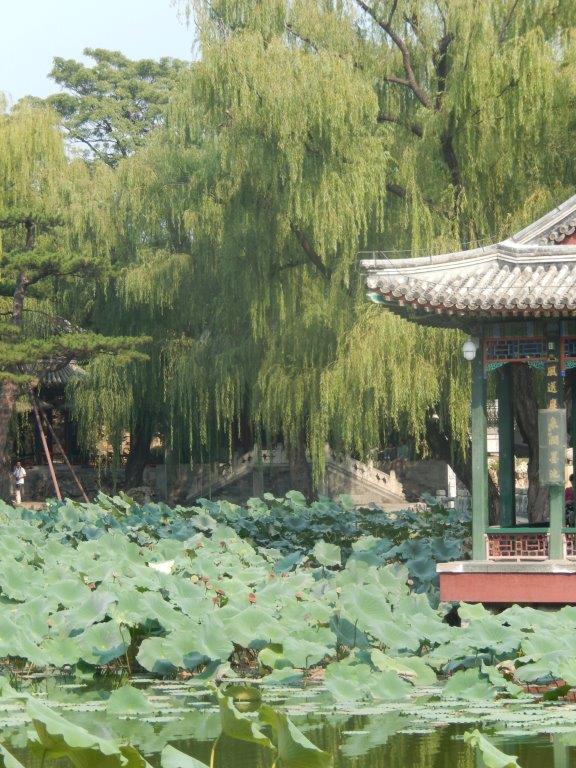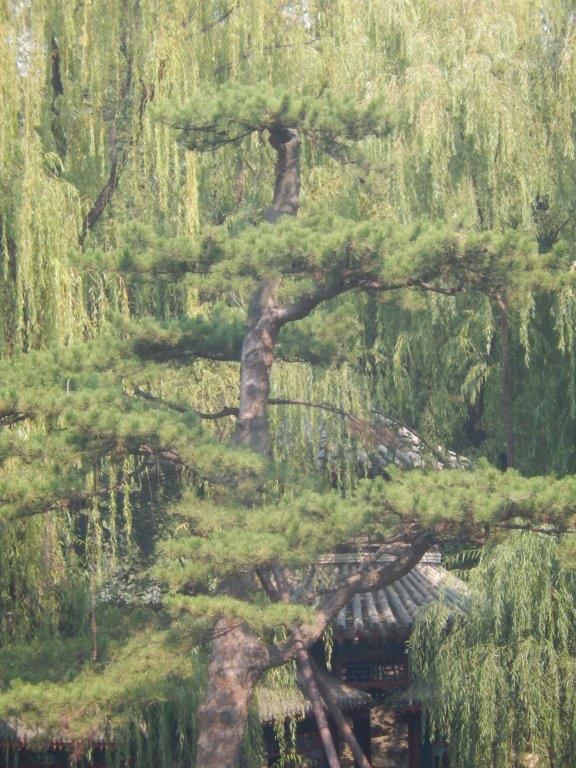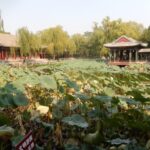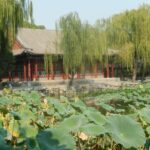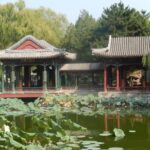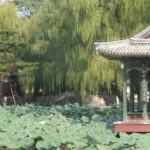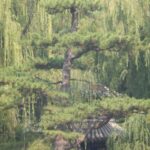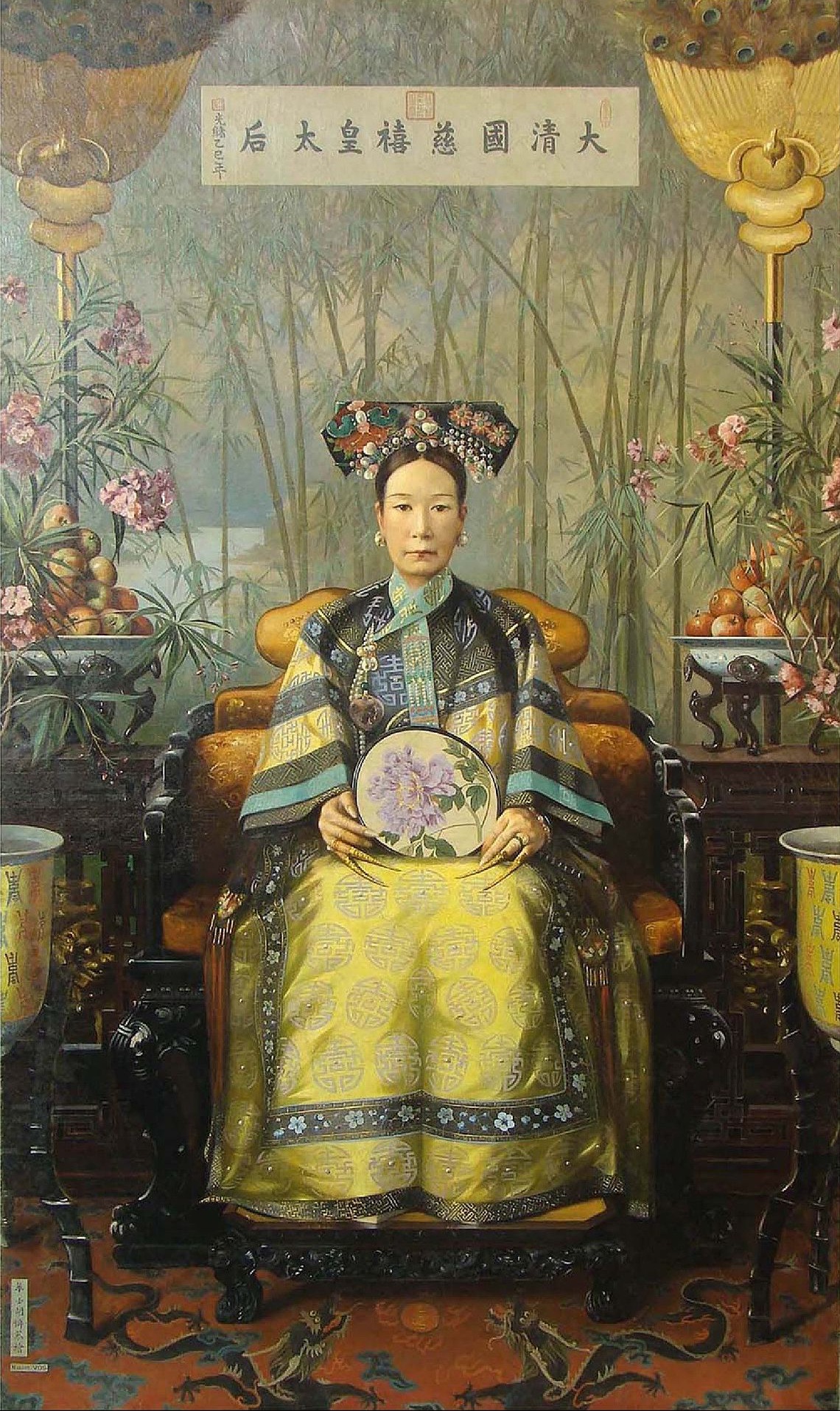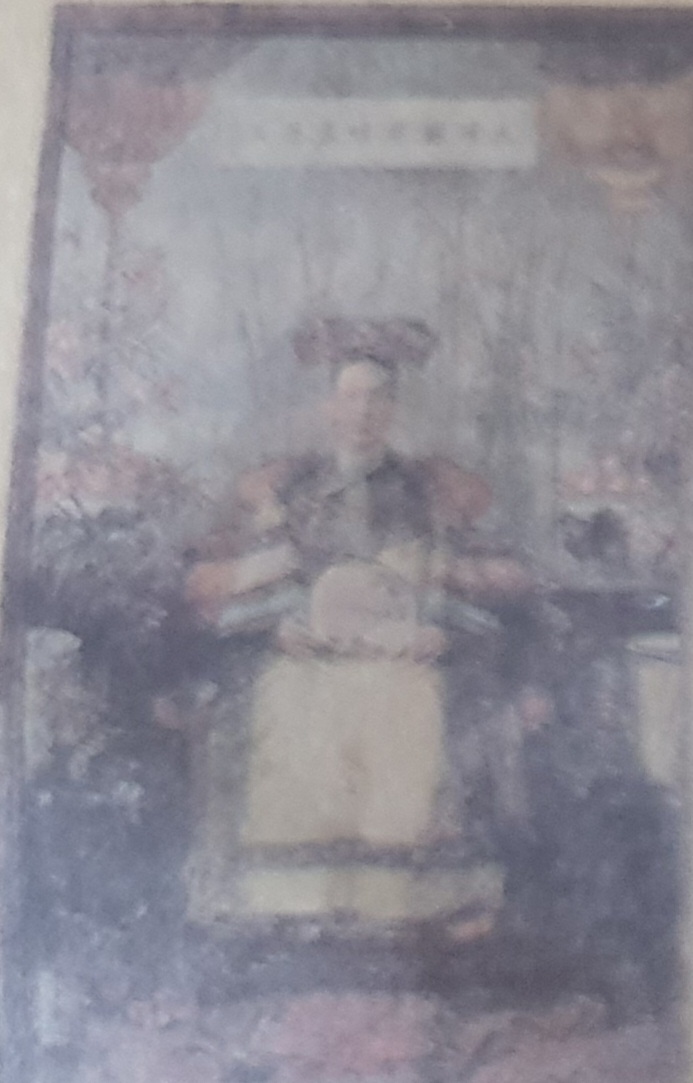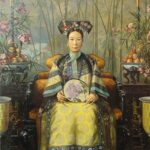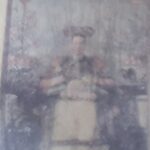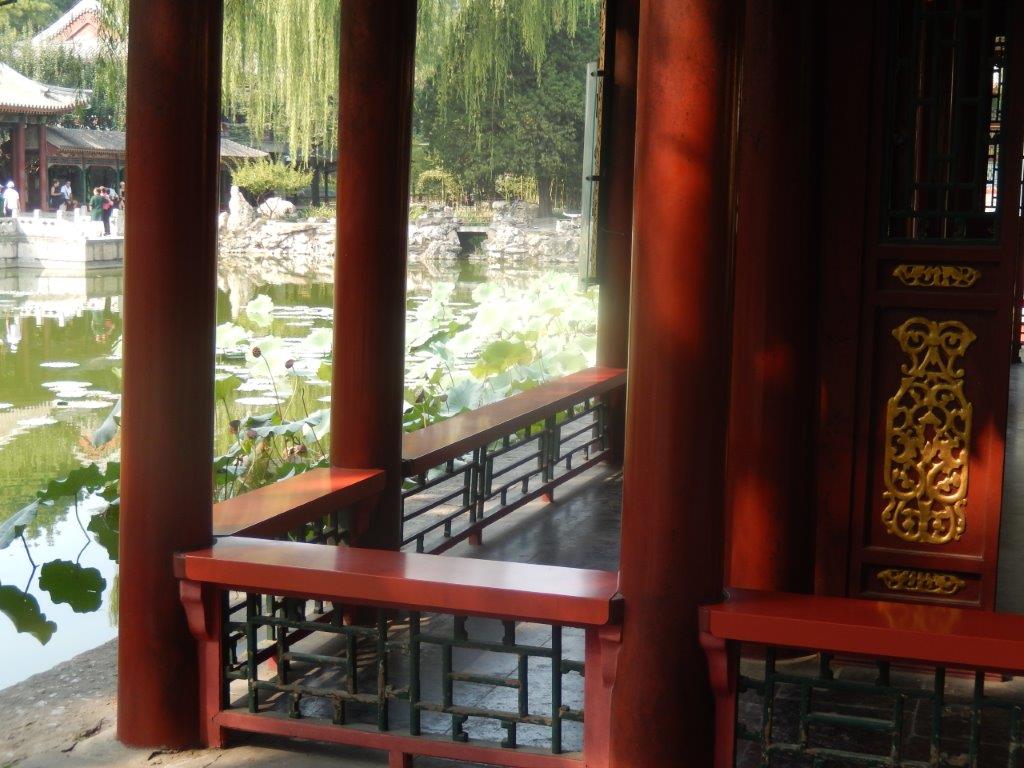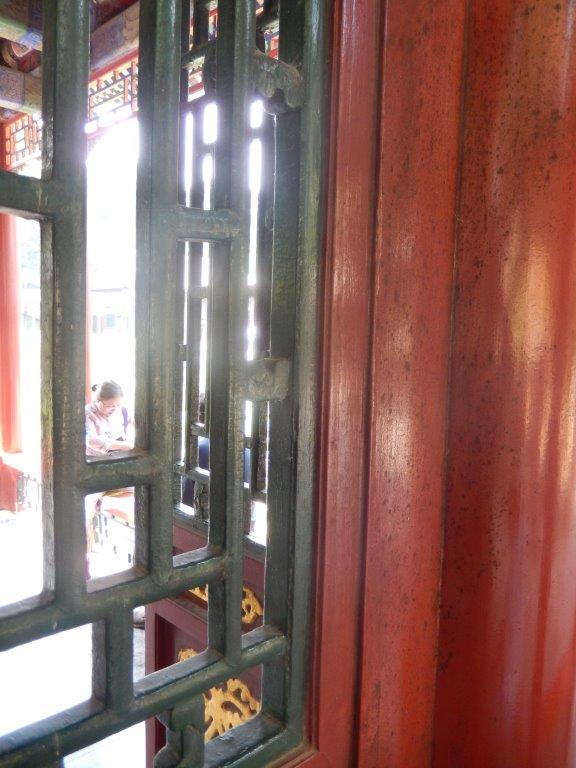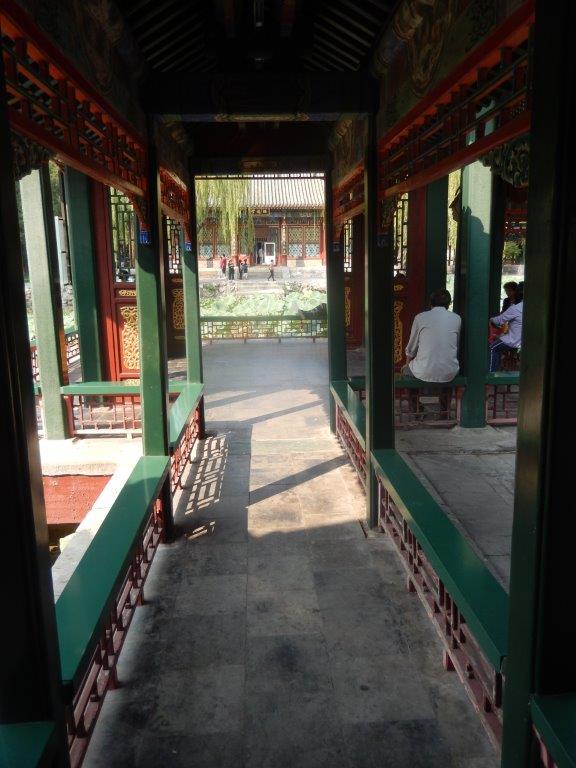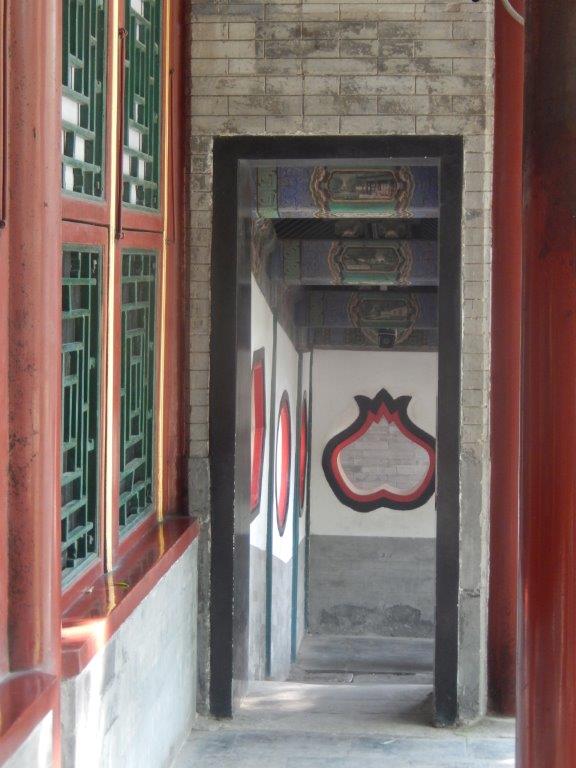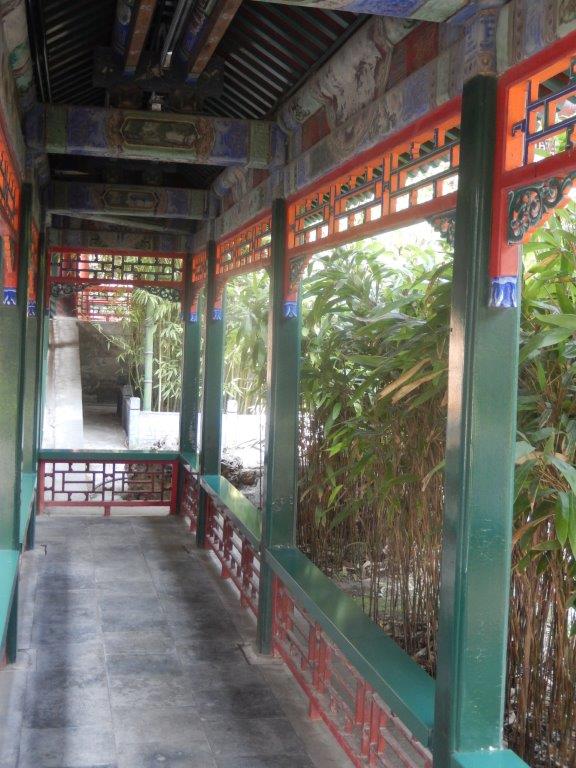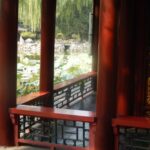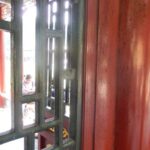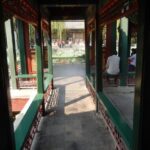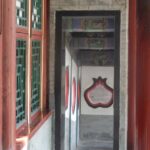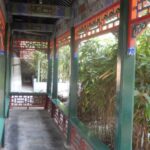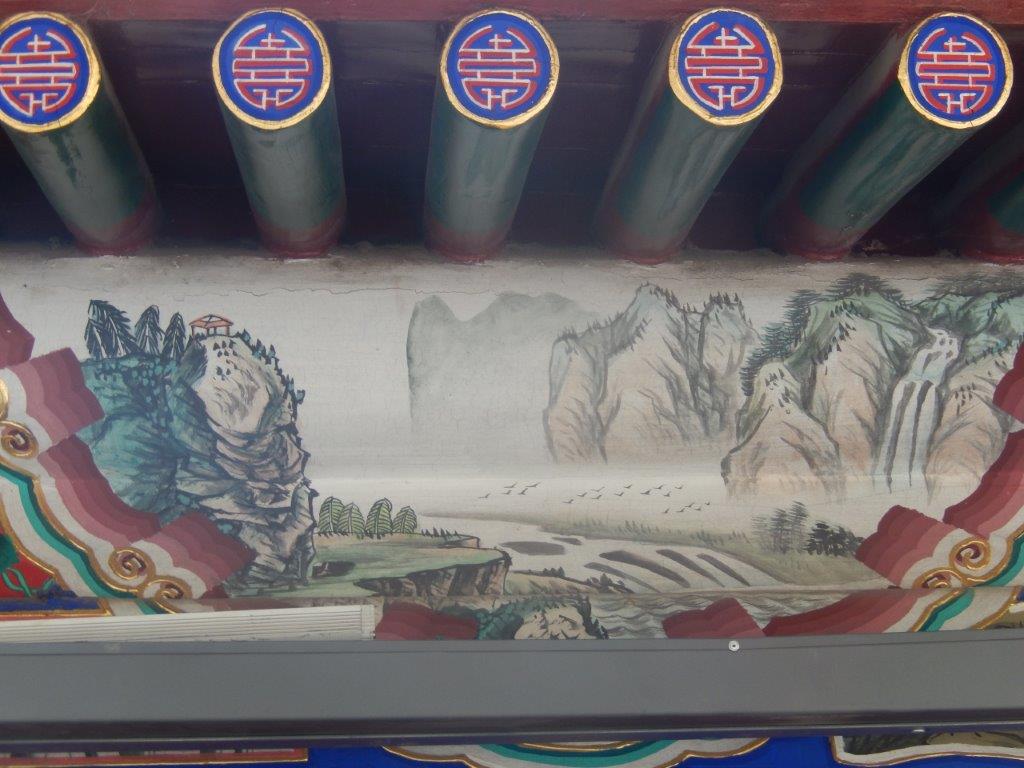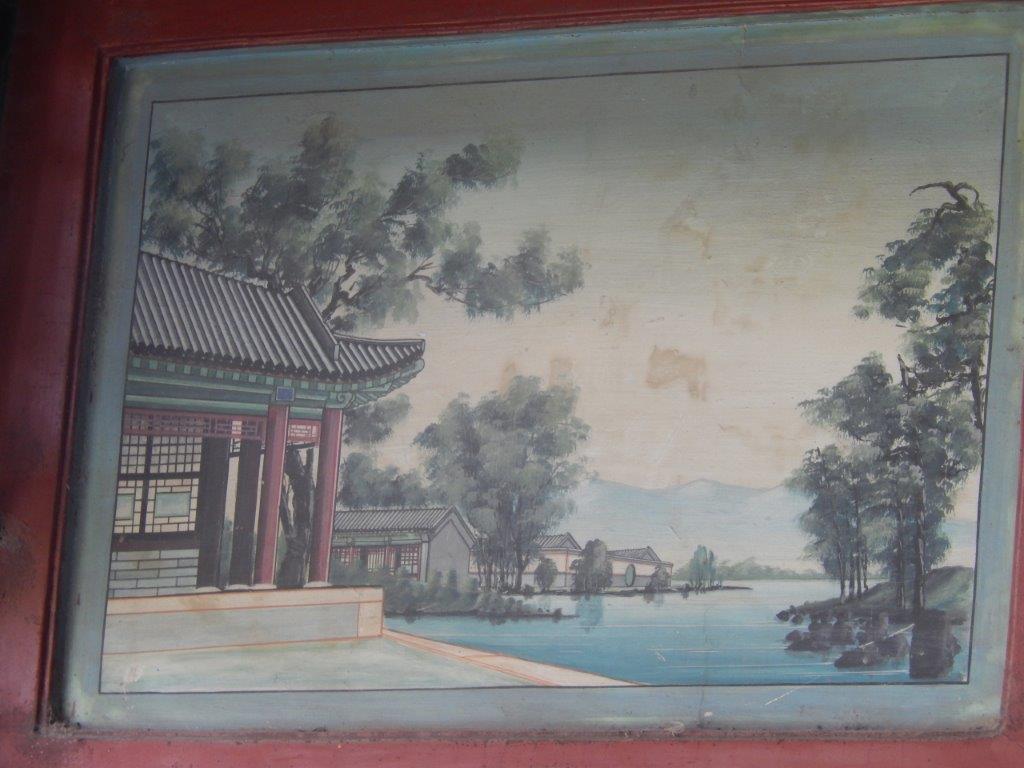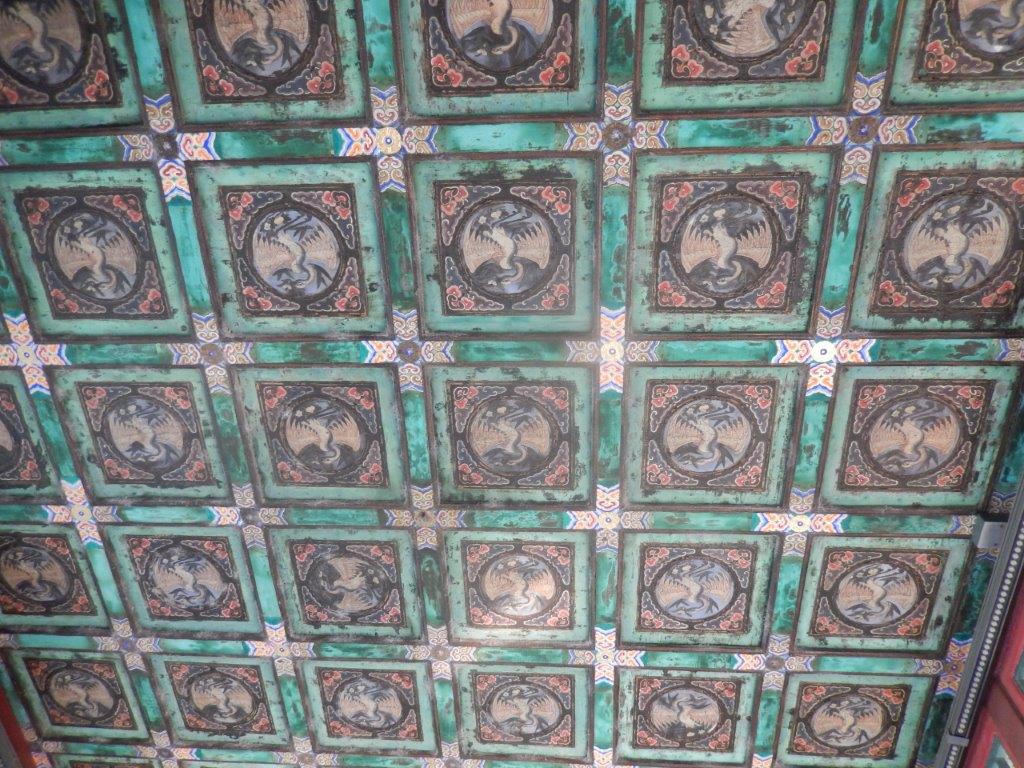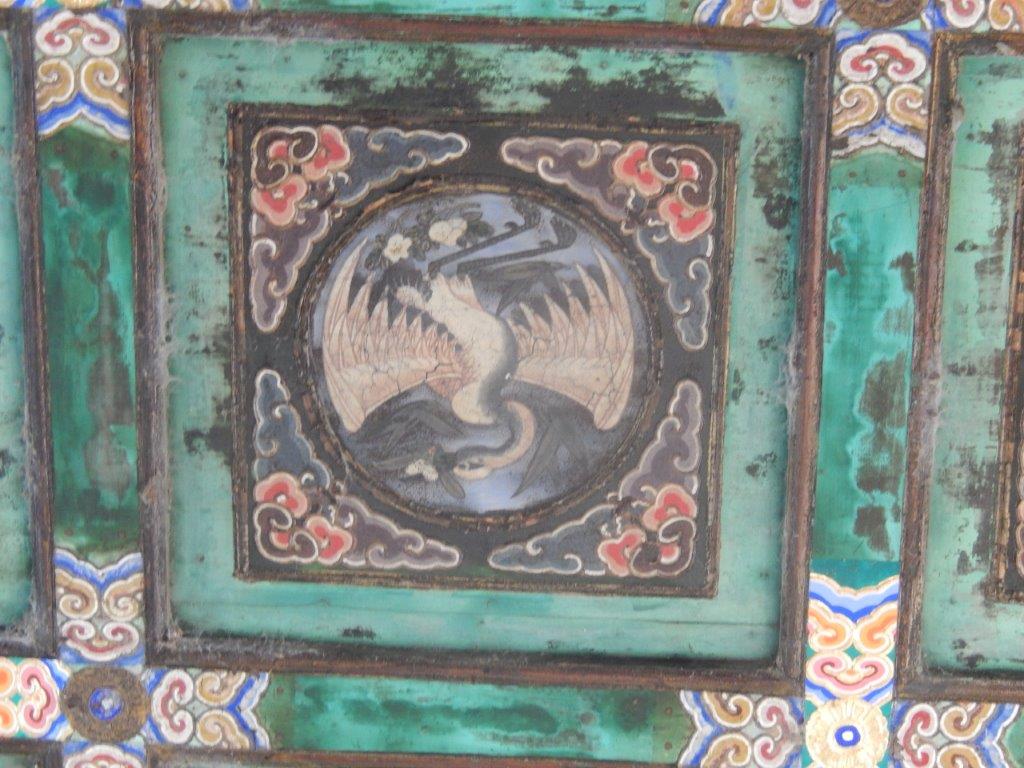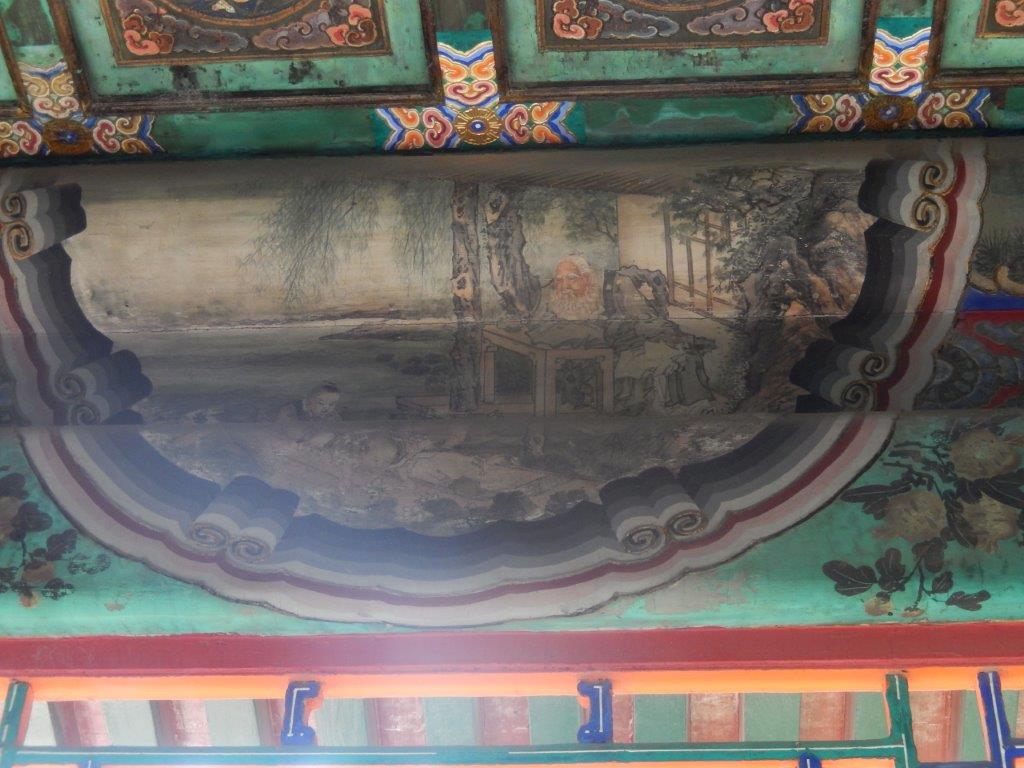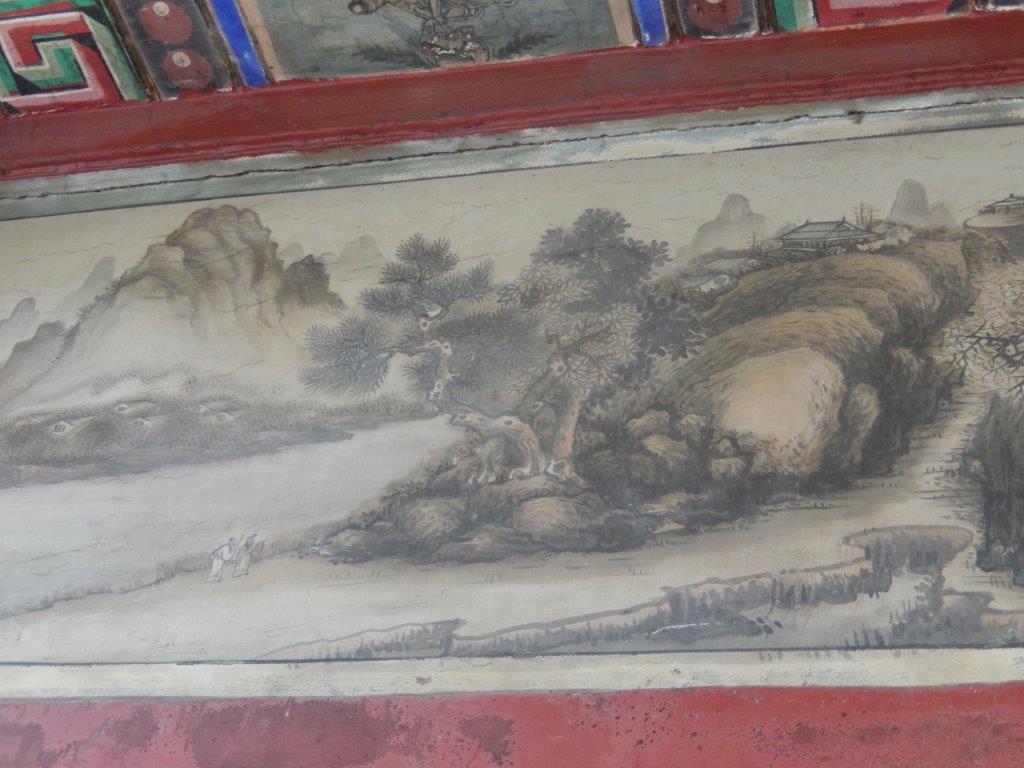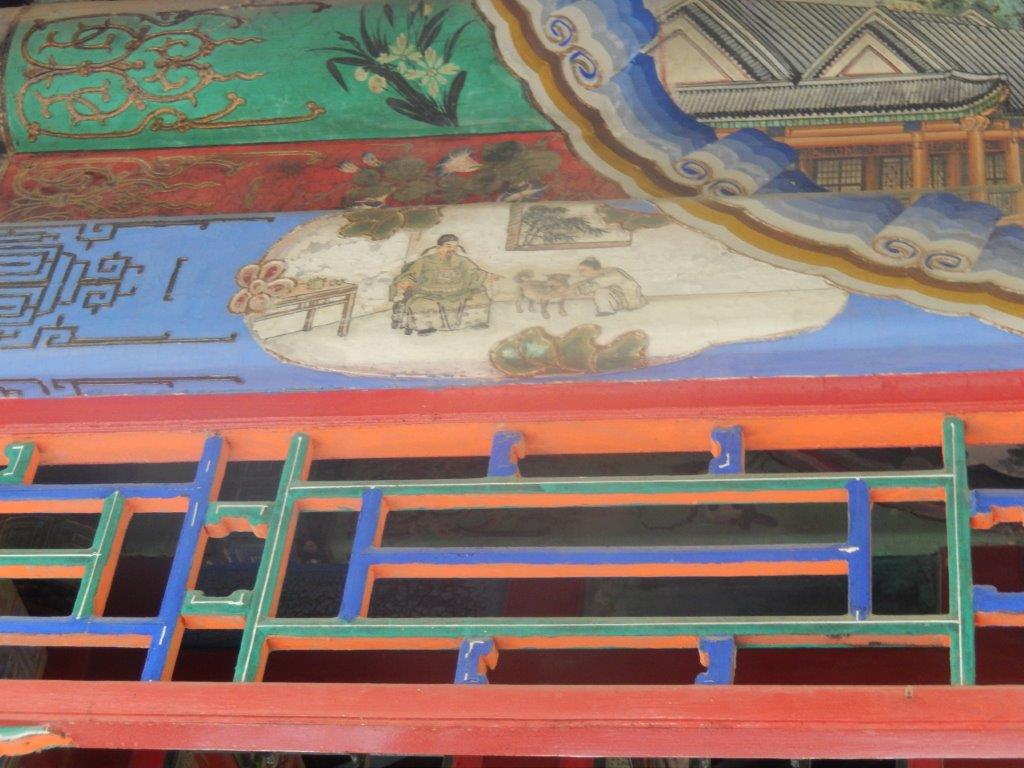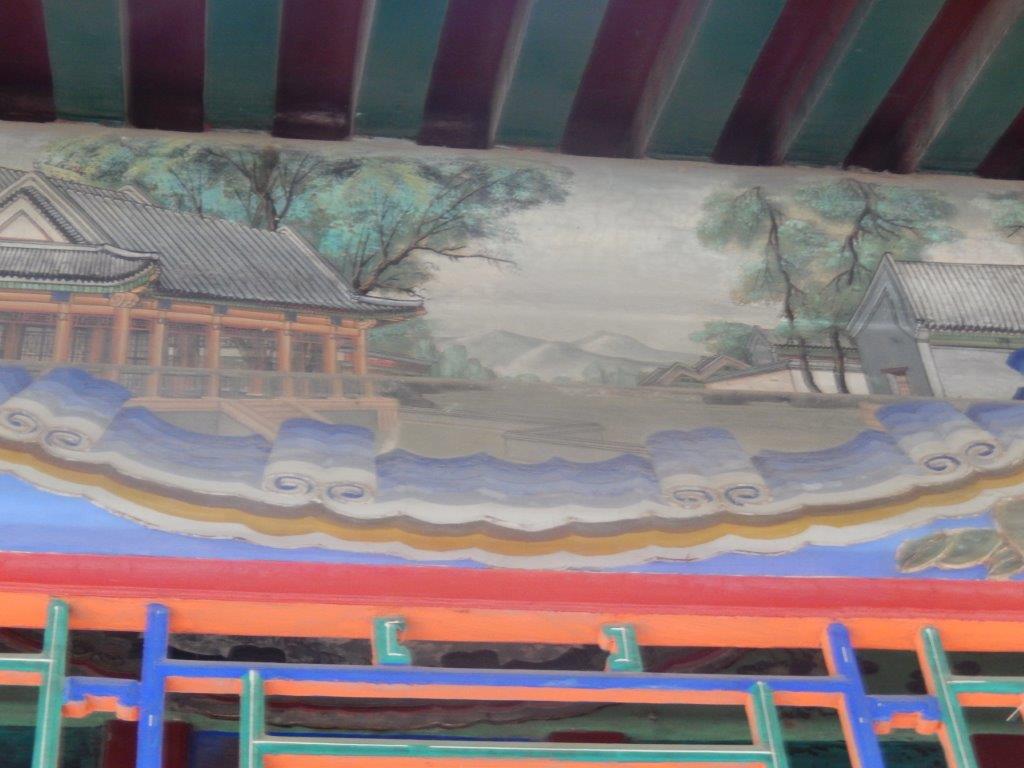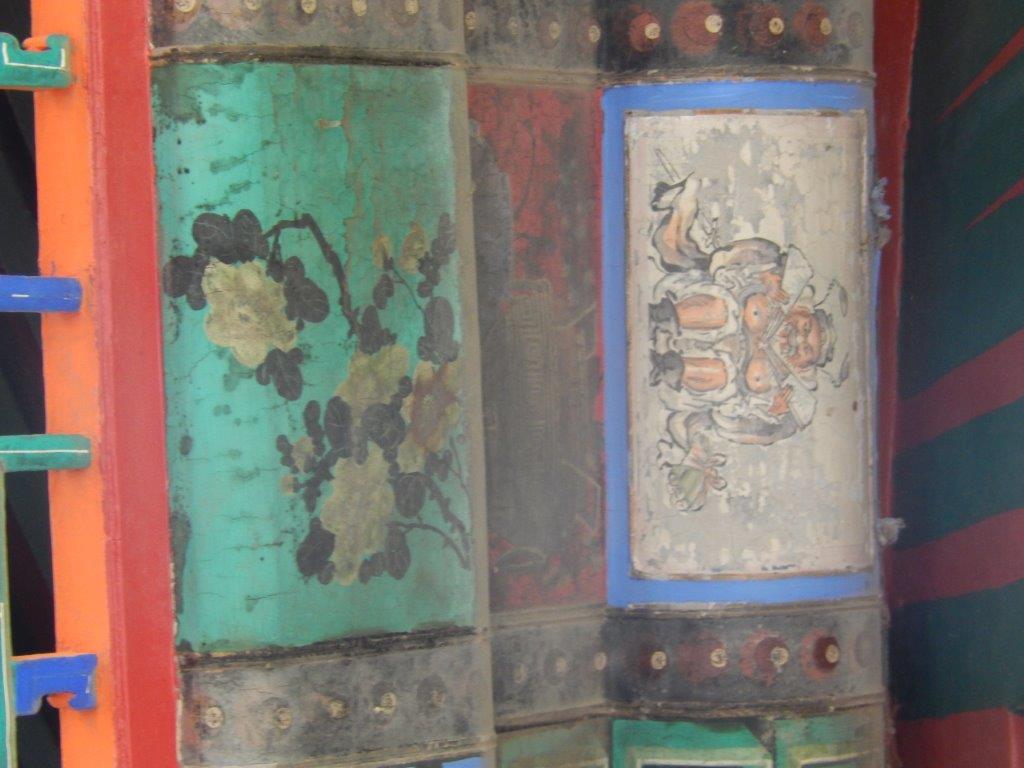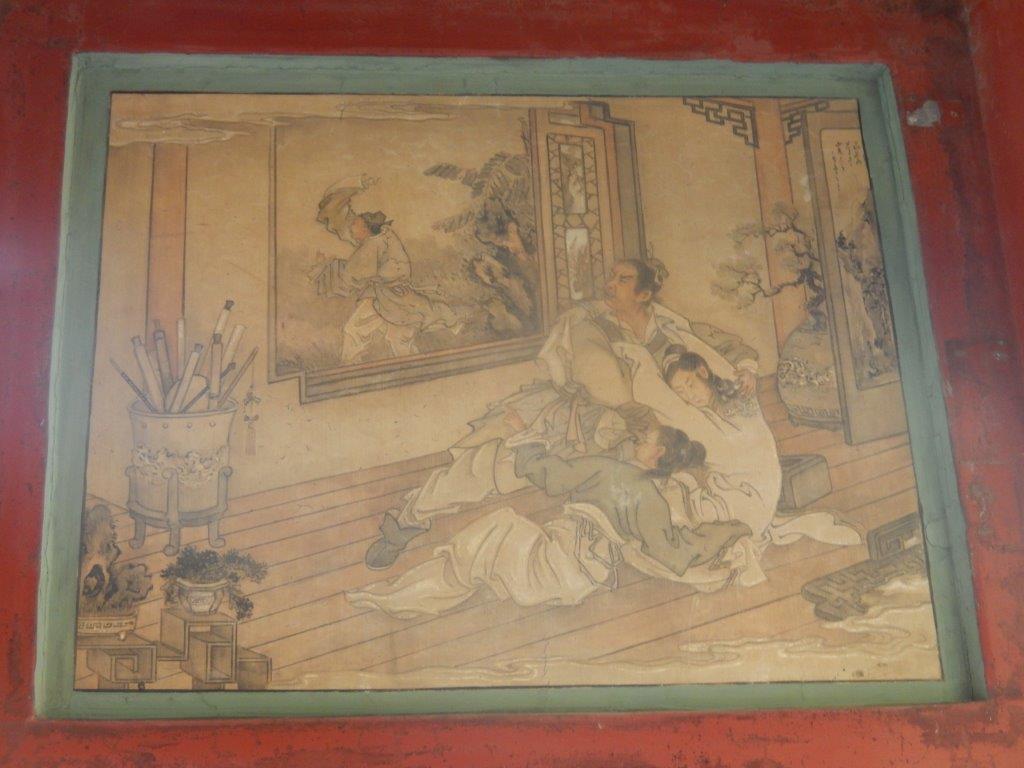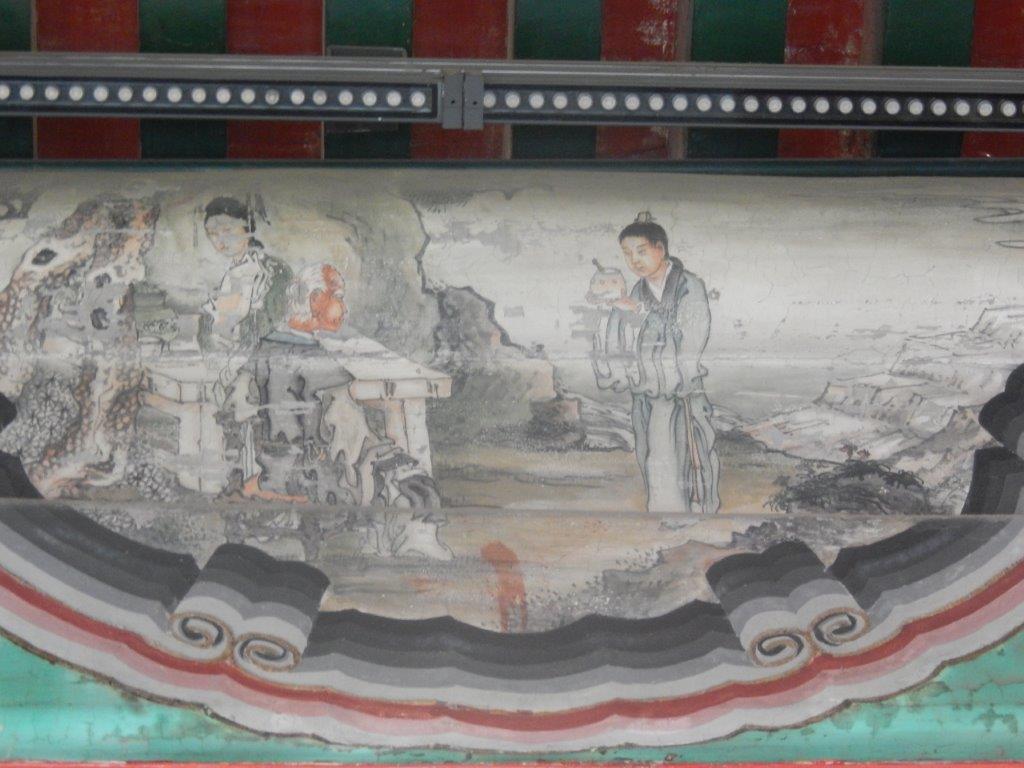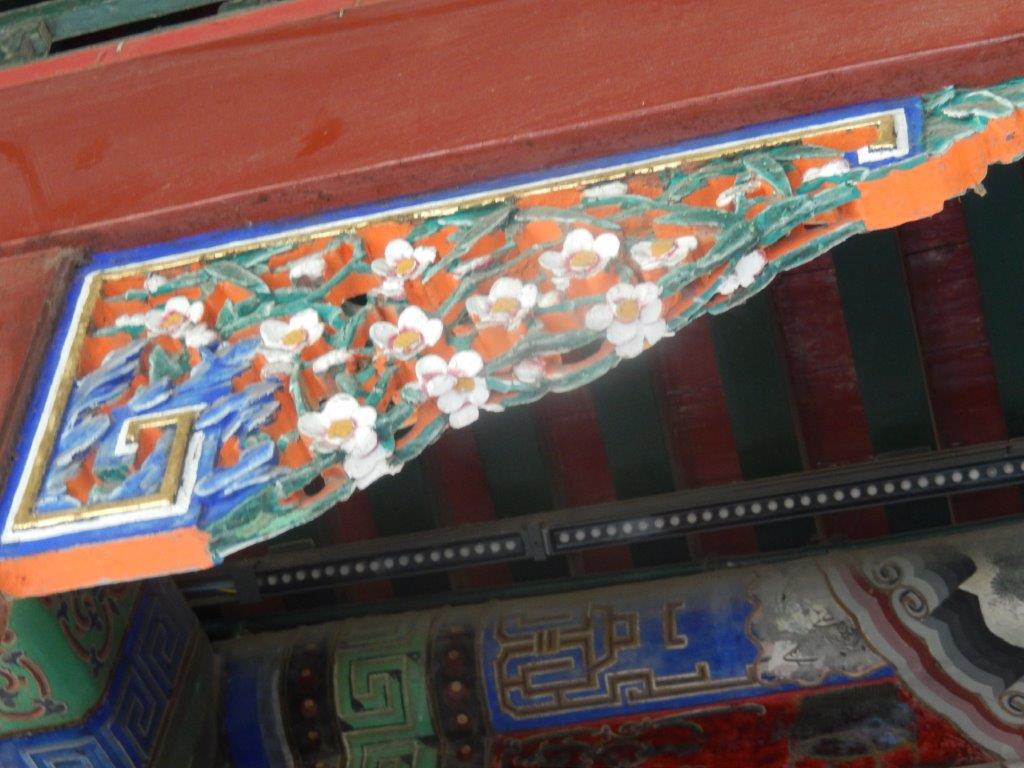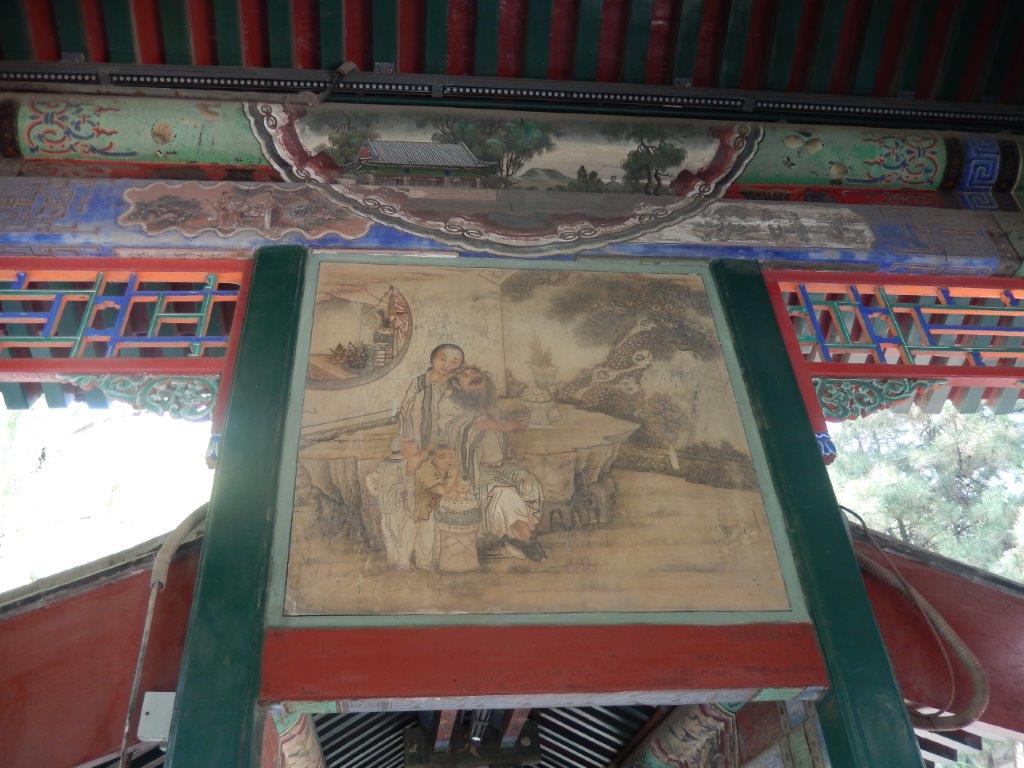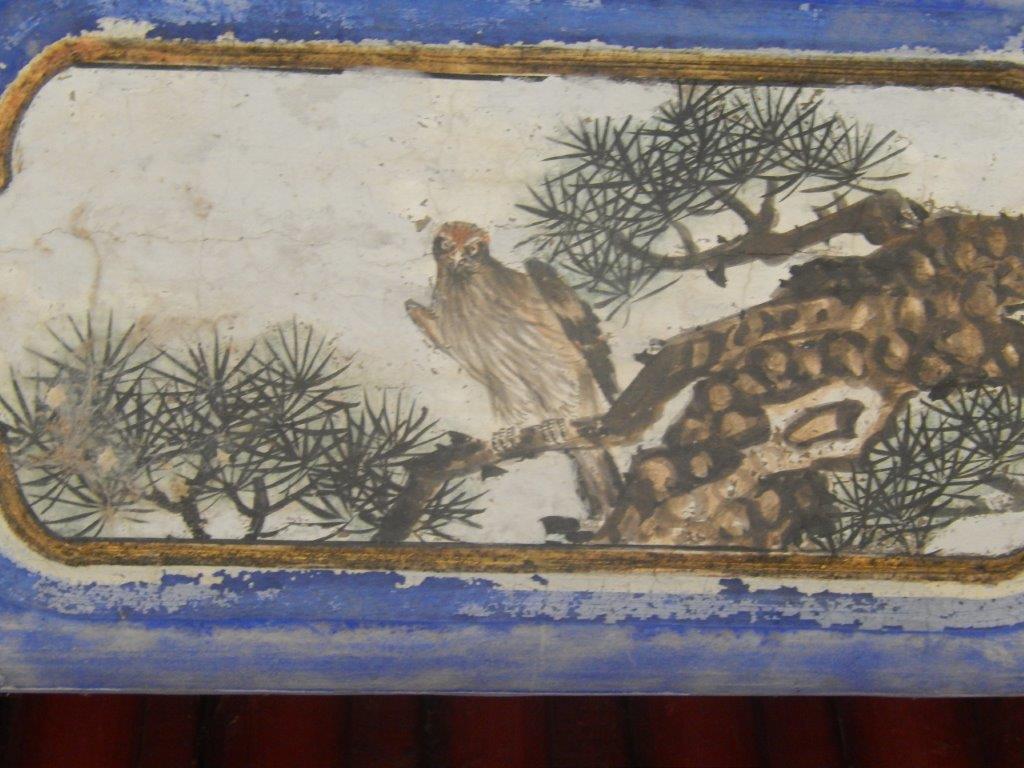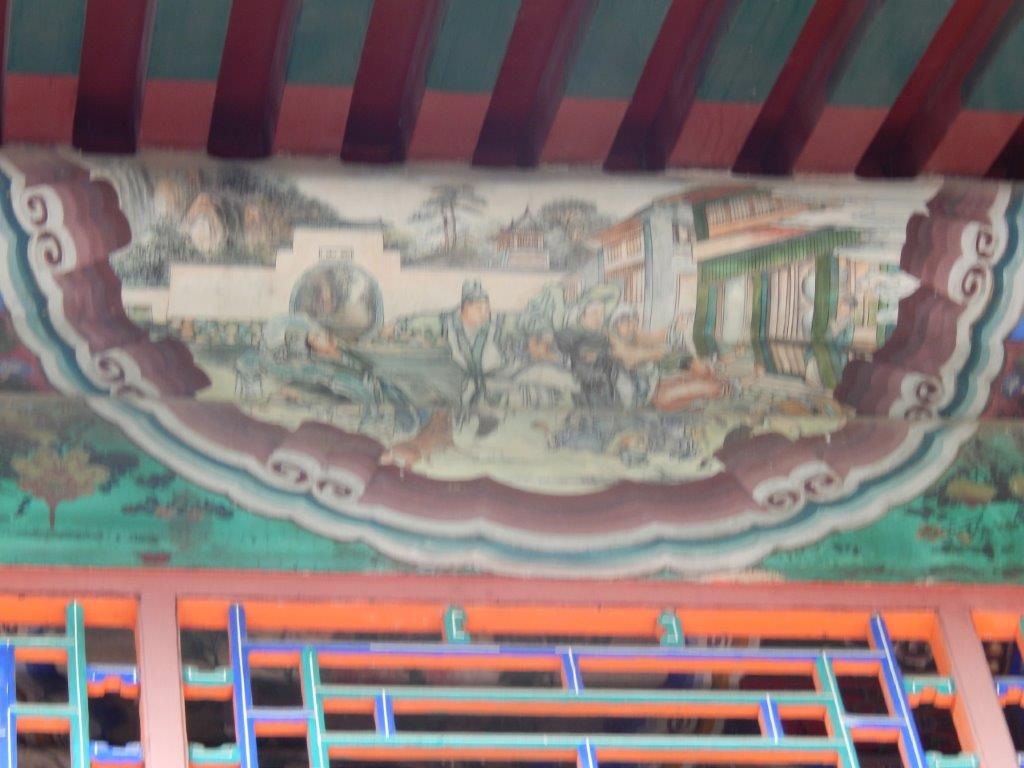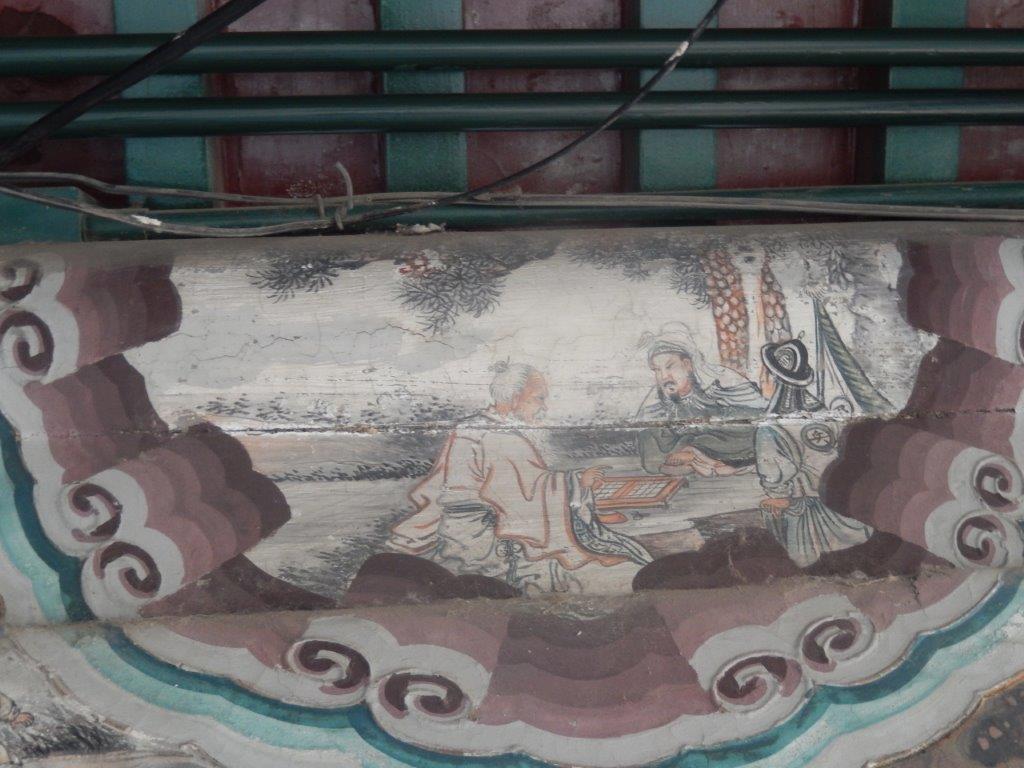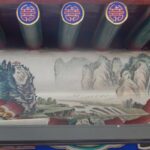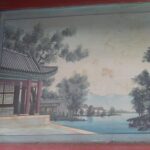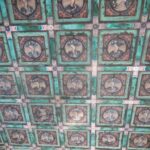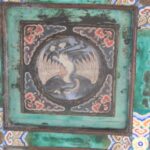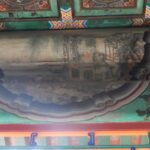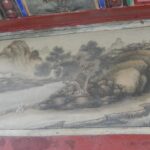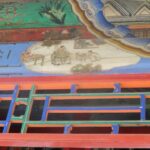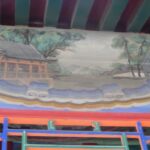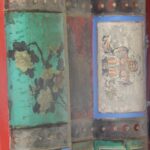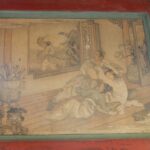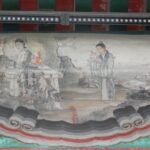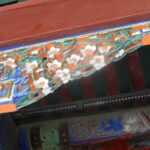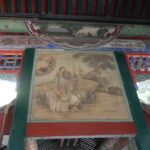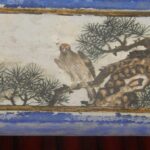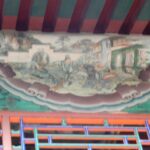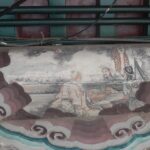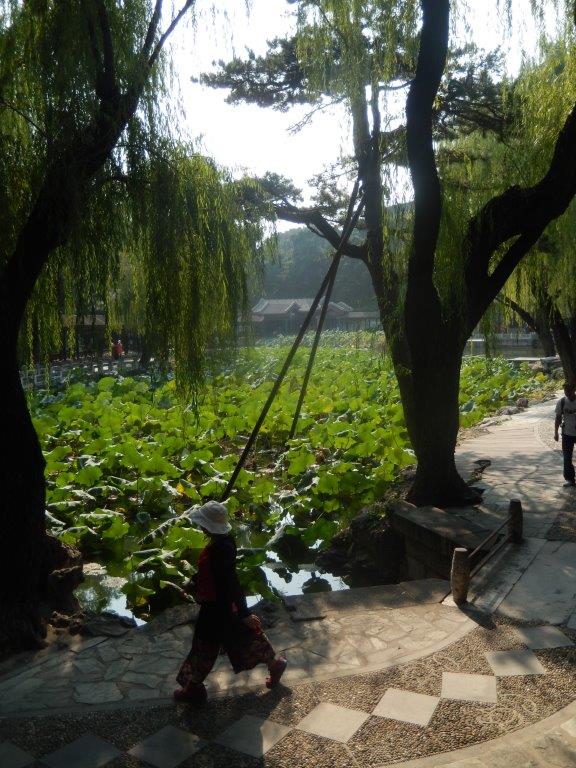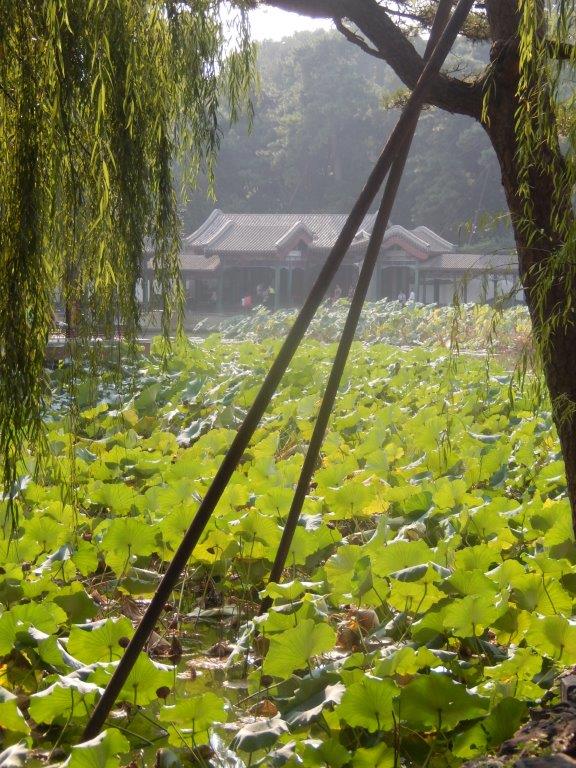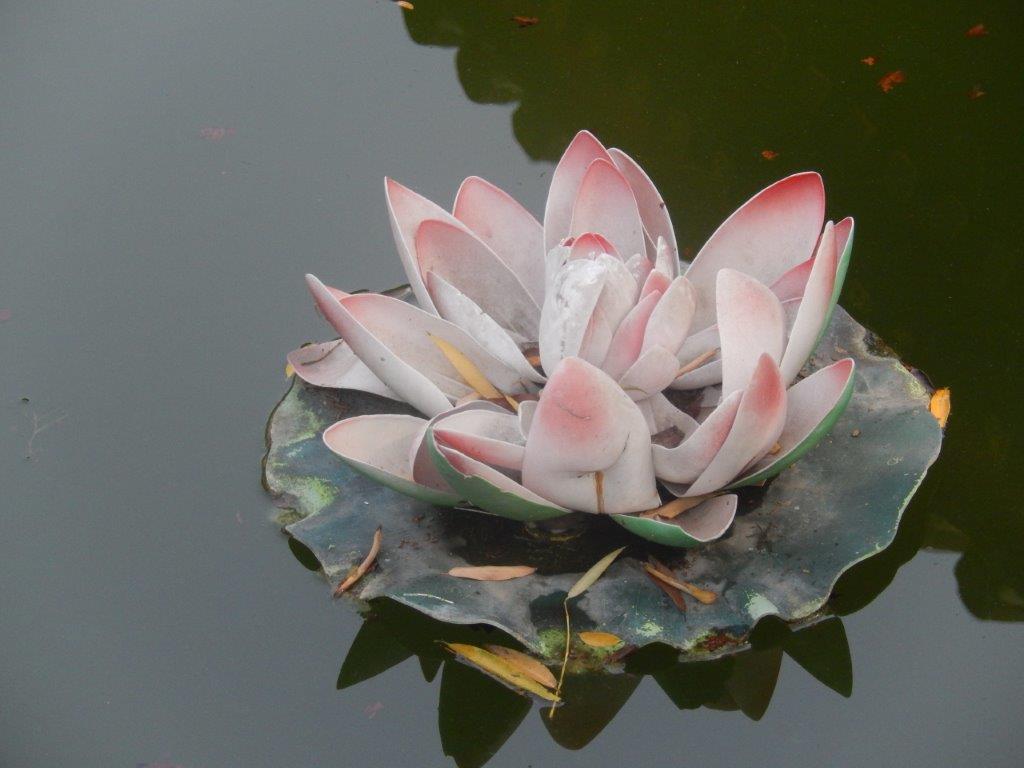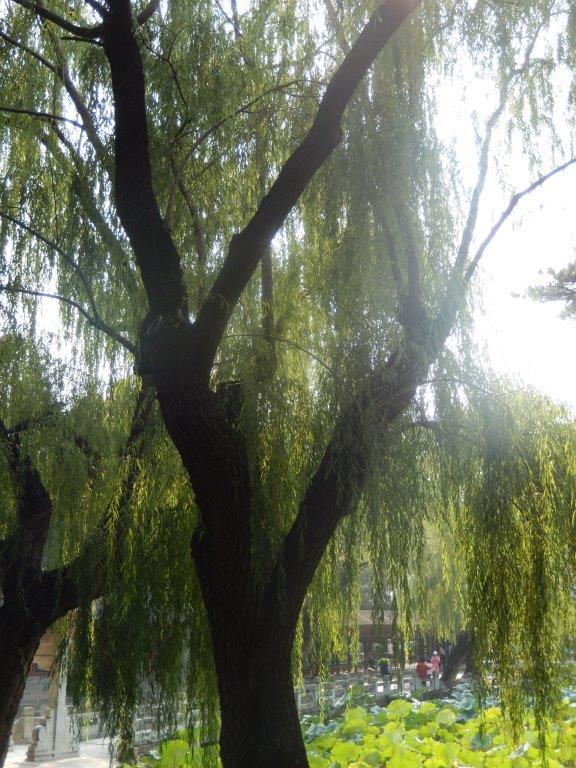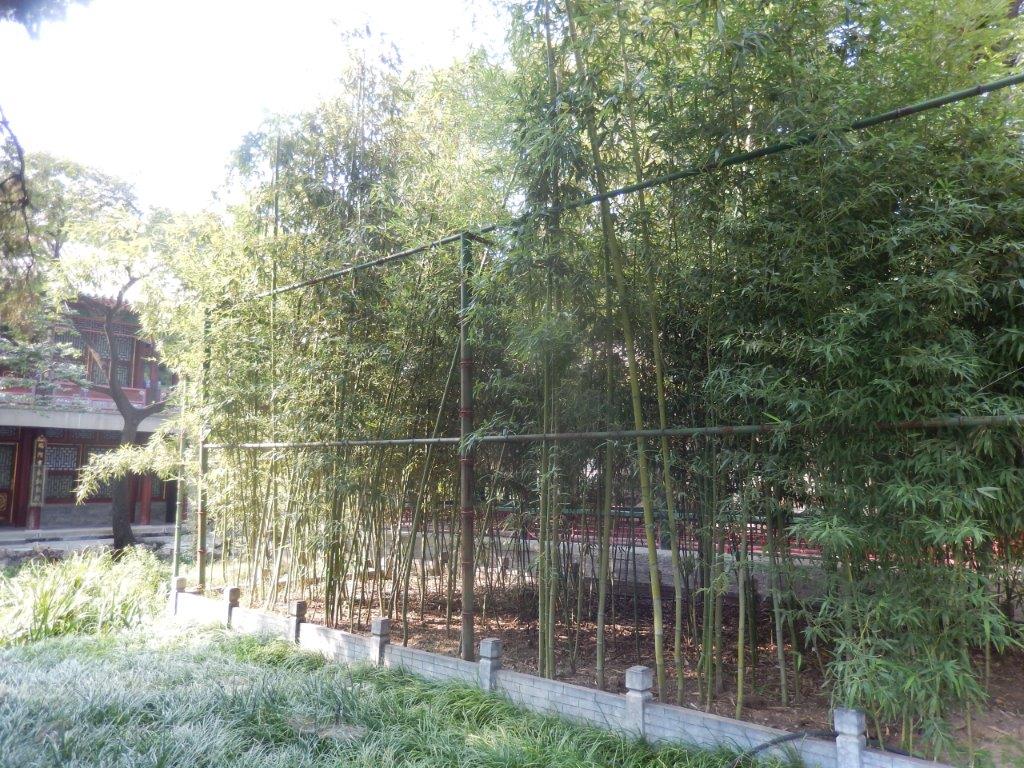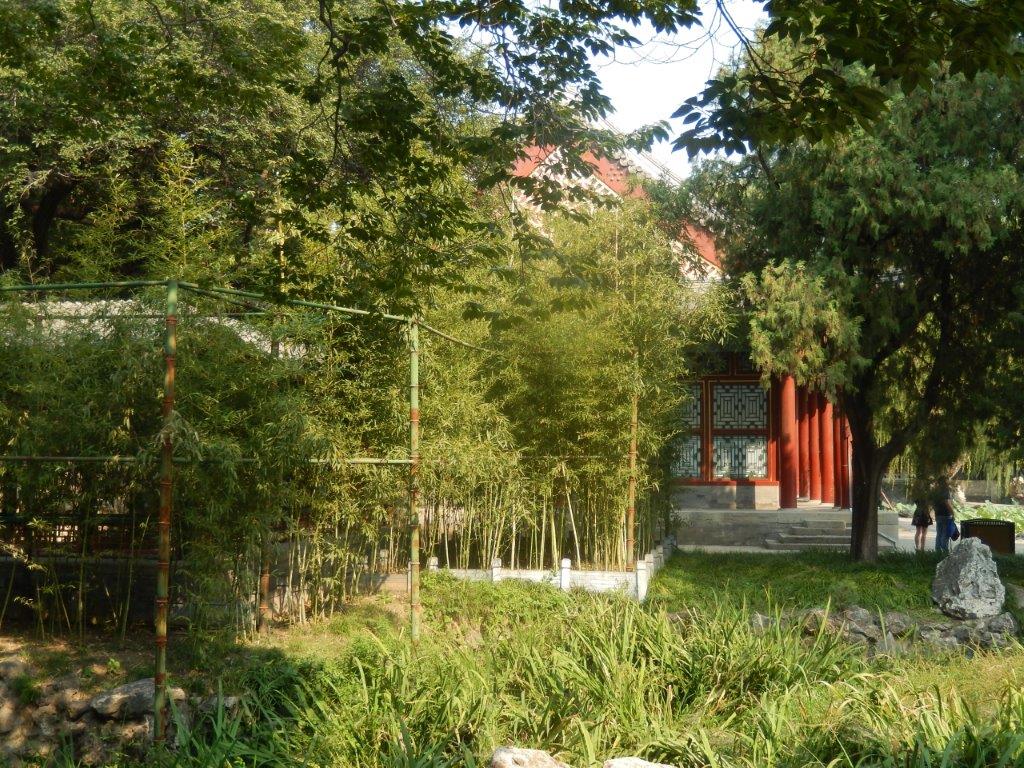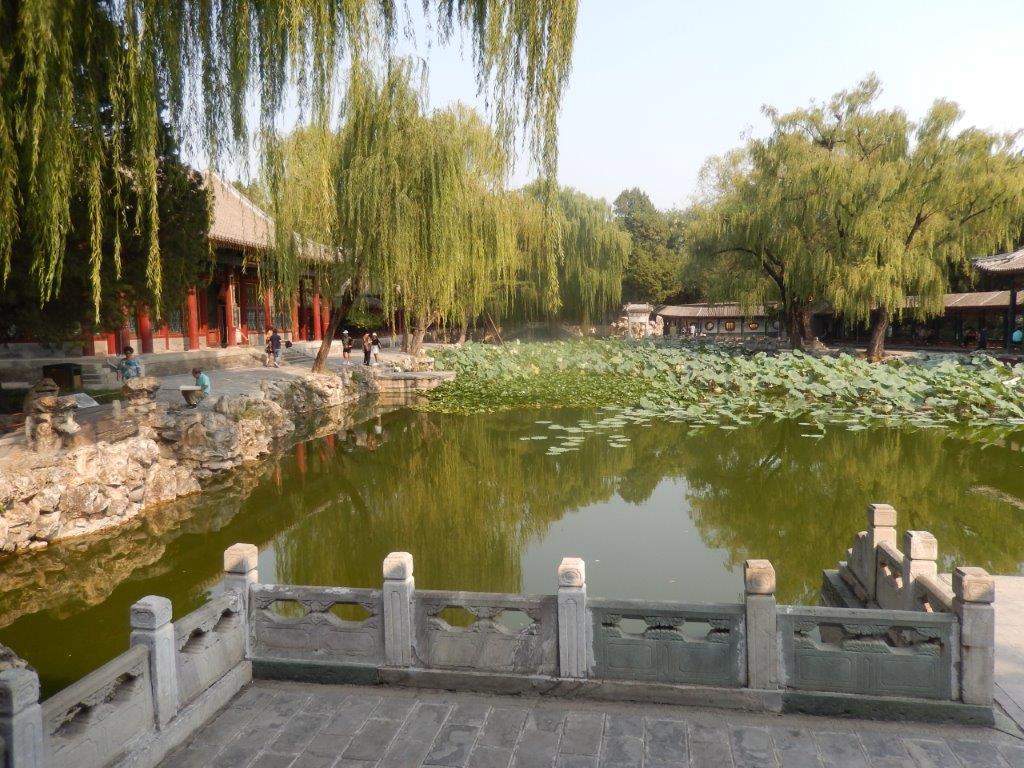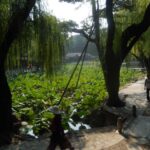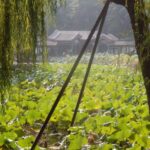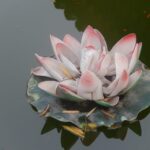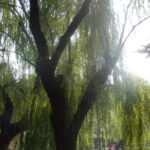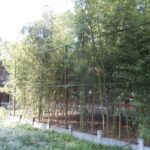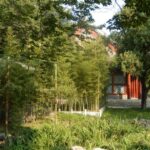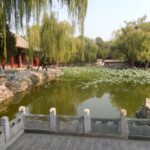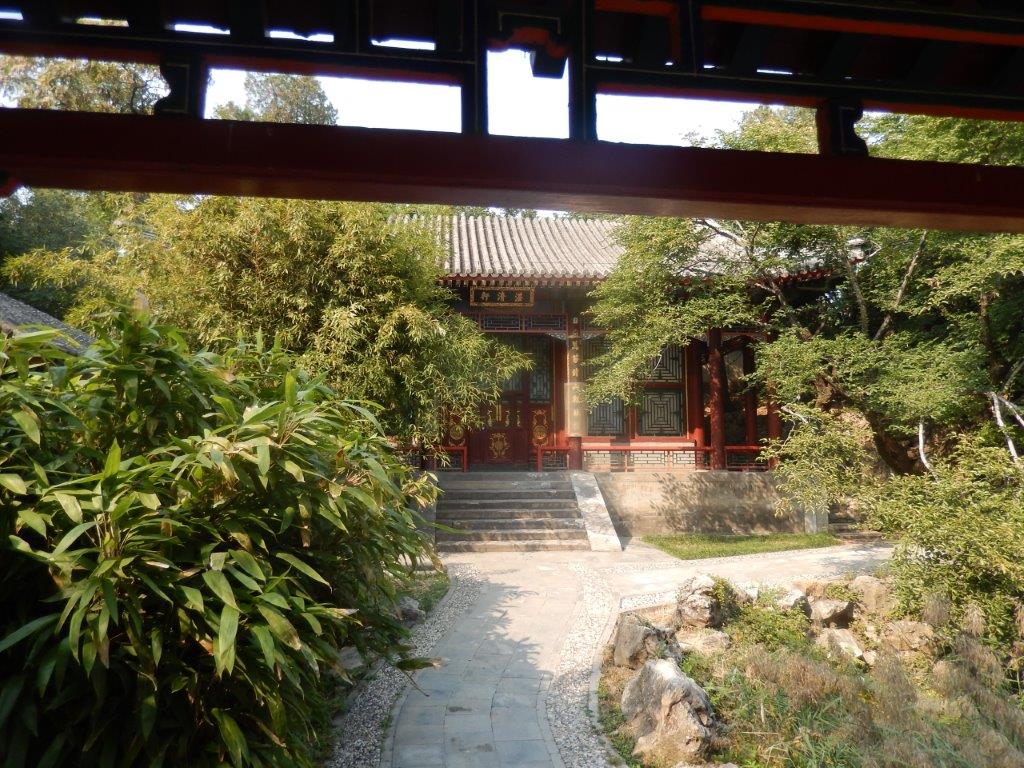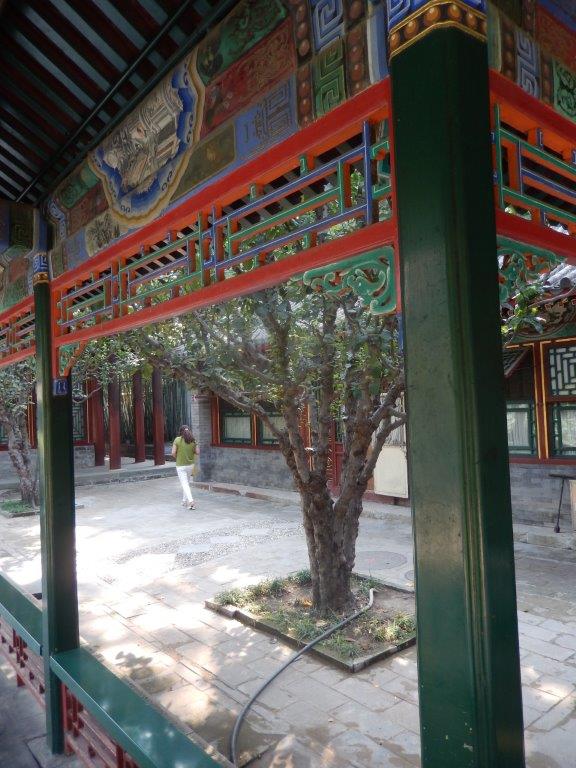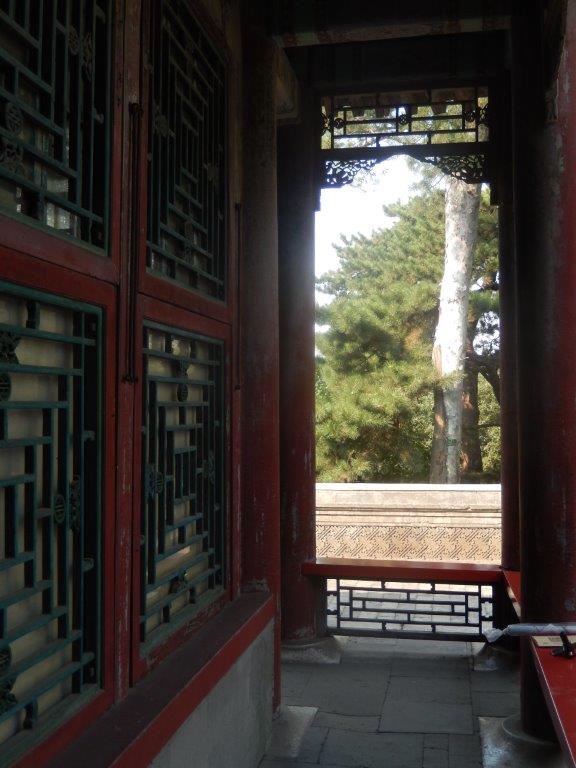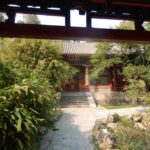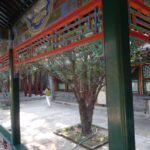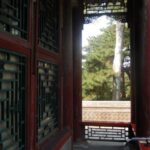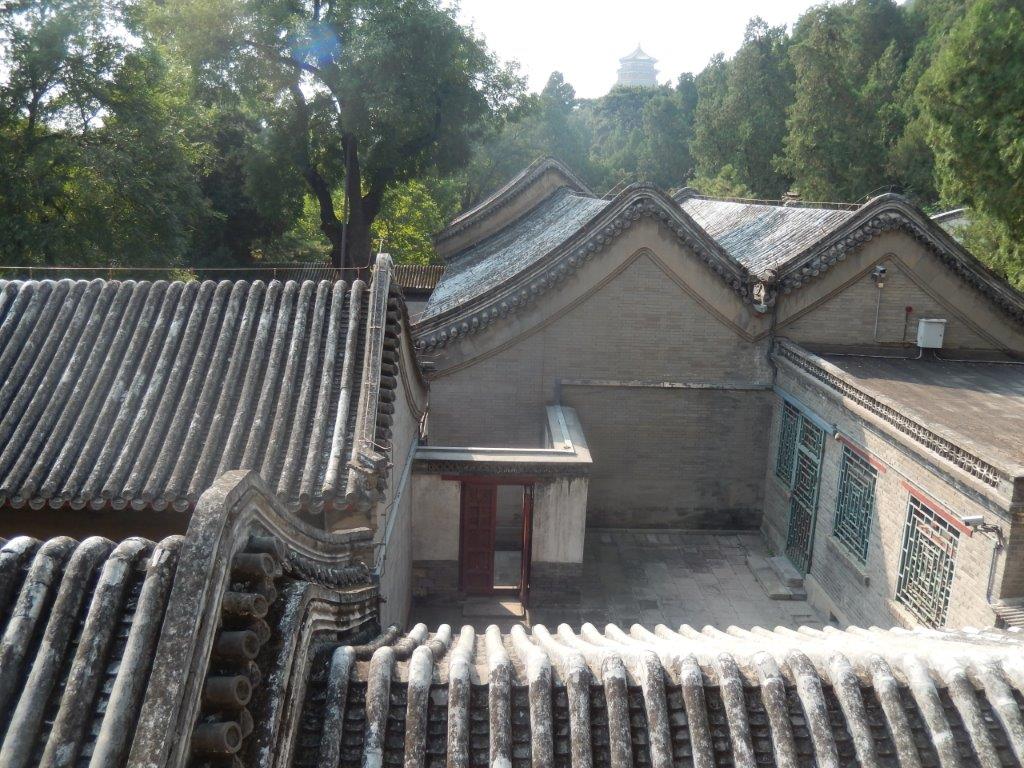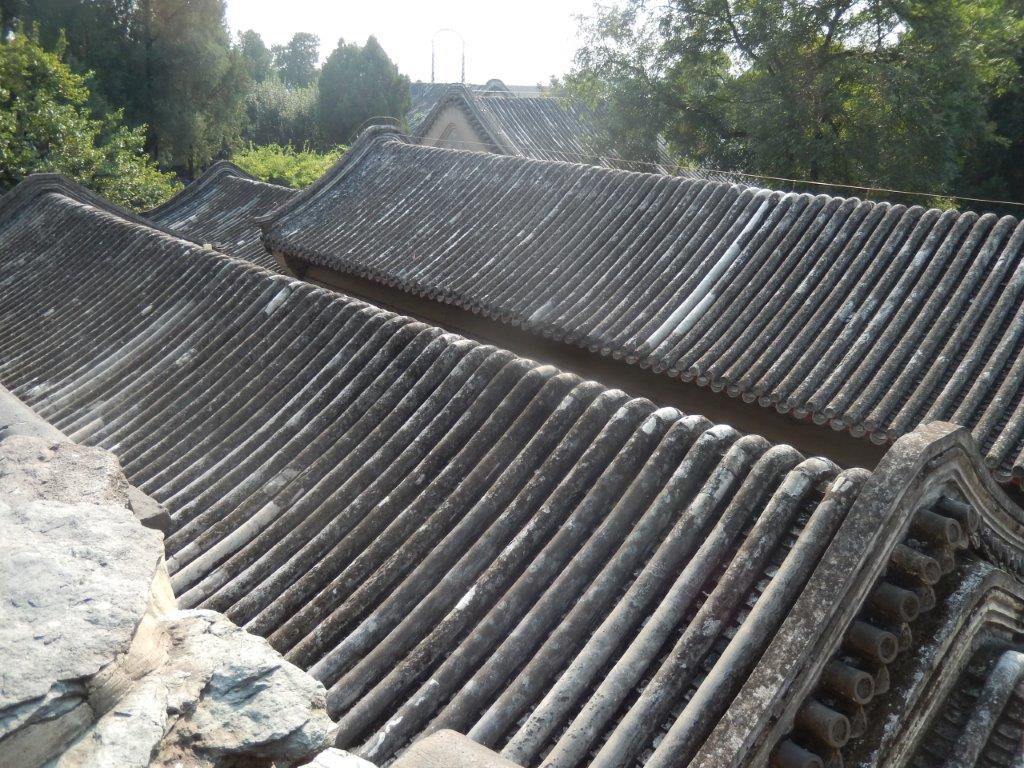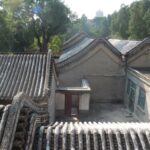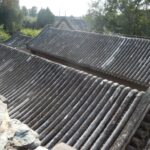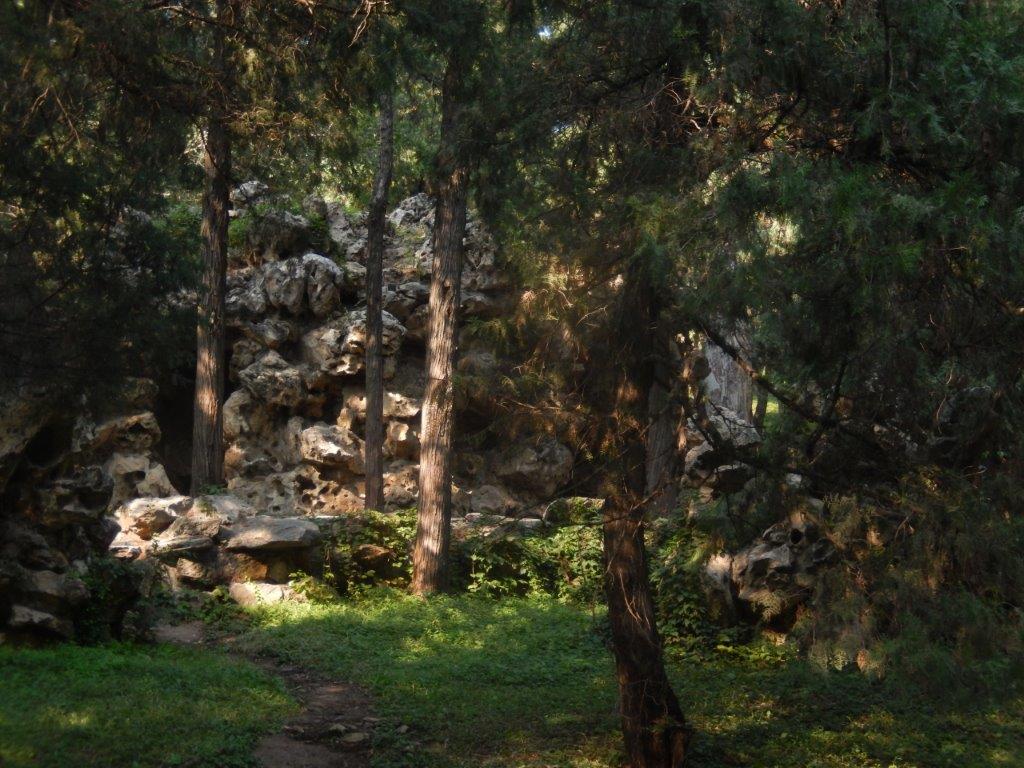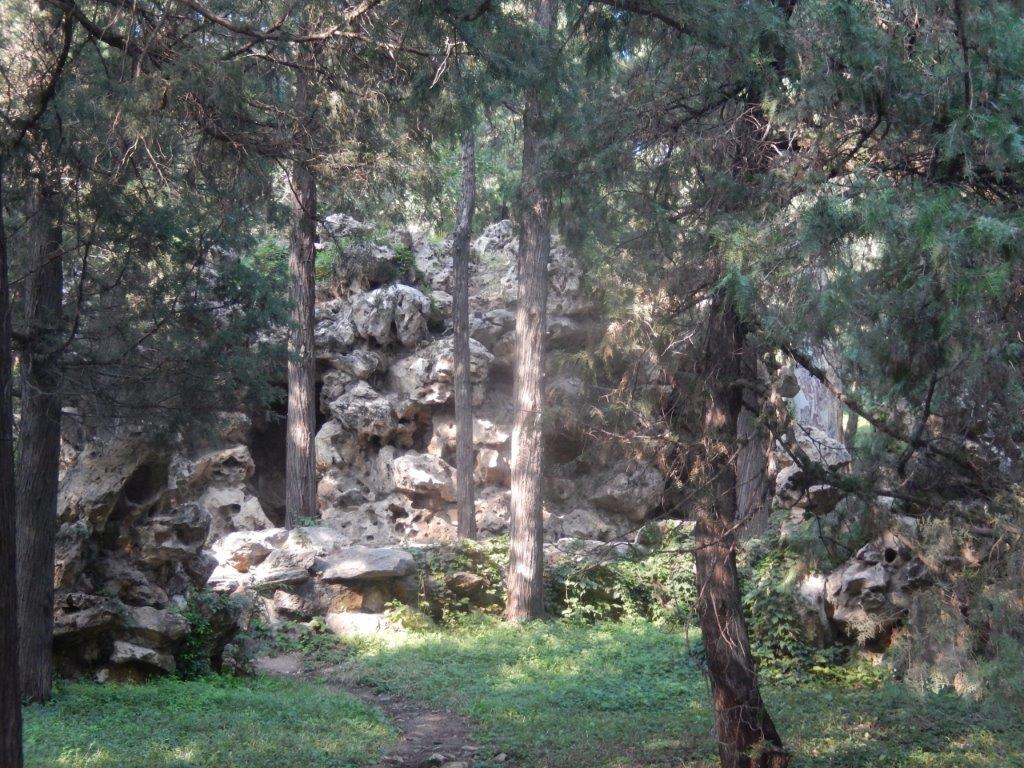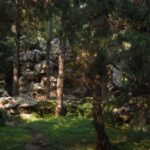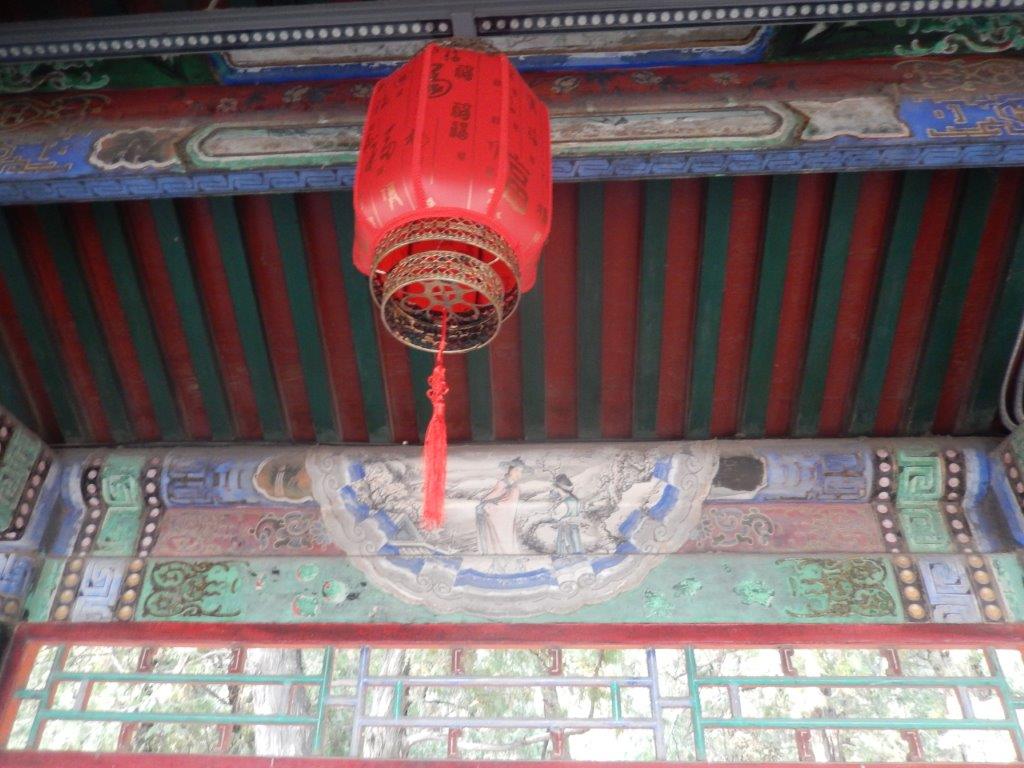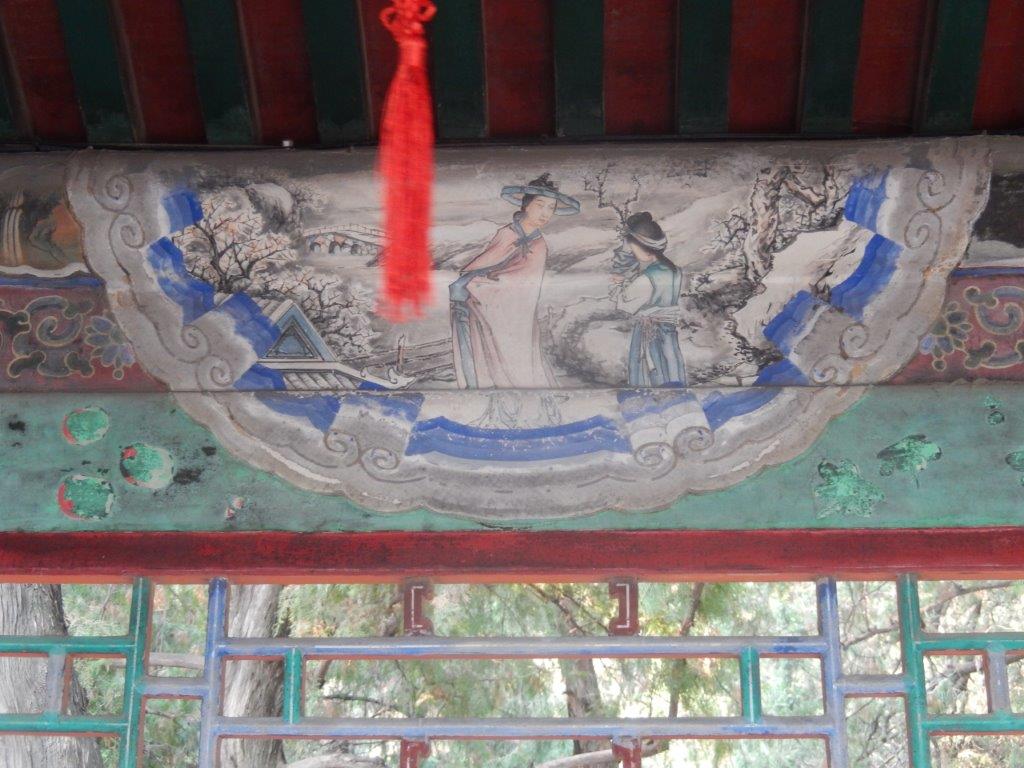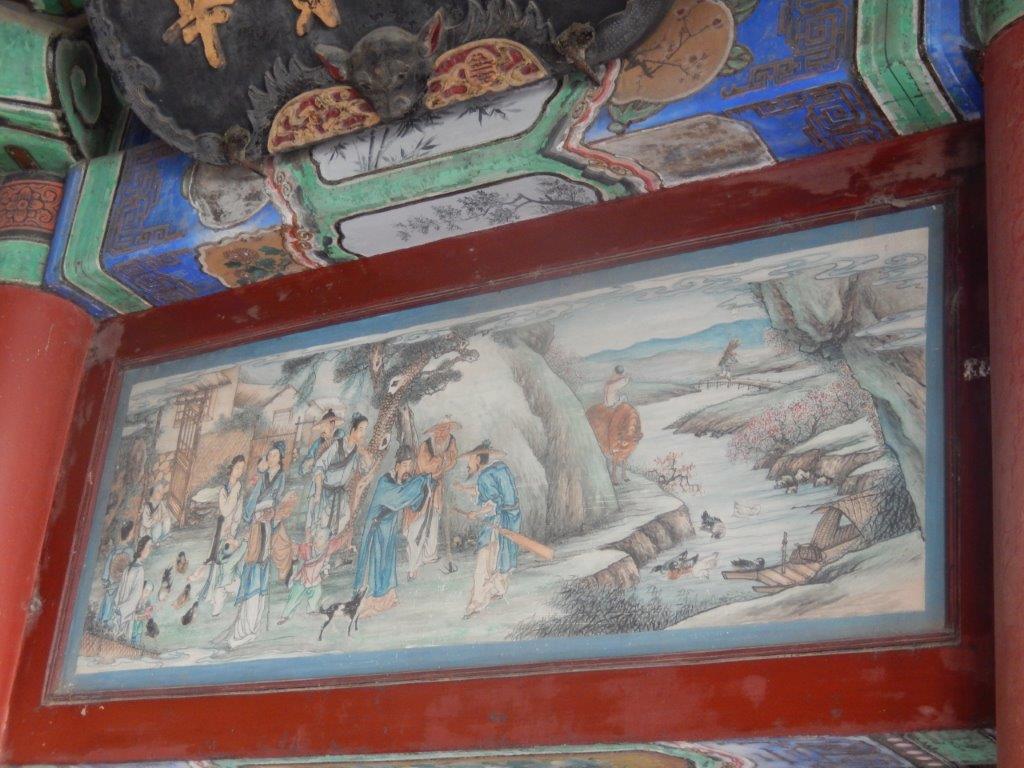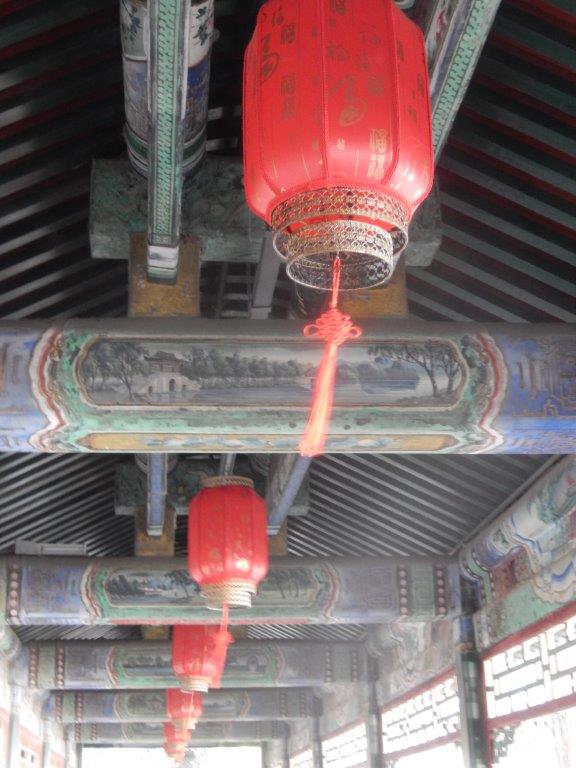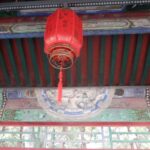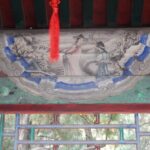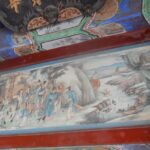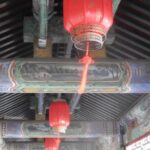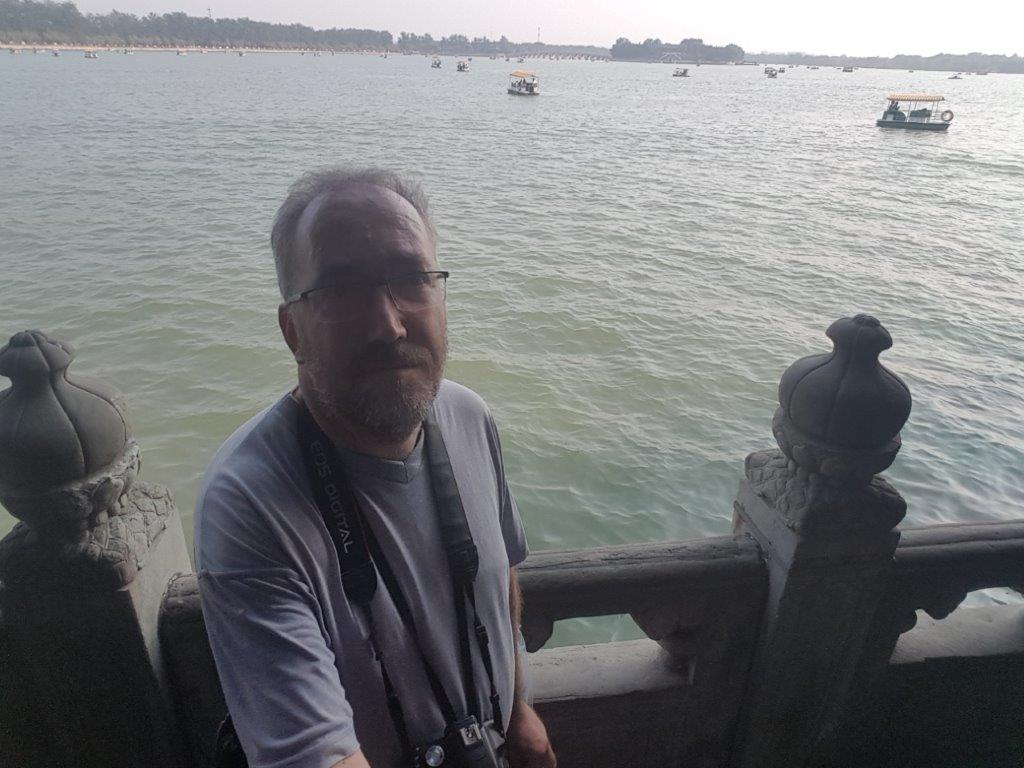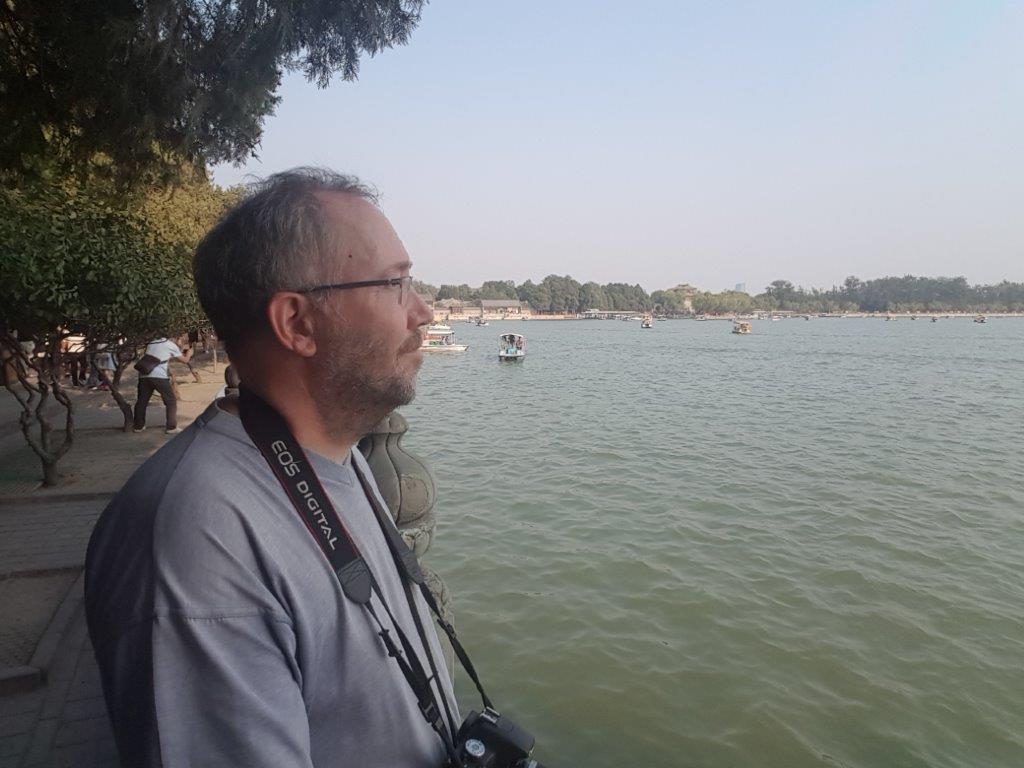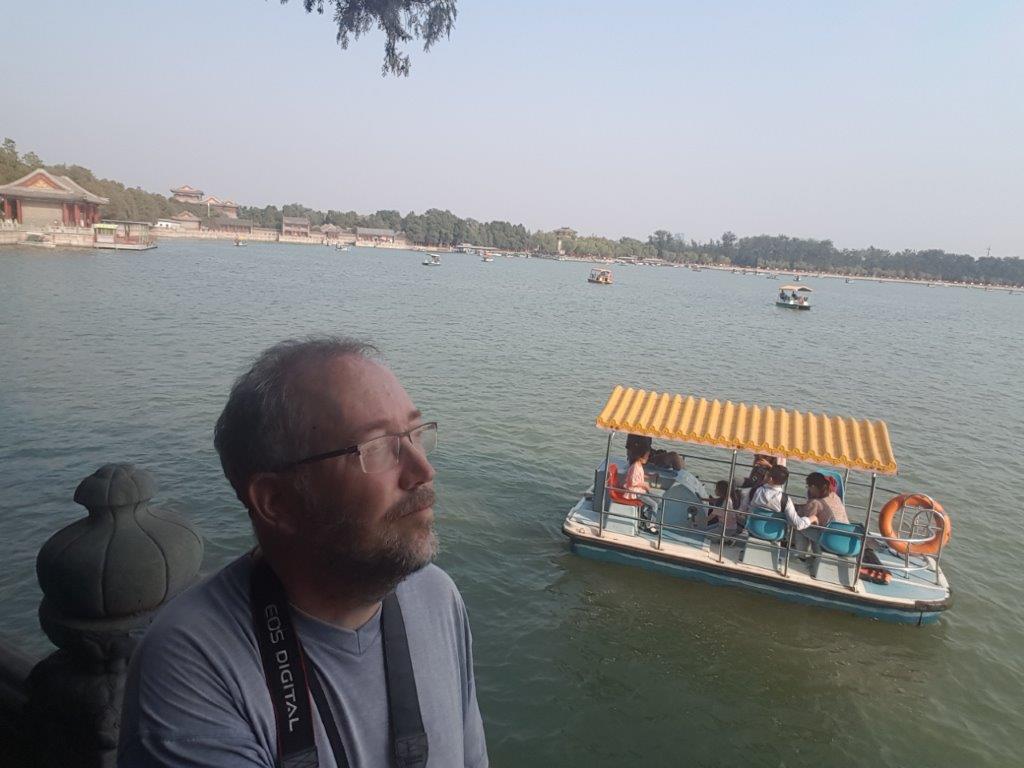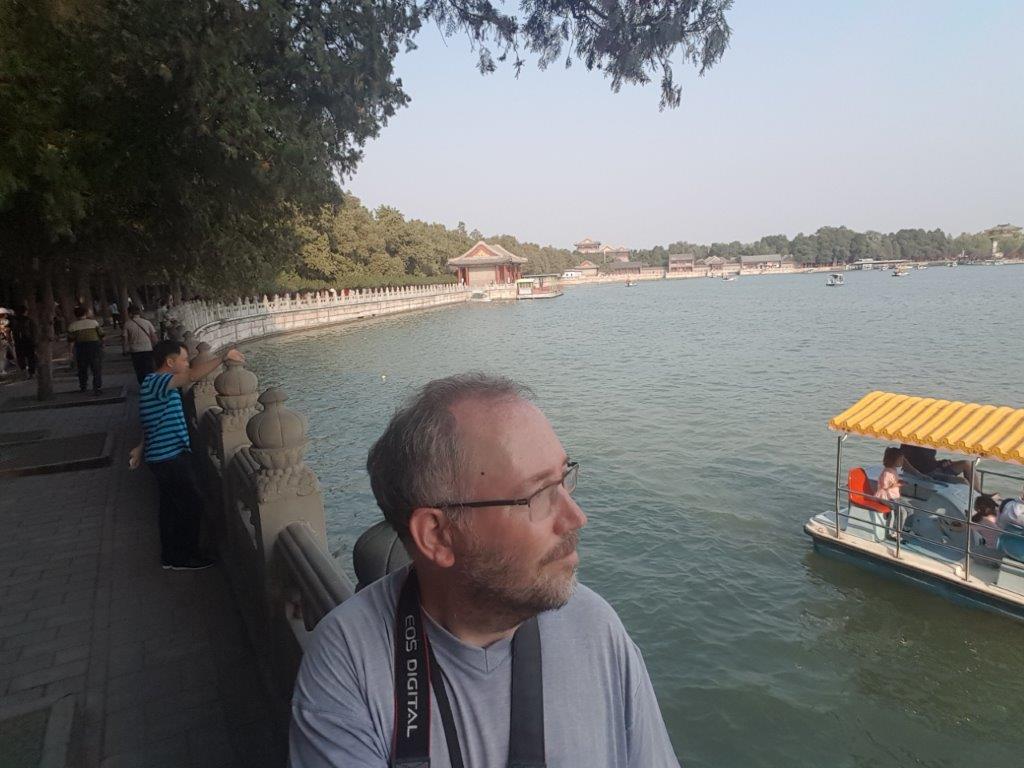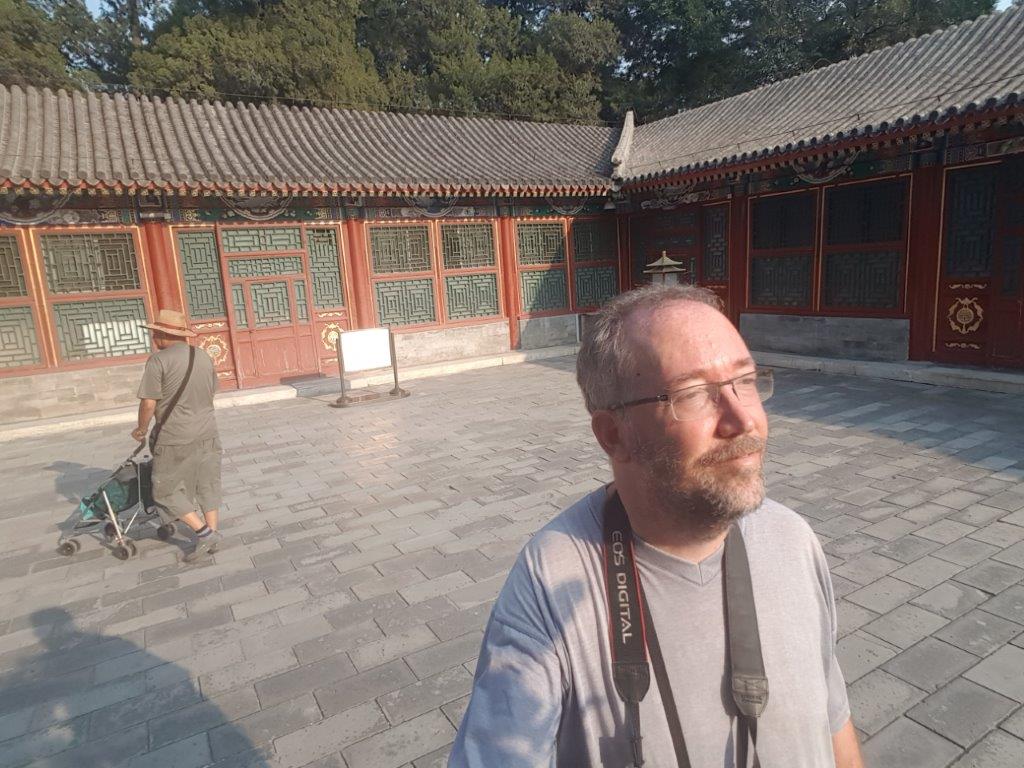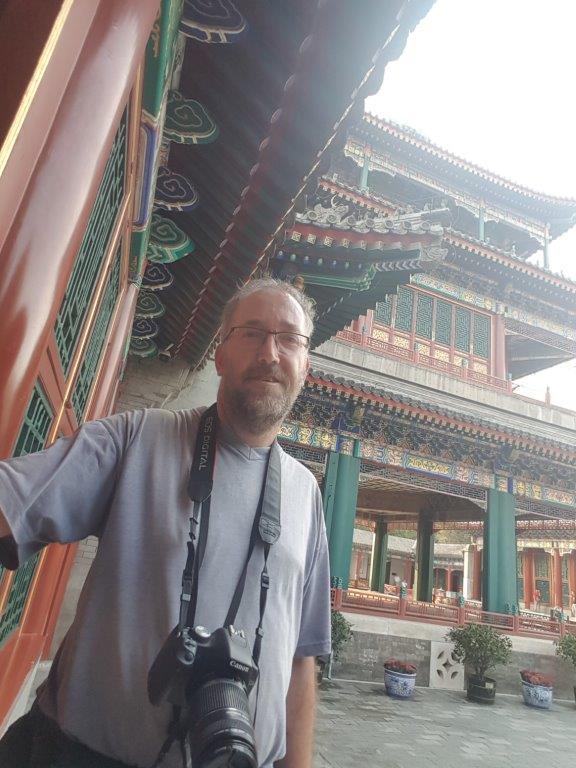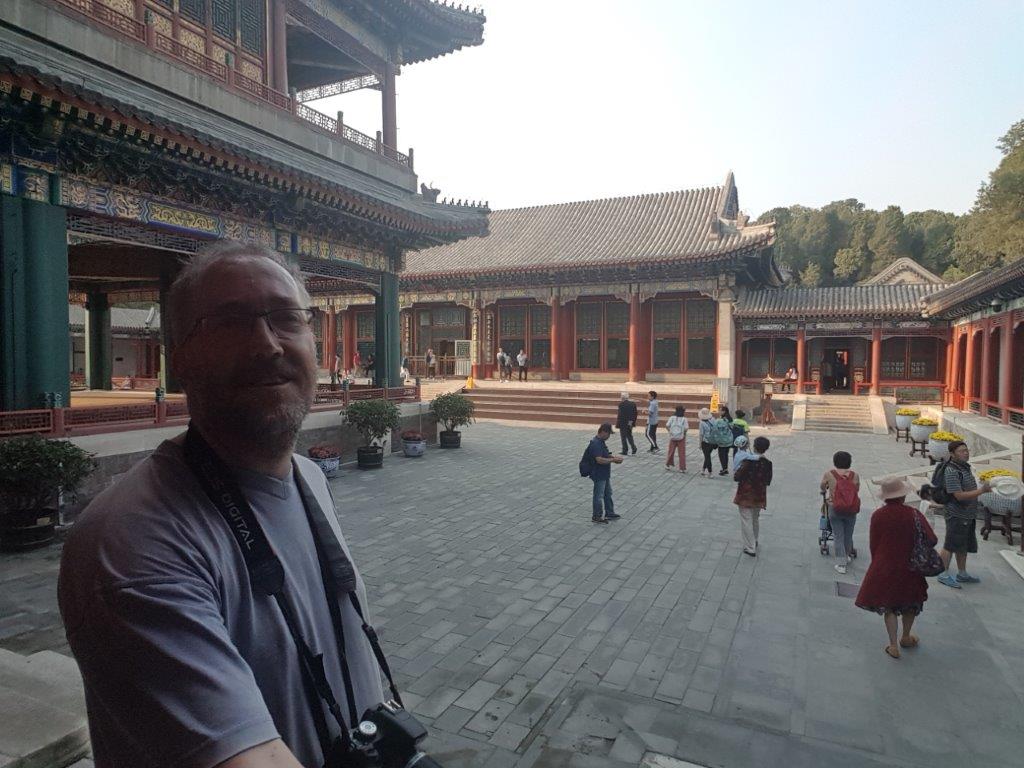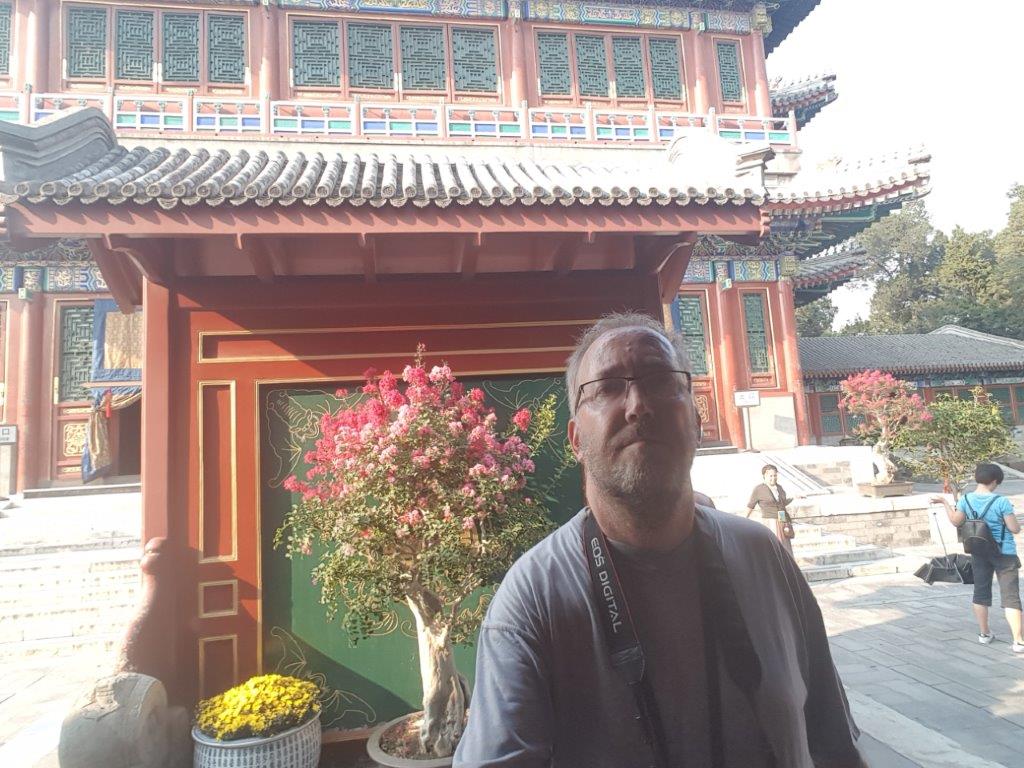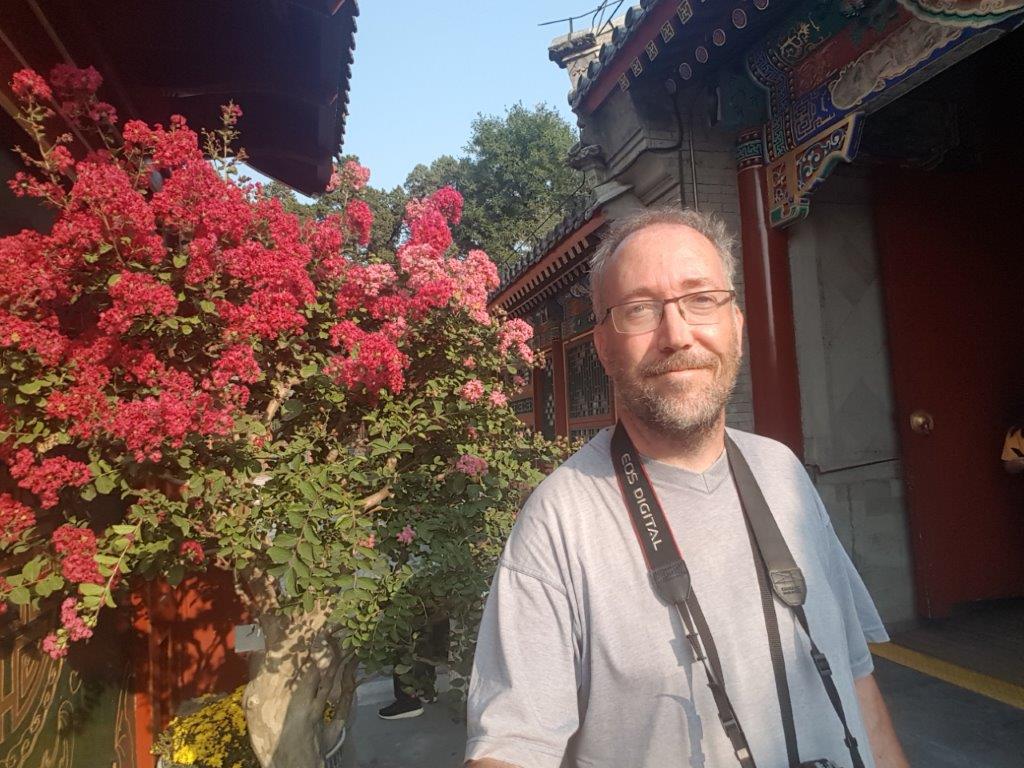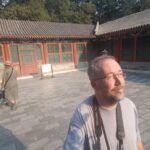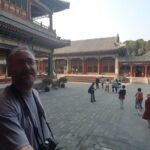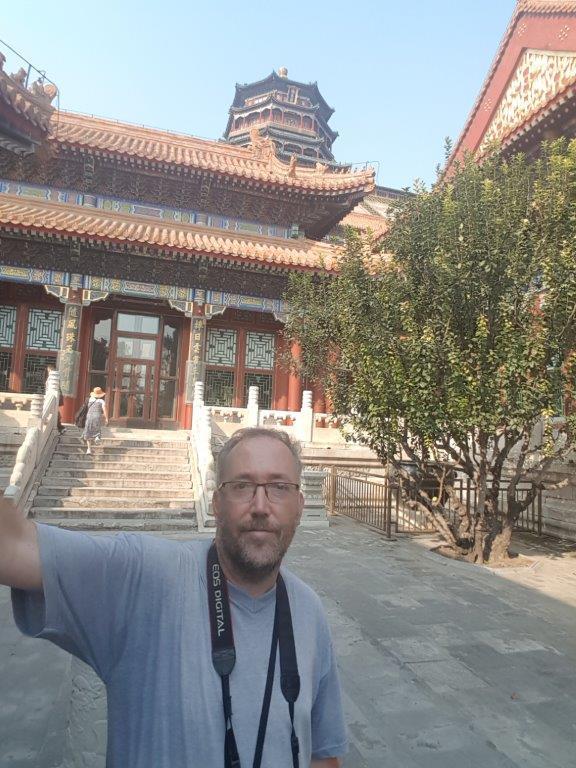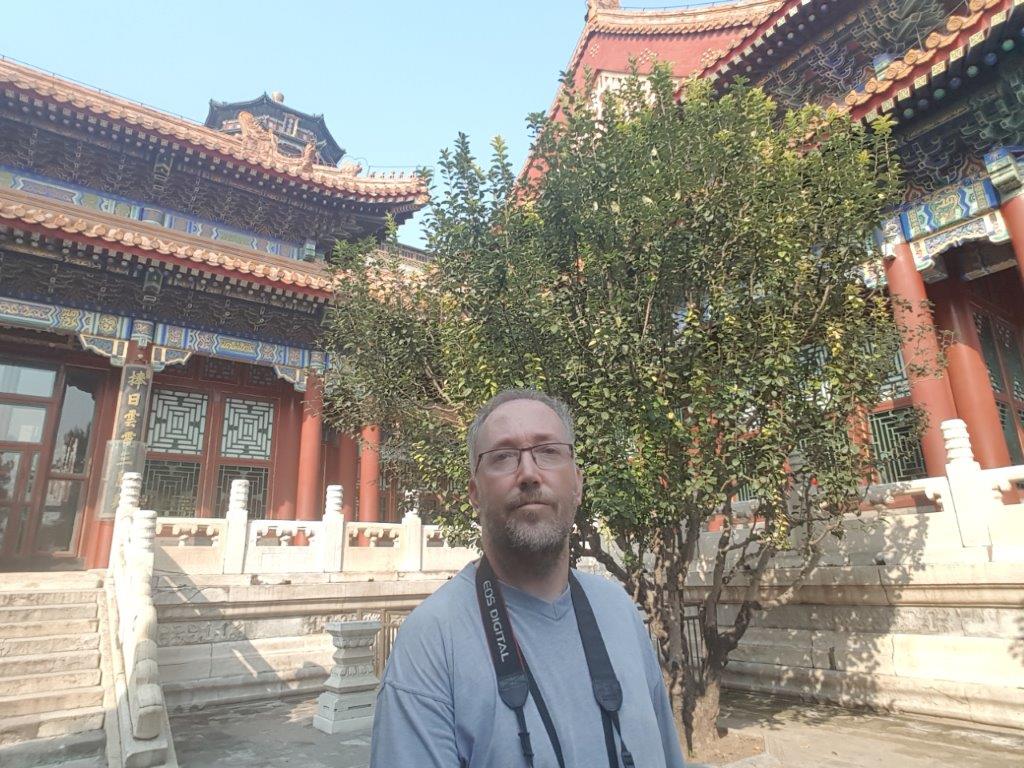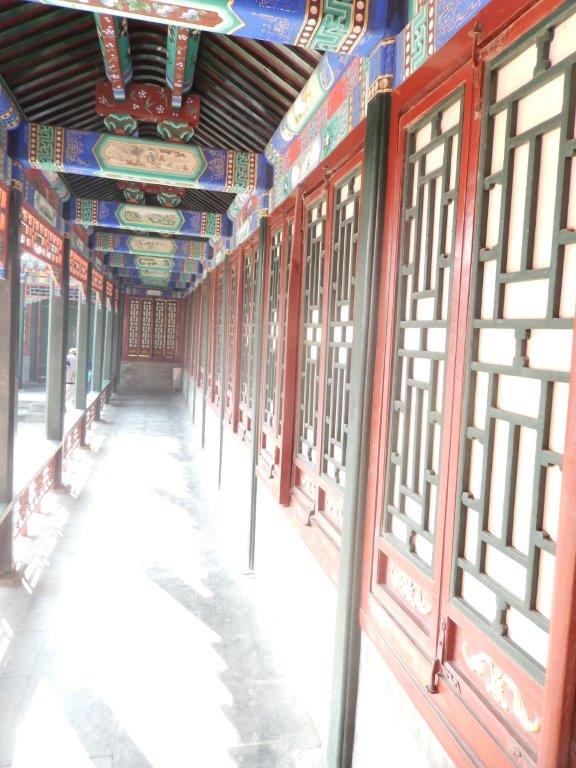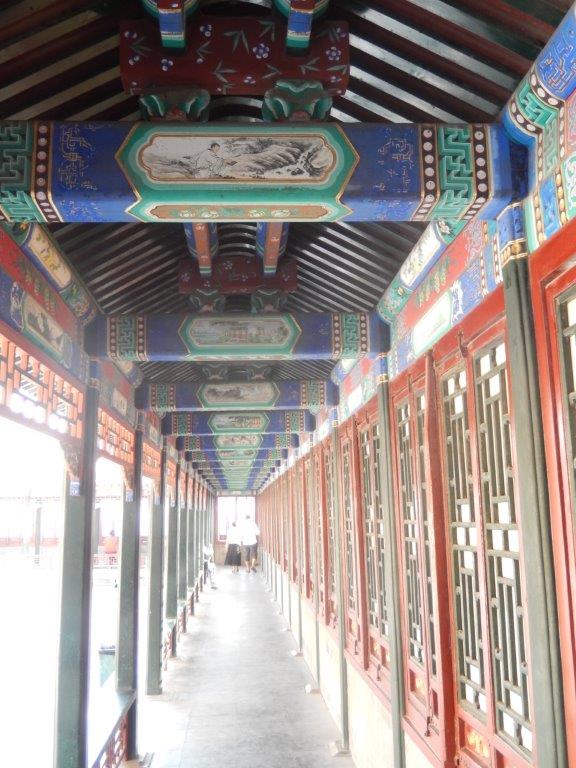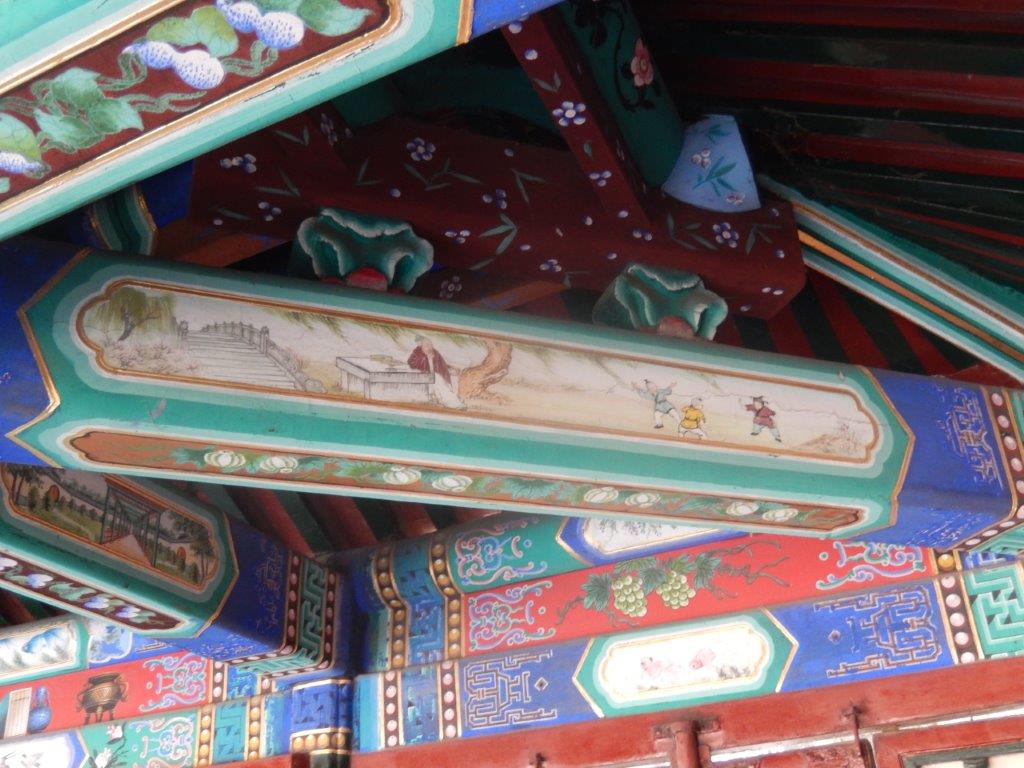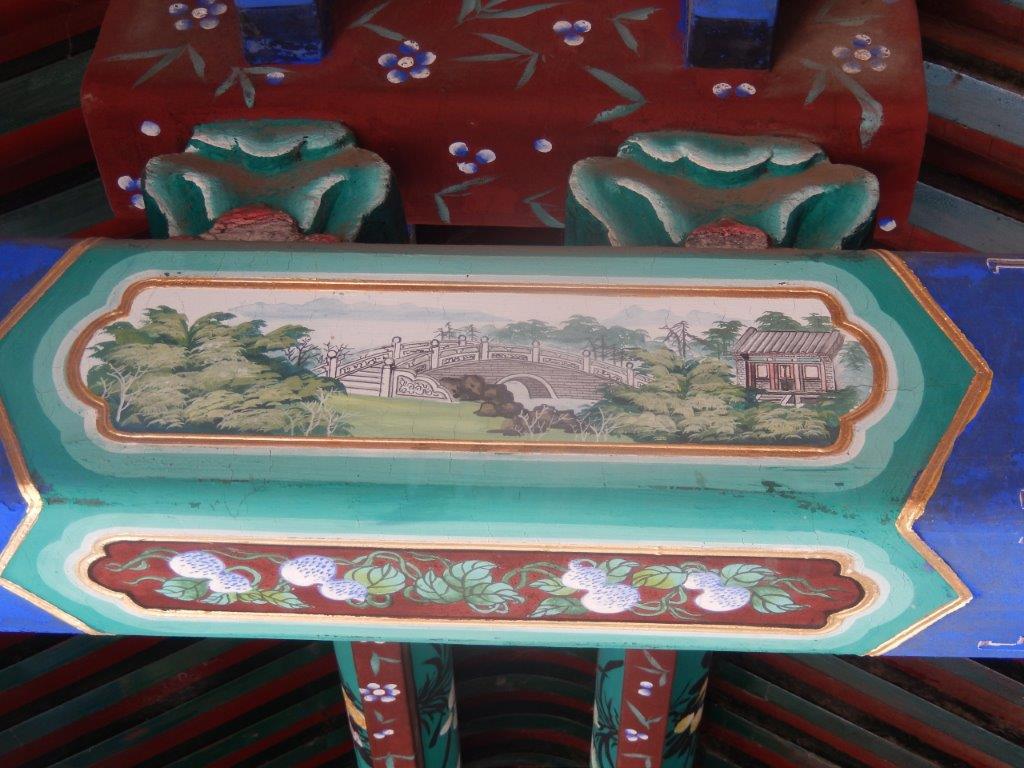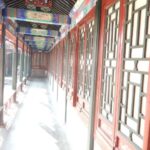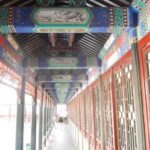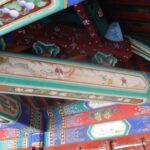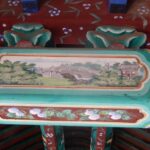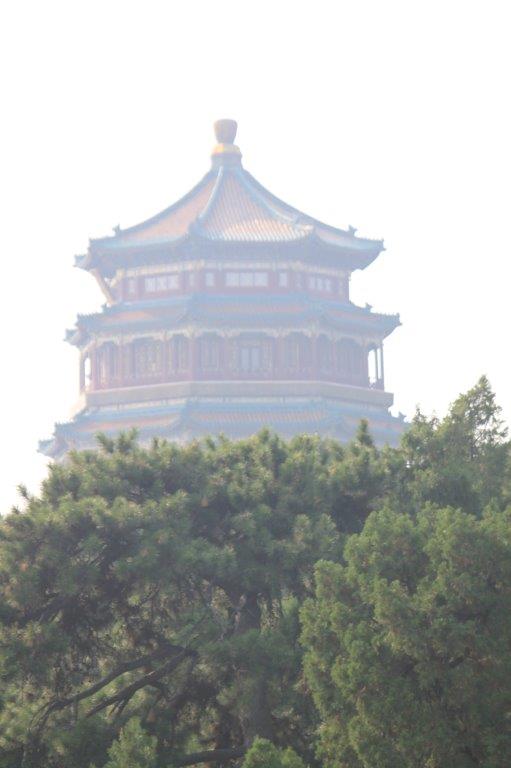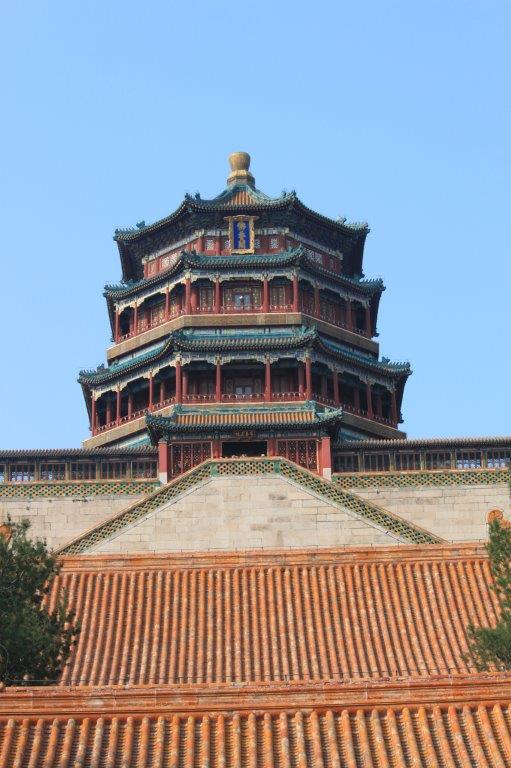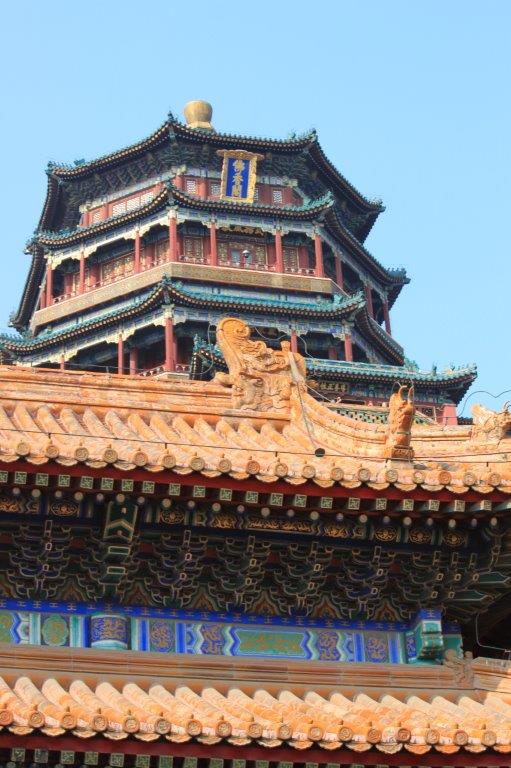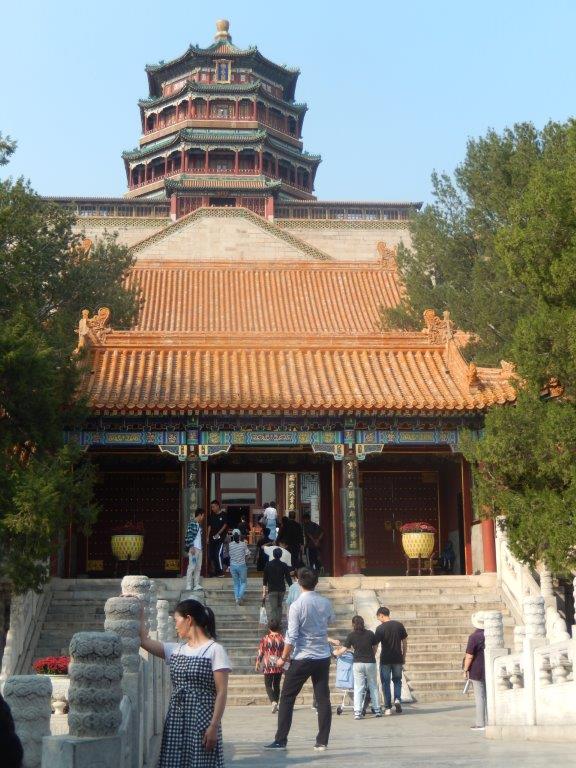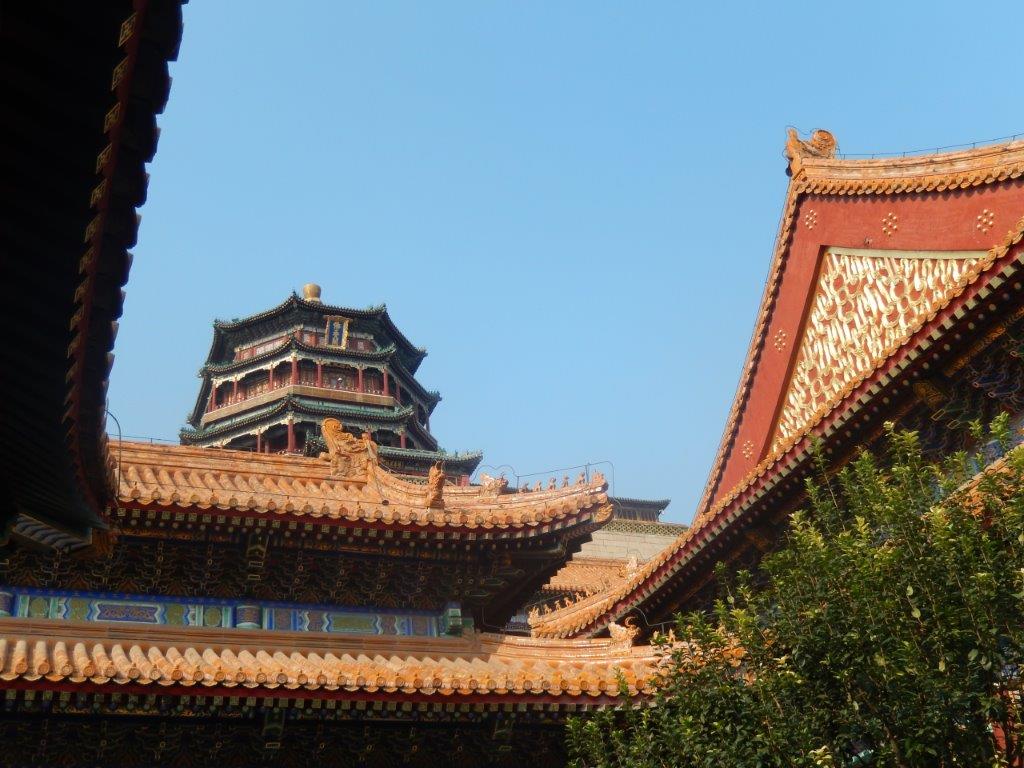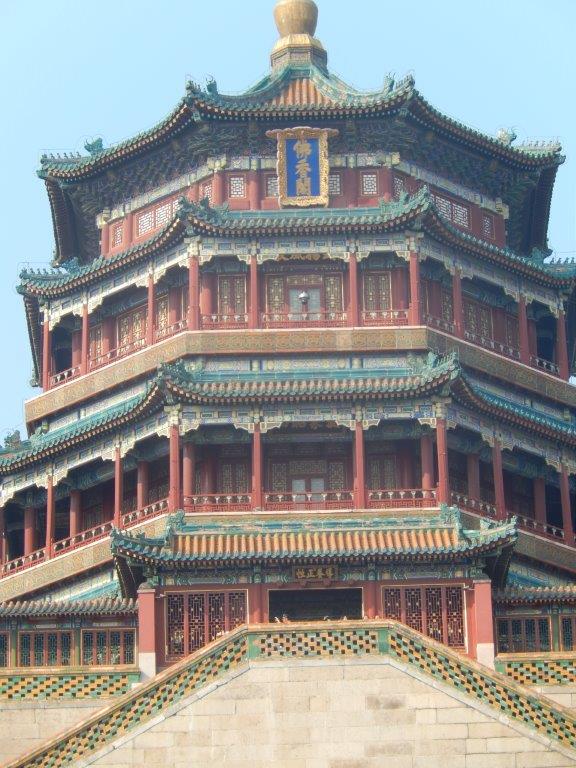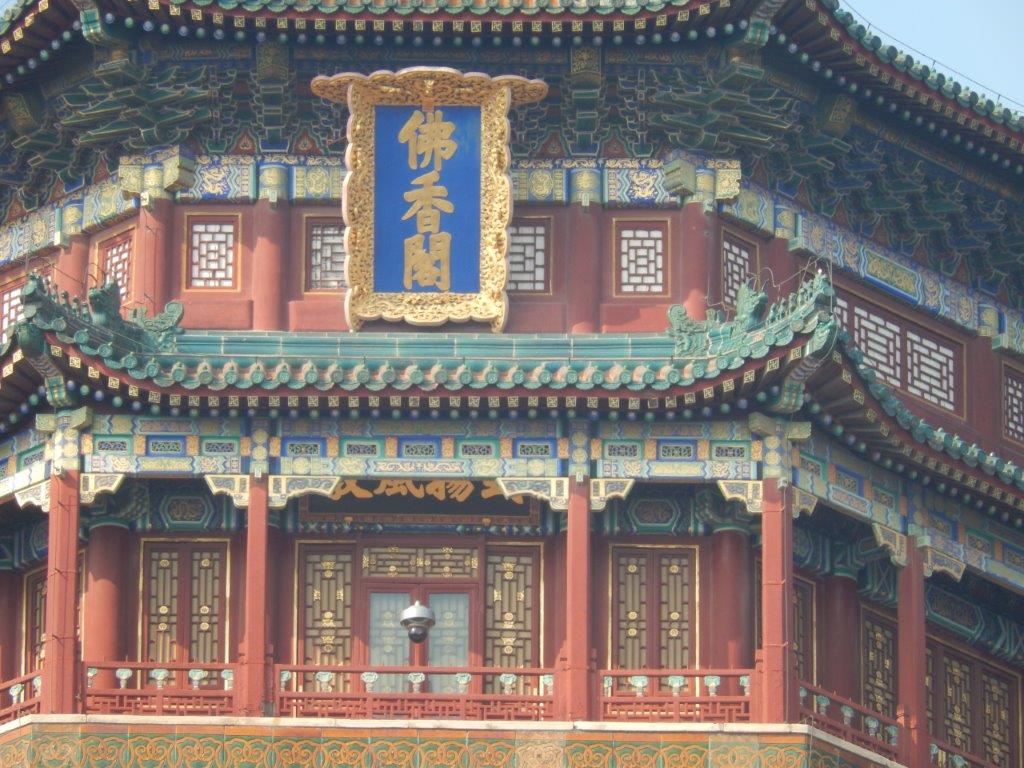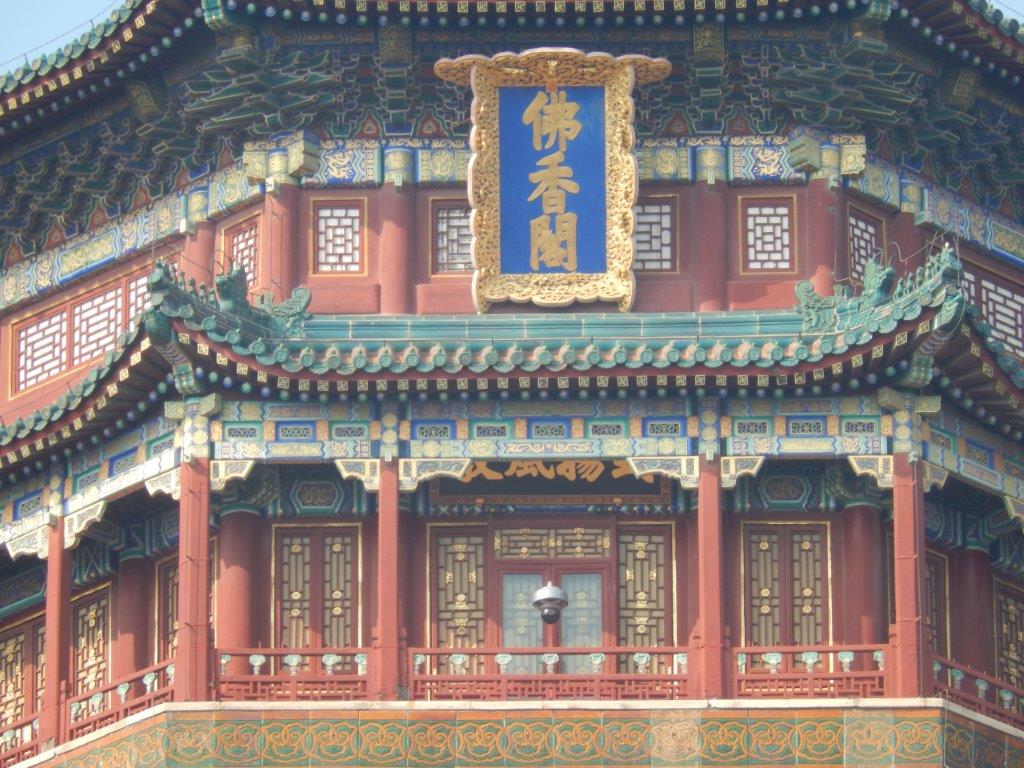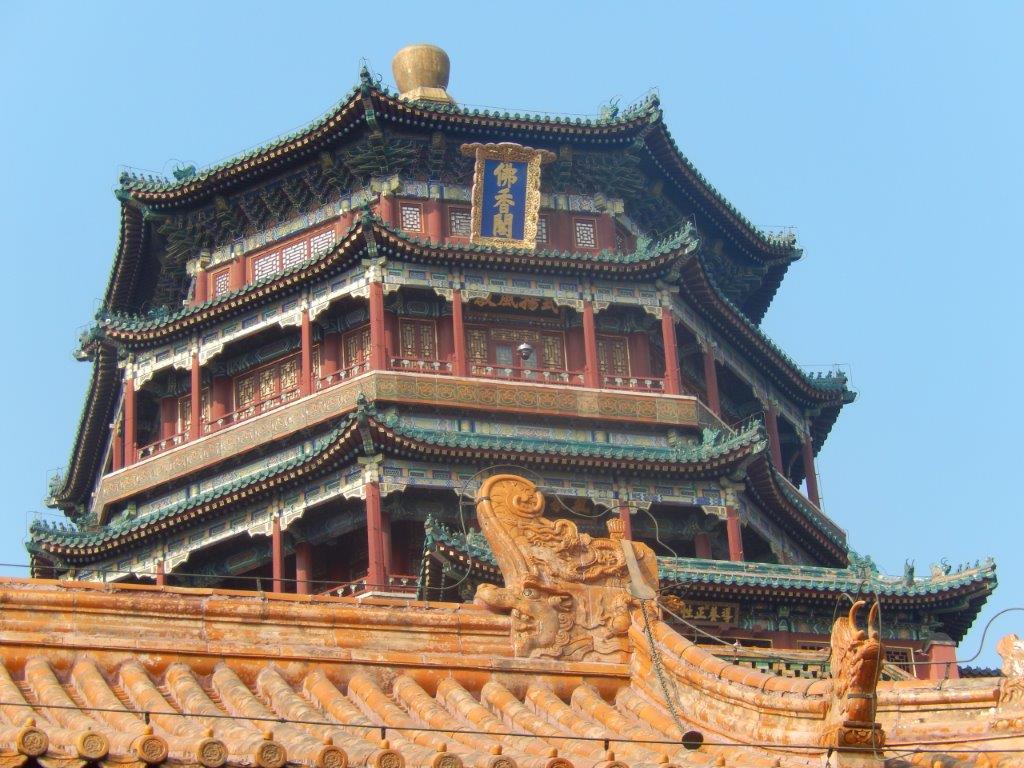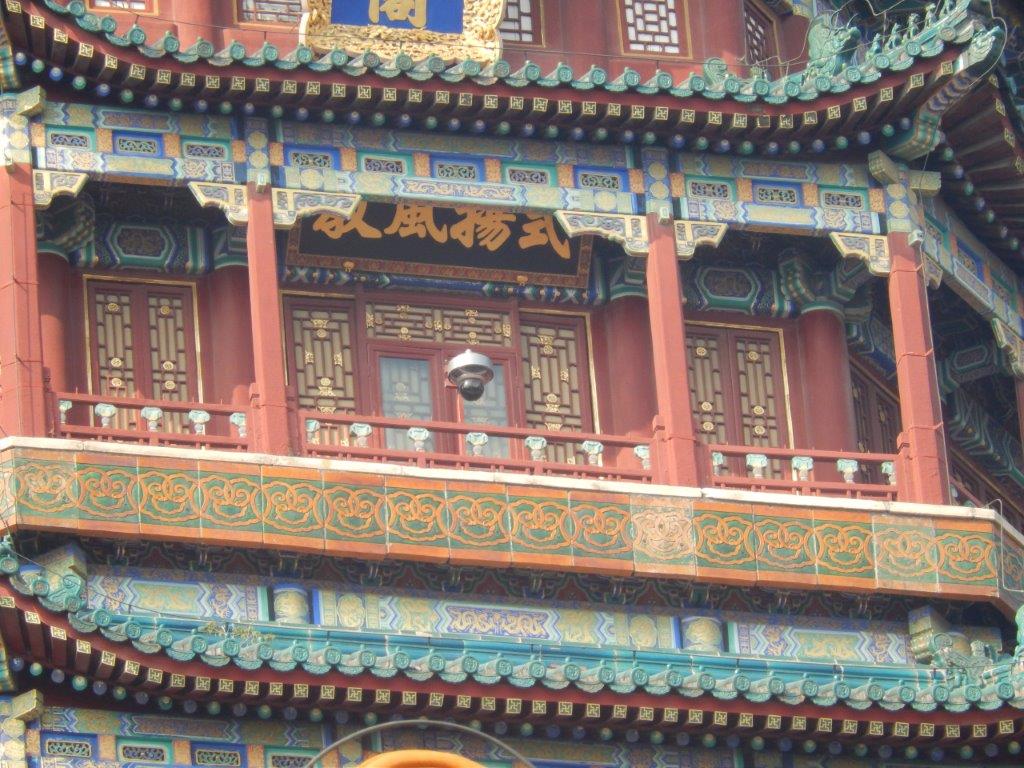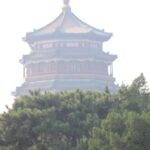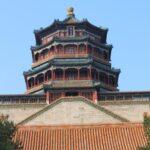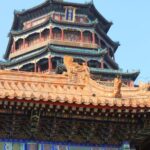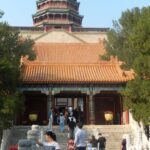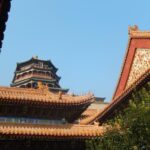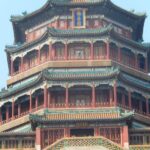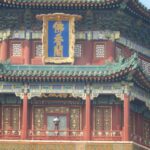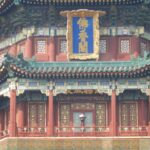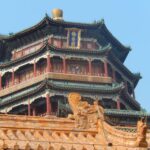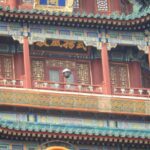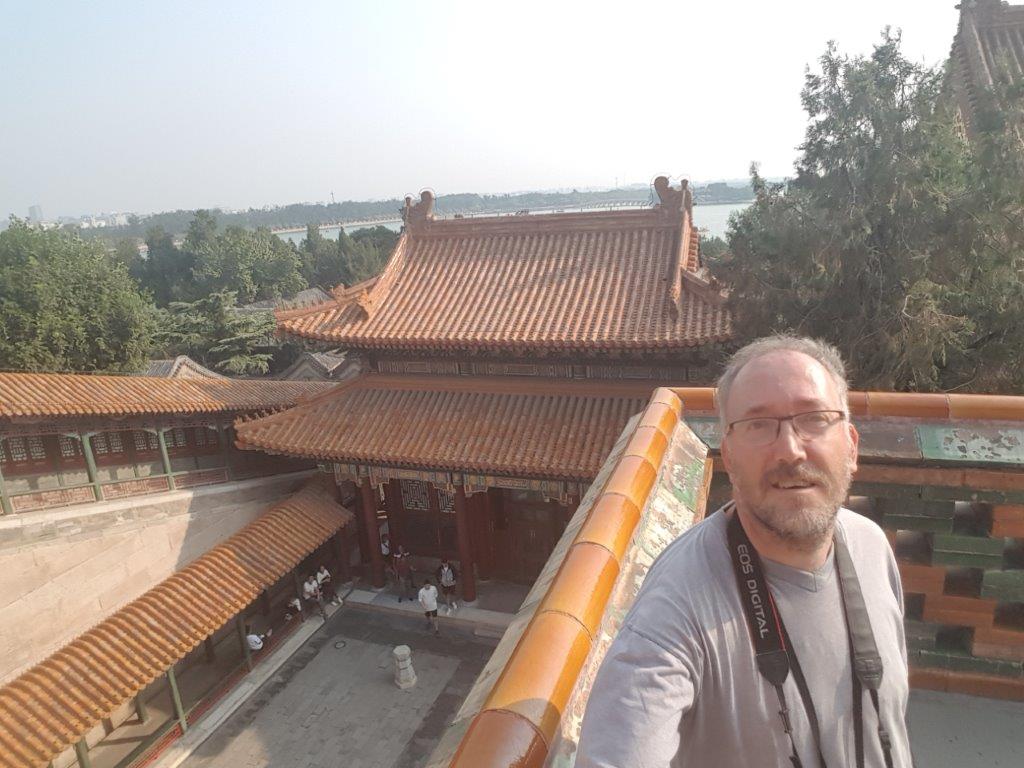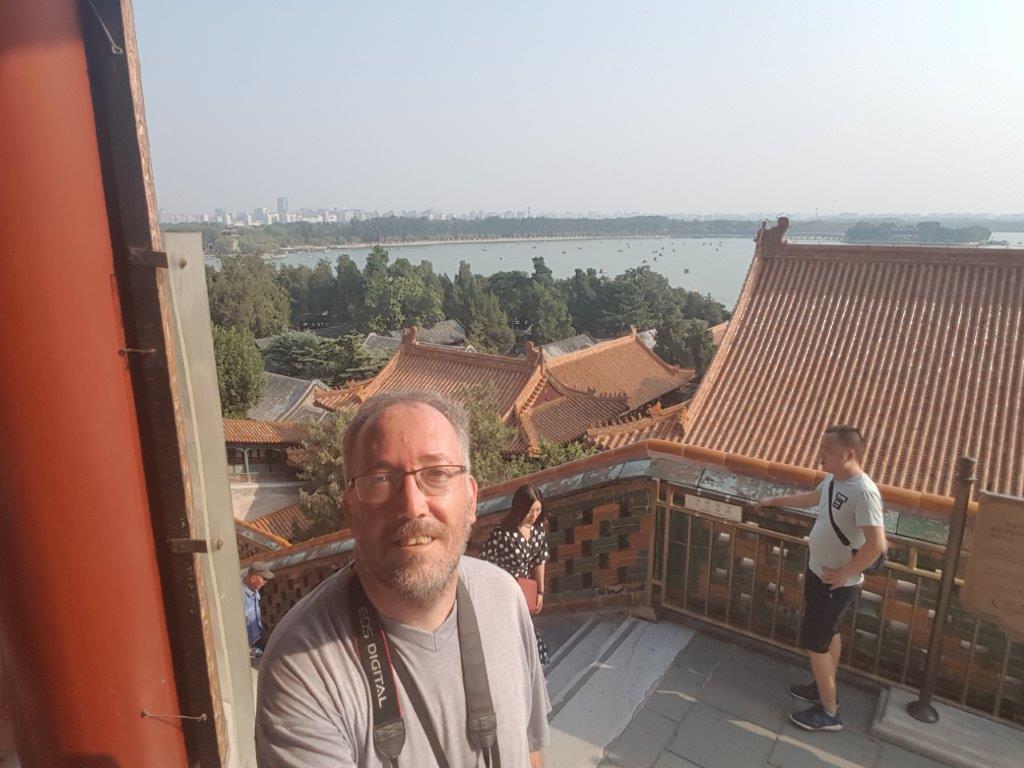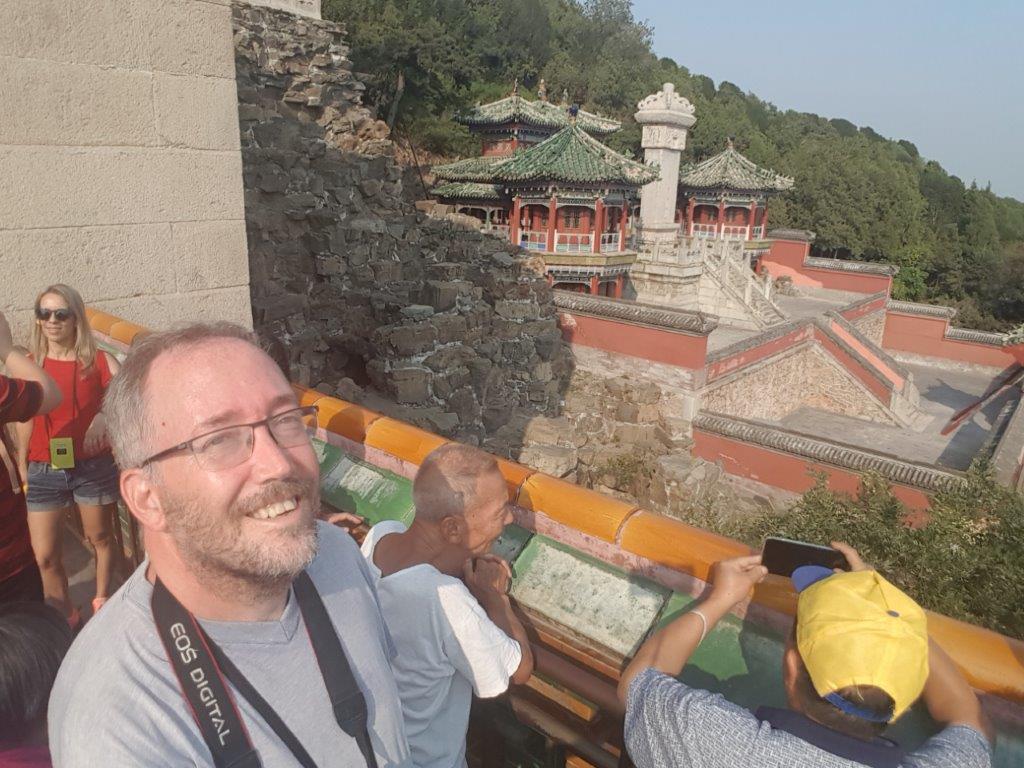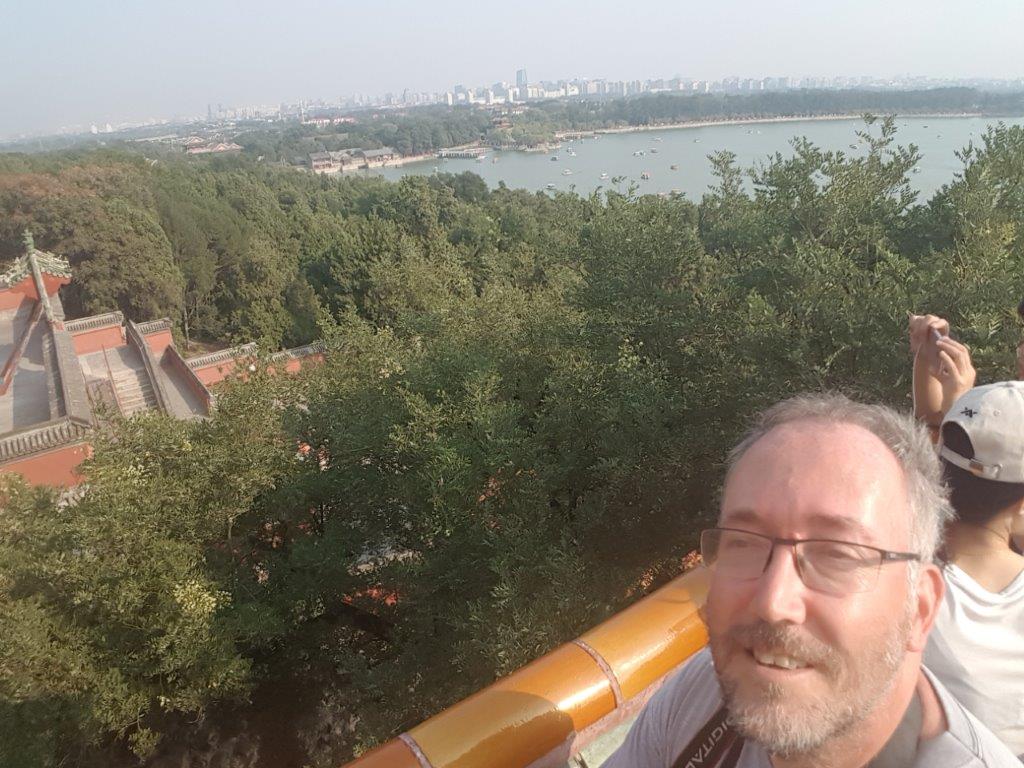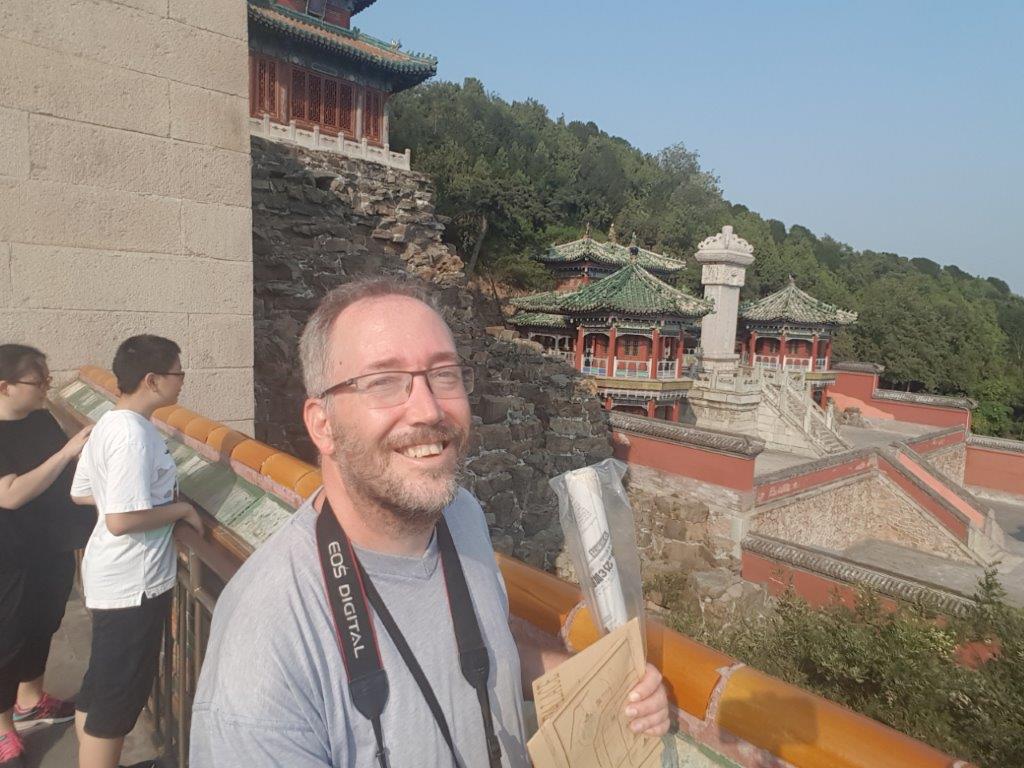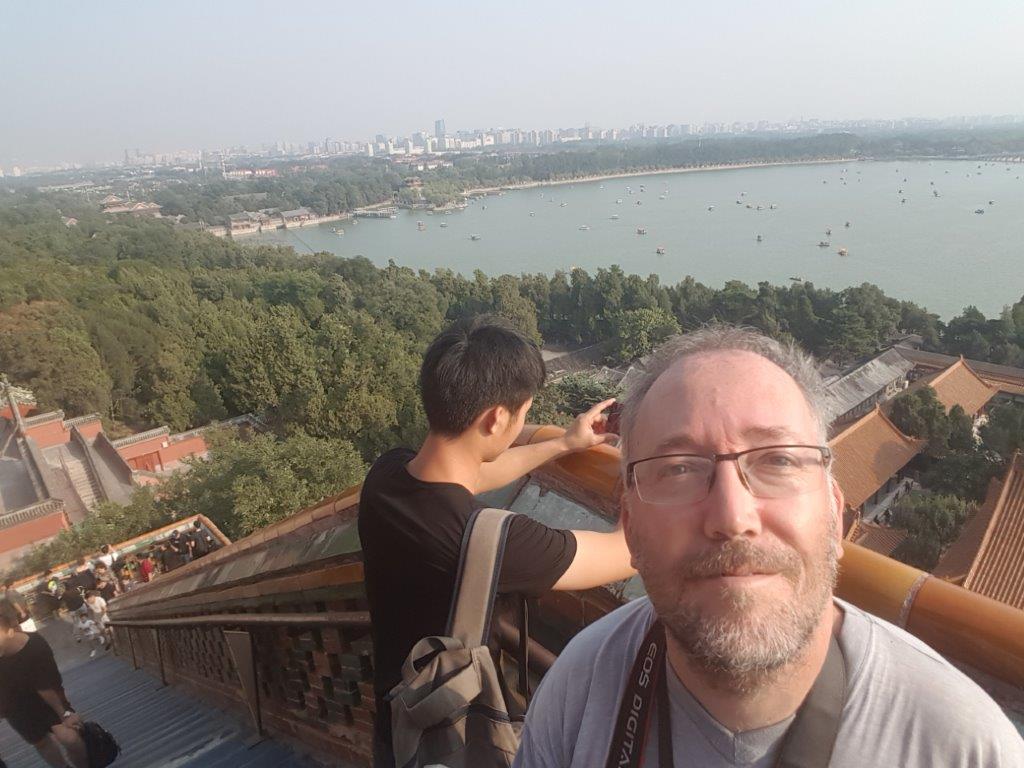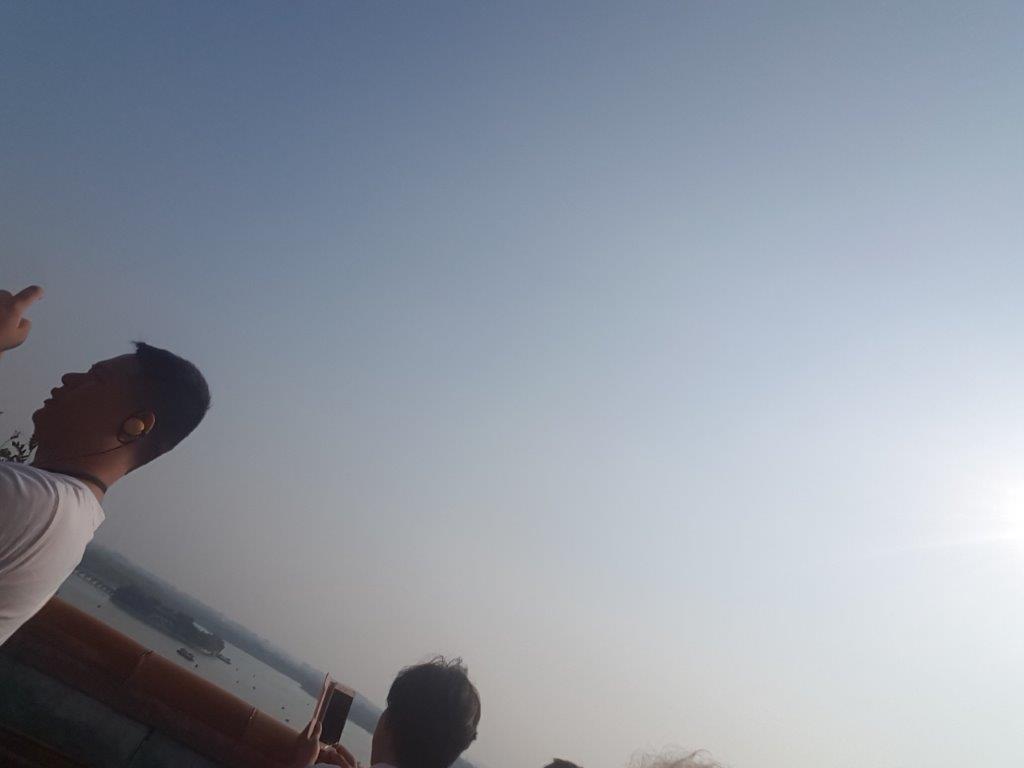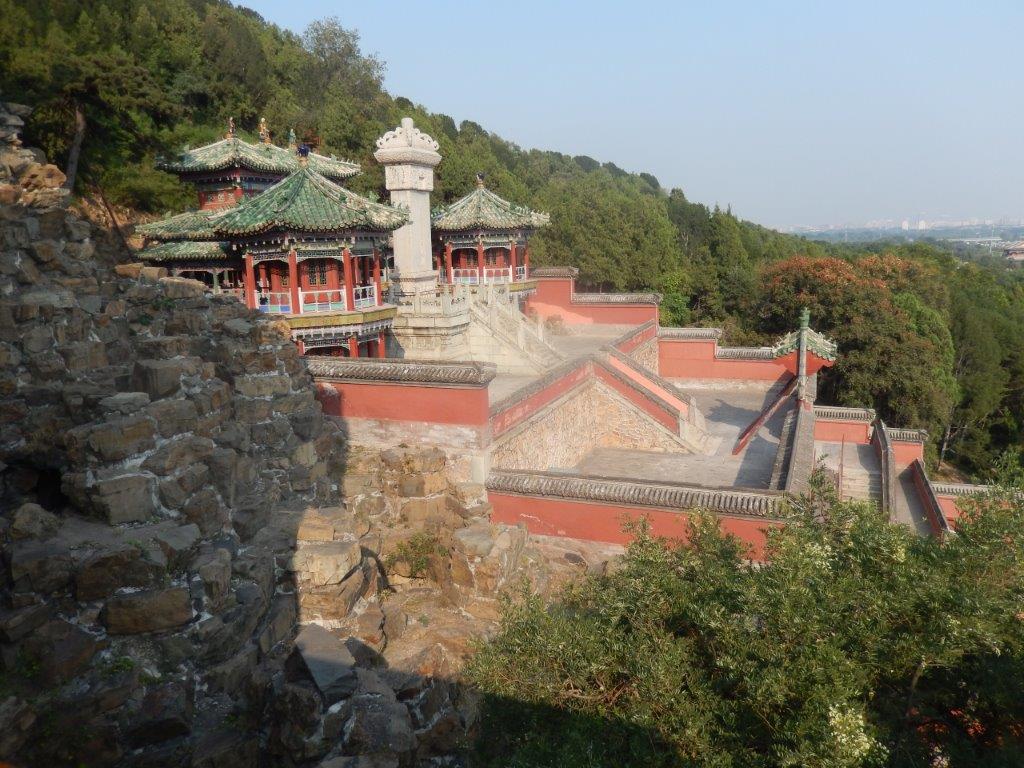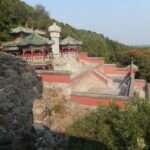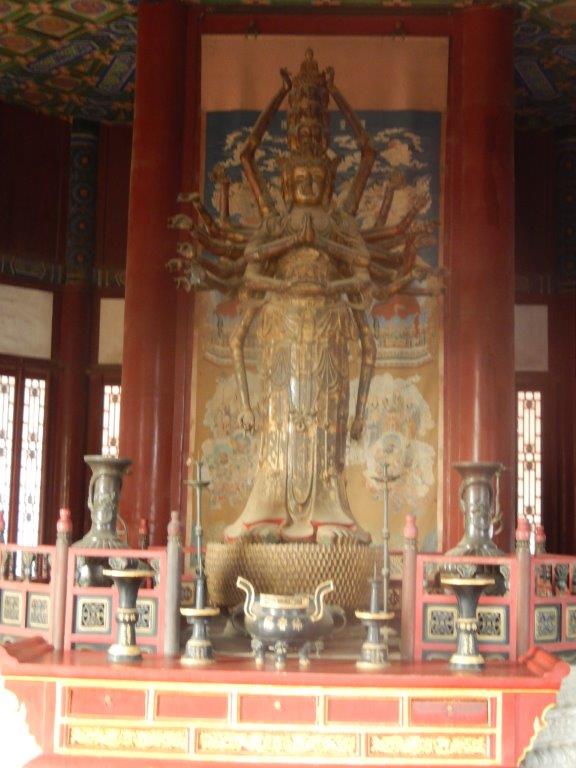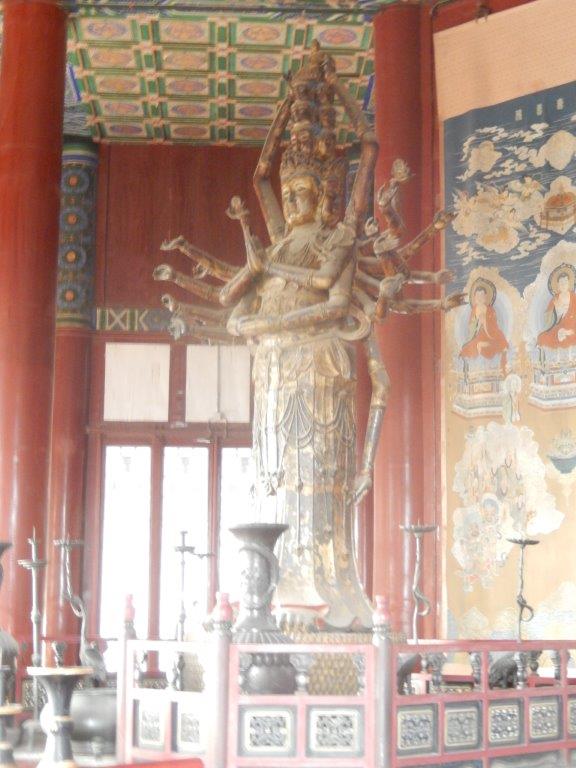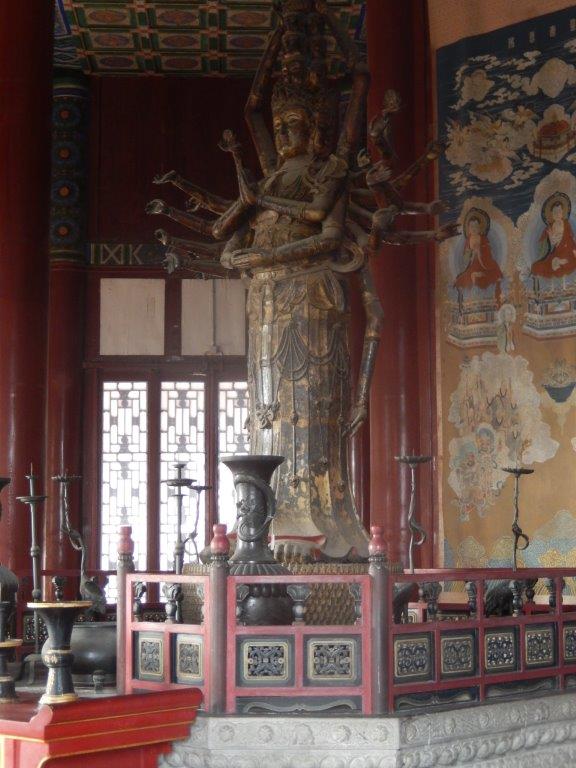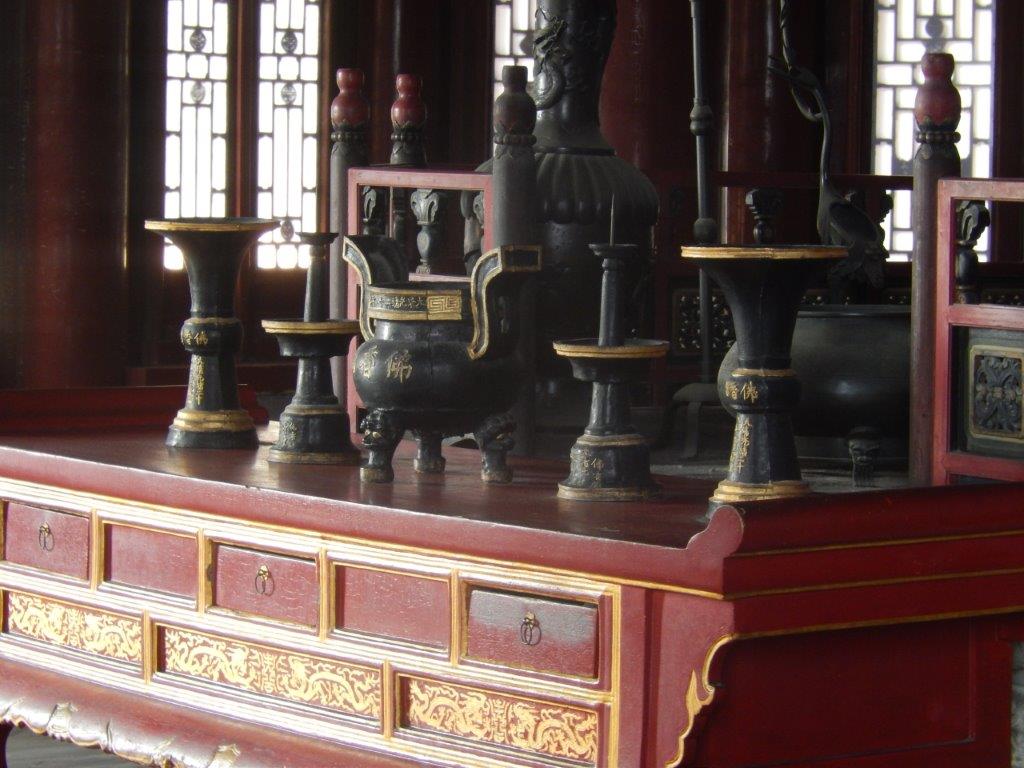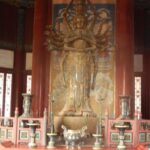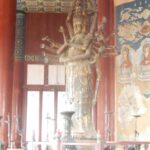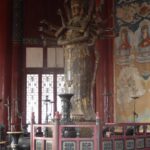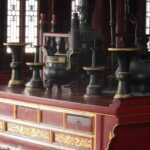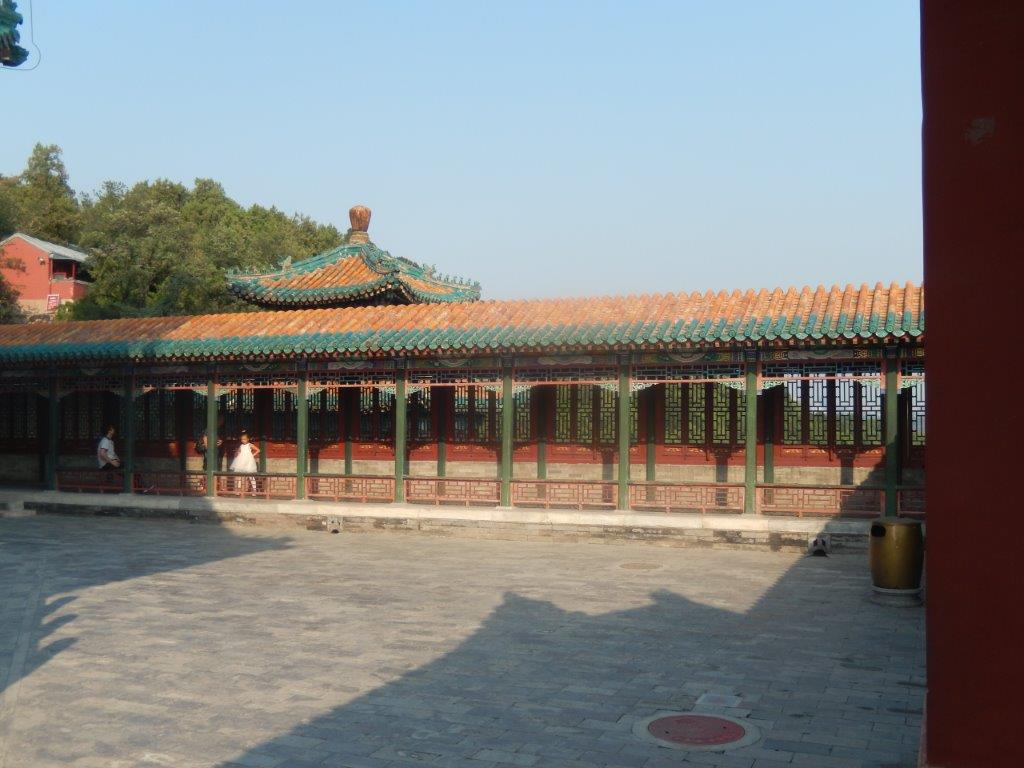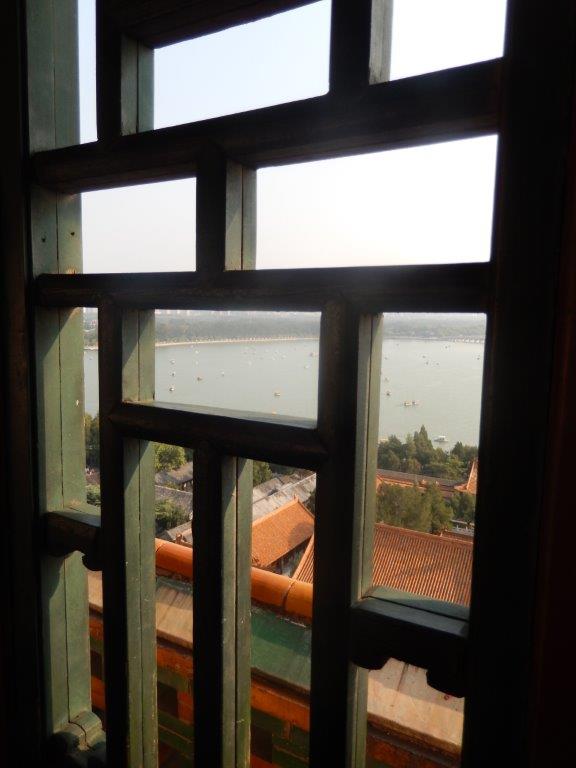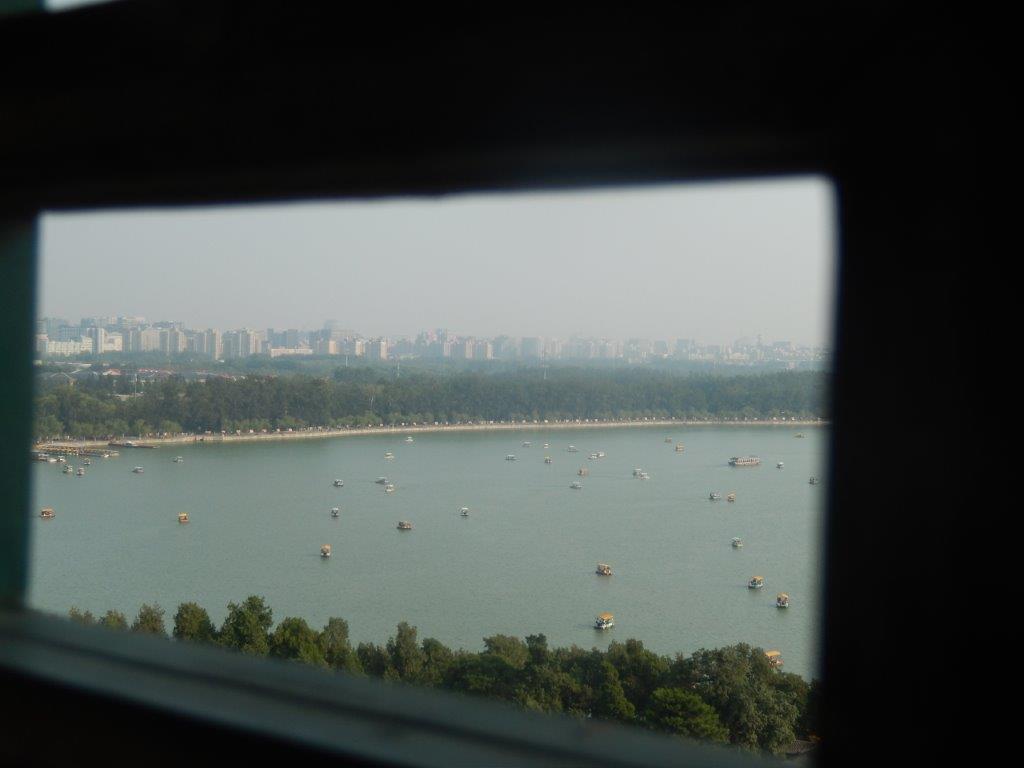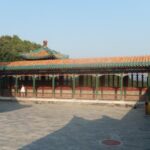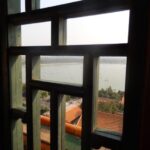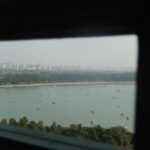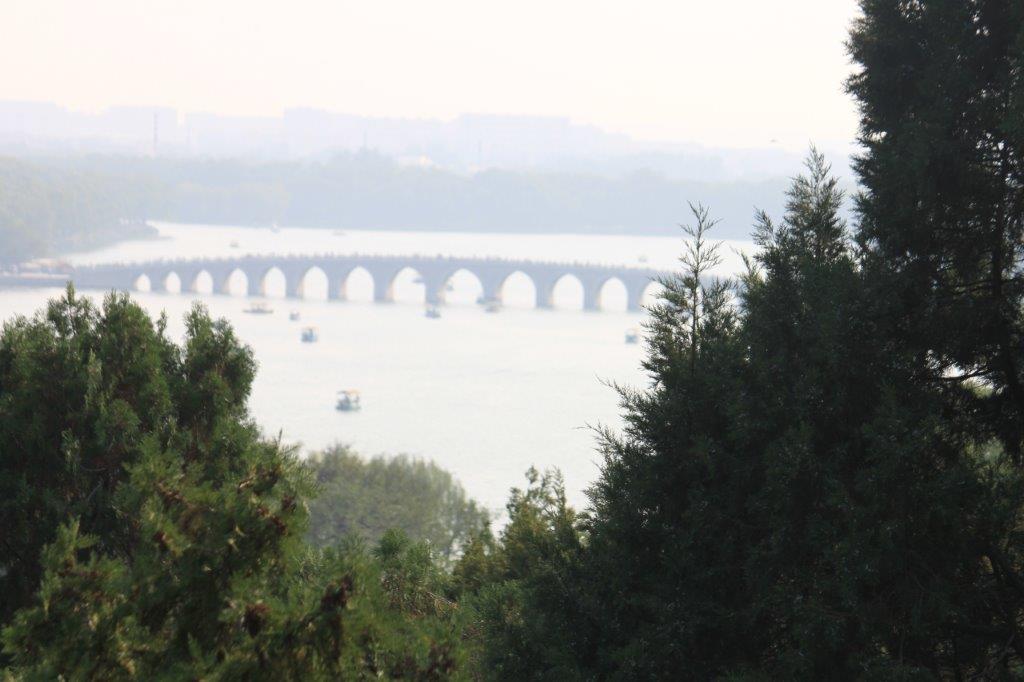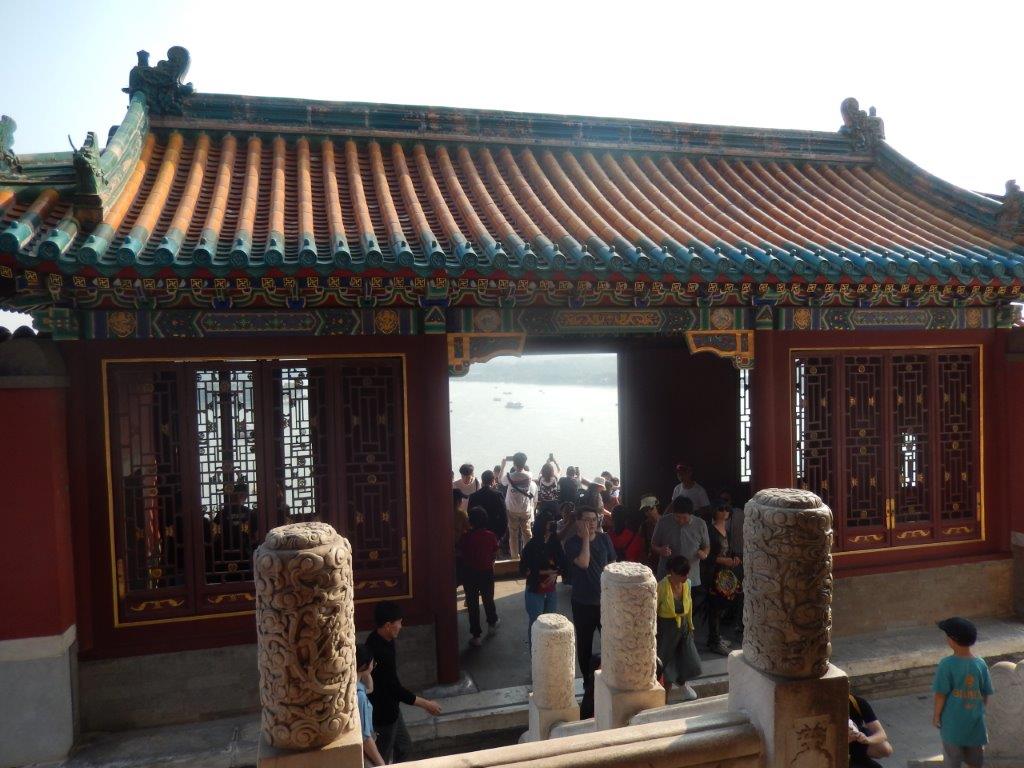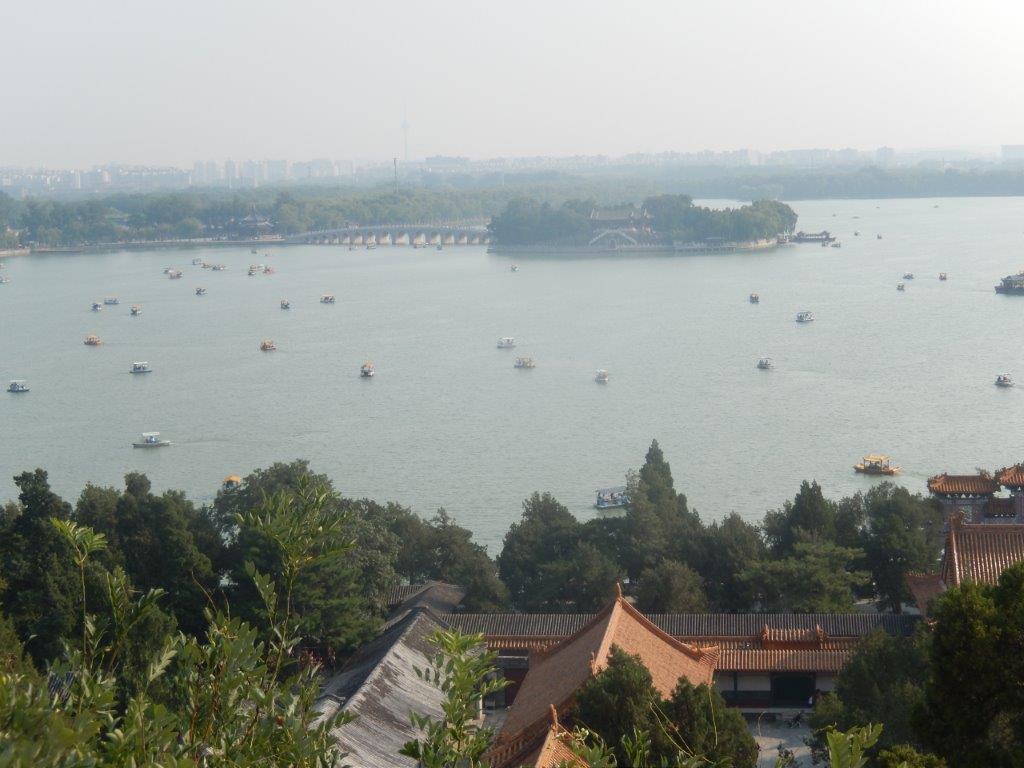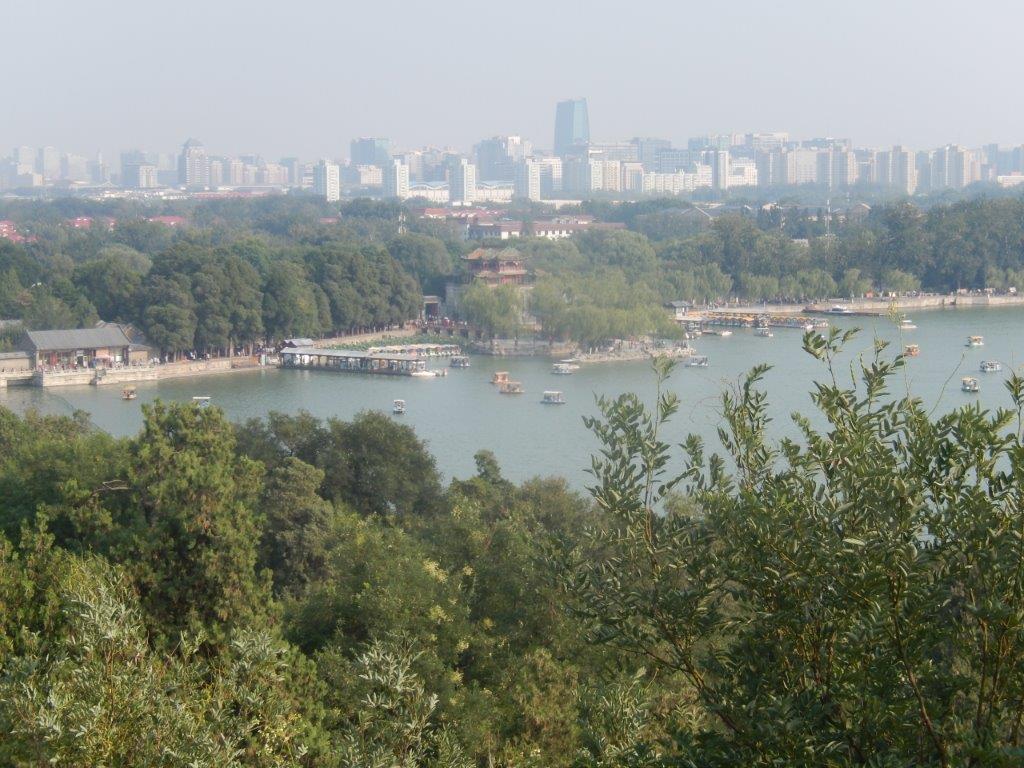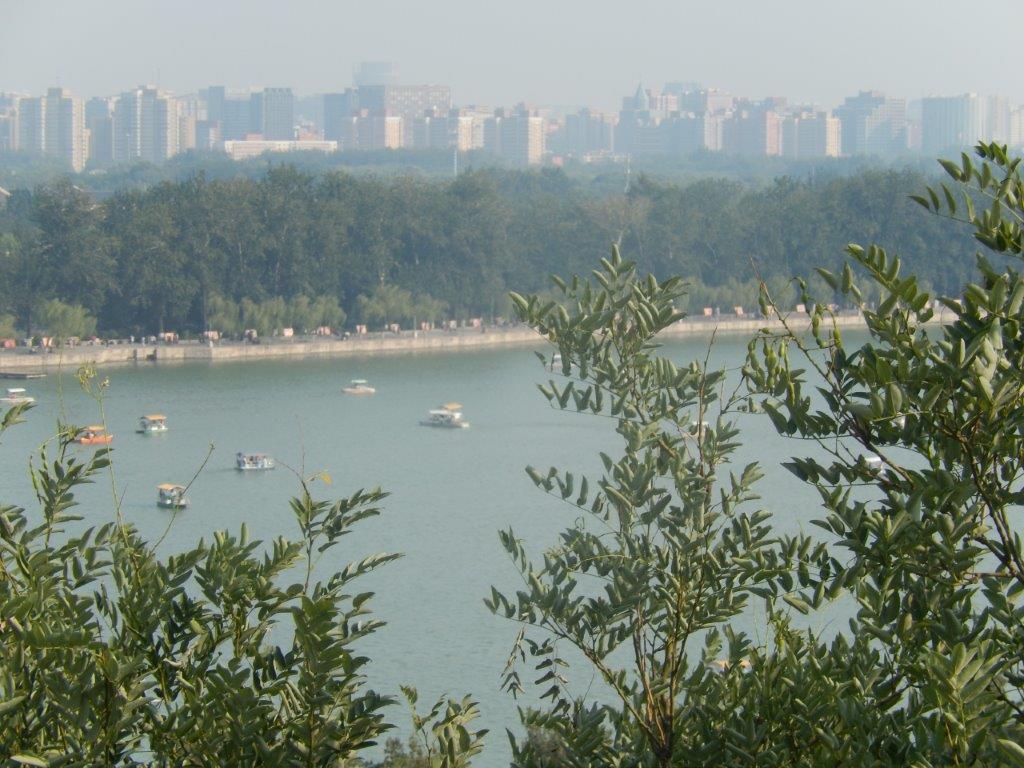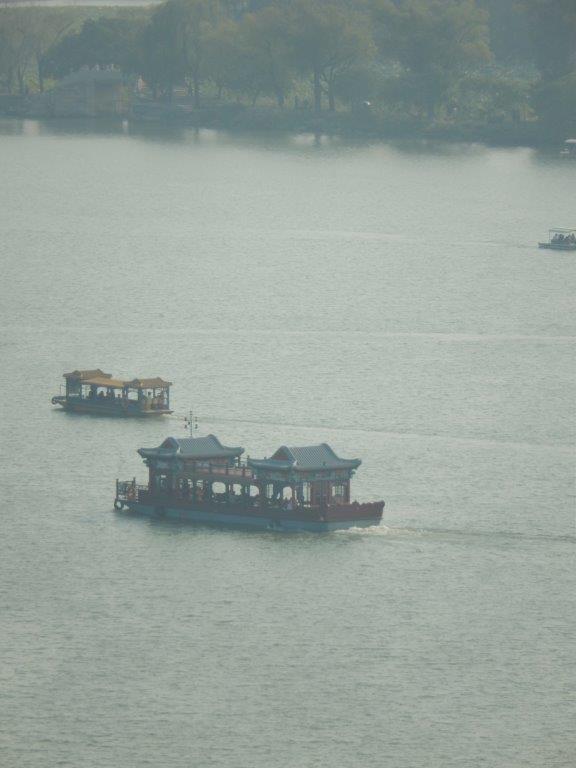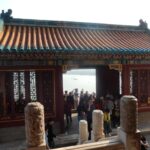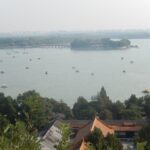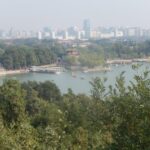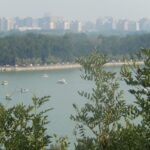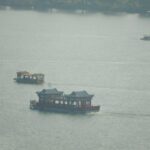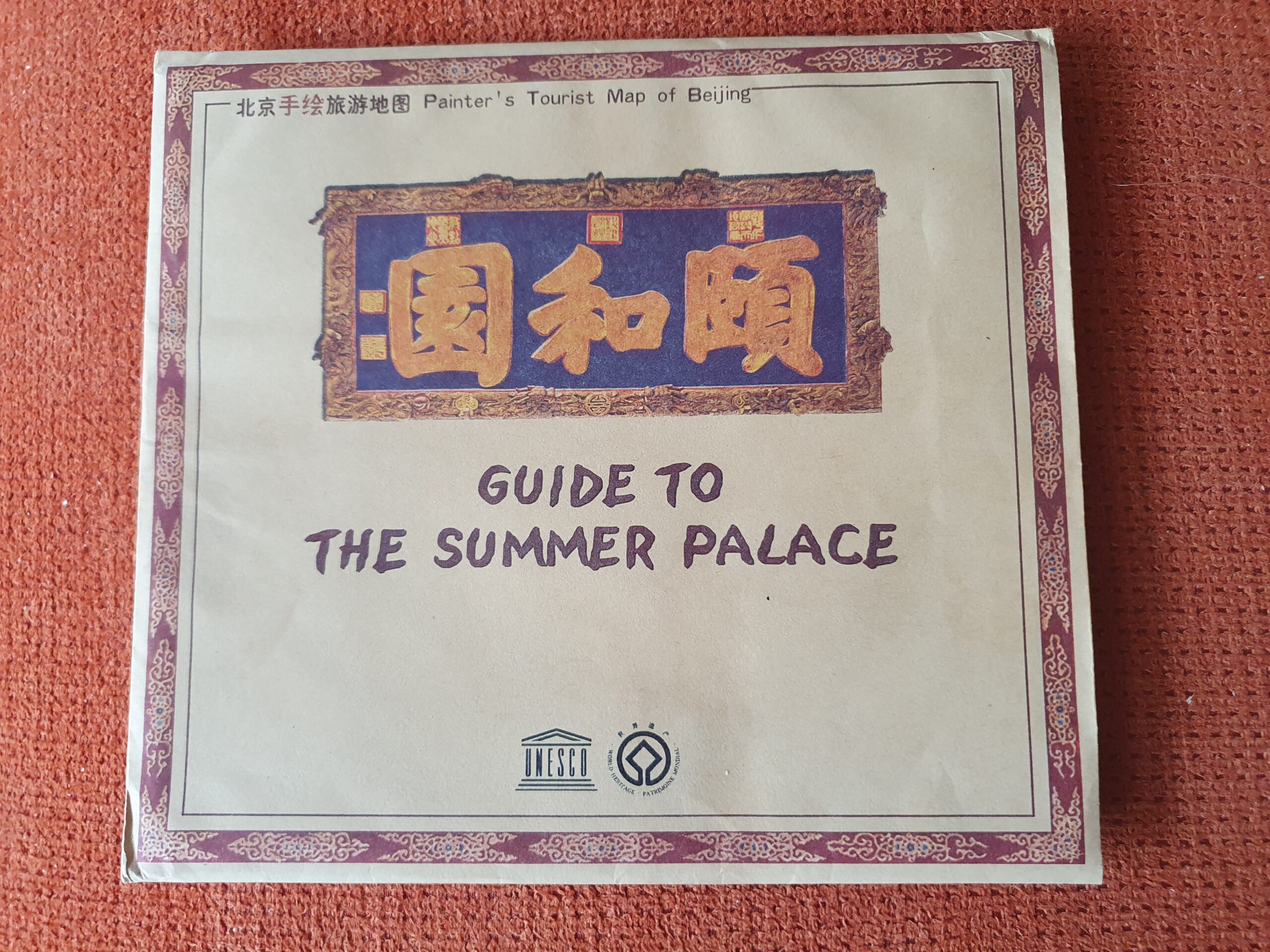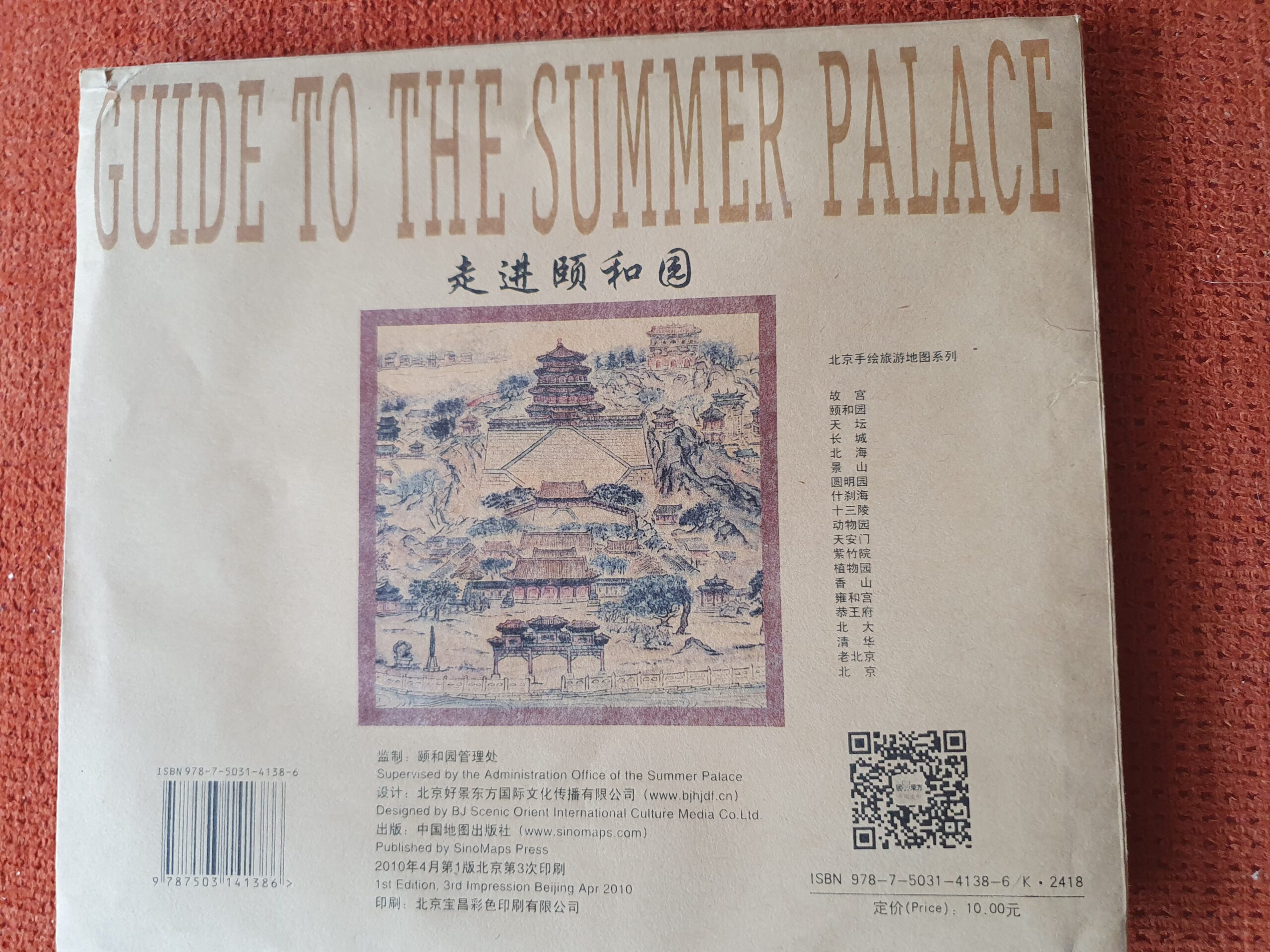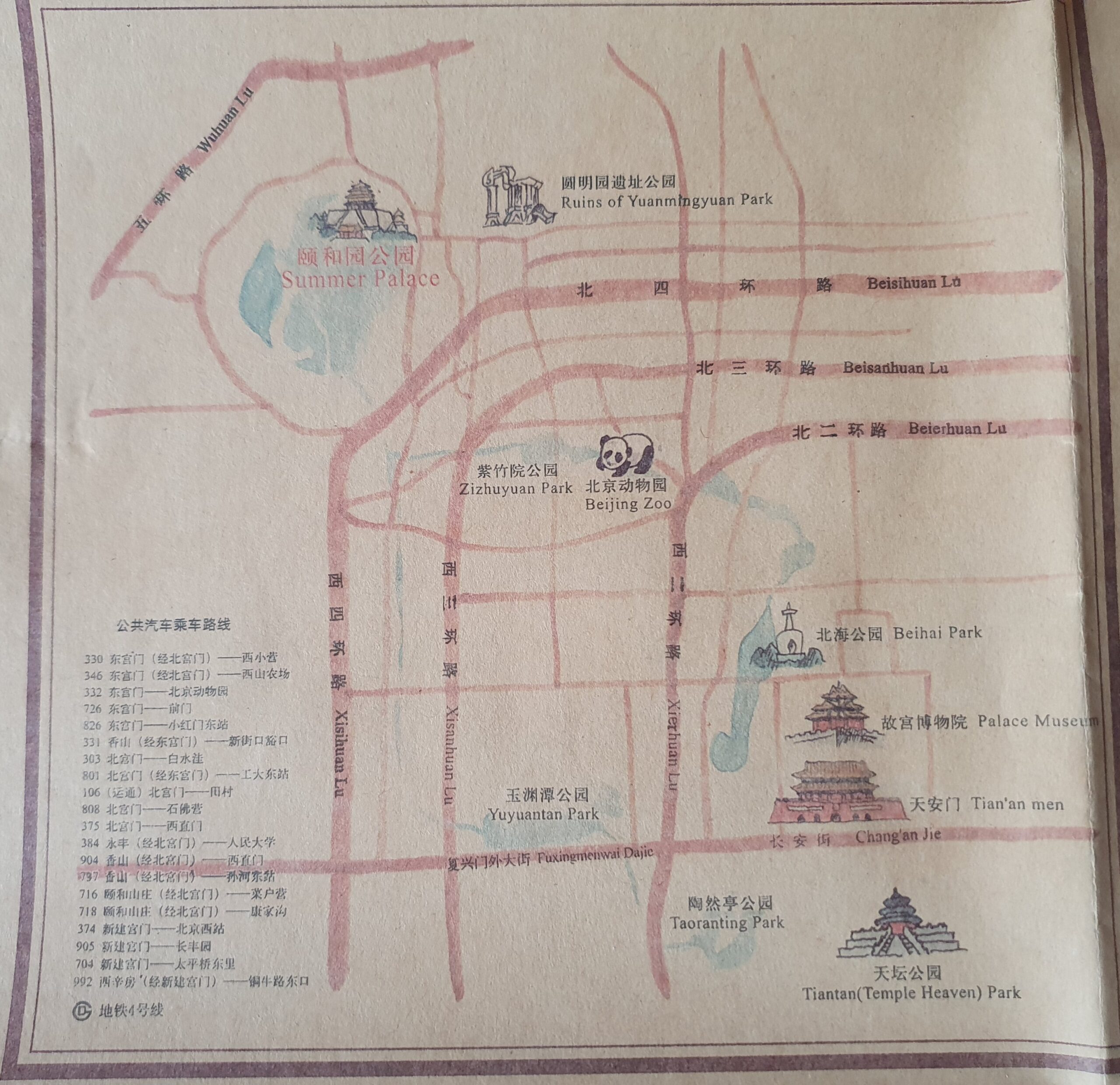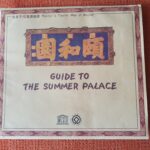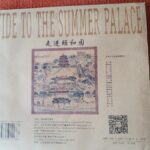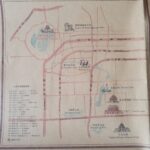The Emperor’s Summer Palace
East Palace Gate entrance
 The entrance of the huge terrain where the Emperor’s Summer Palace is located, can be entered from the east gate, where a large square surrounded by pavilions gives access to the area behind full of lakes ponds, and palaces.
The entrance of the huge terrain where the Emperor’s Summer Palace is located, can be entered from the east gate, where a large square surrounded by pavilions gives access to the area behind full of lakes ponds, and palaces.
 After The Wandelgek had bought an entrance ticket (which is valid all day), he walked behind the masses.
After The Wandelgek had bought an entrance ticket (which is valid all day), he walked behind the masses.
Almost everyone who entered, immediately continued towards the large lake and the temple on top of the large hill, but The Wandelgek decided to evade the crowd and turned right and into a very quiet alley full of trees..
 Then the path dove into a beautiful forest with here and there trees that looked like giant bonsai trees. And apparently they were giant bonsai trees. The iron bars that you see in this picture are there to force the trees growth in a specific direction and probably to support the tree too….
Then the path dove into a beautiful forest with here and there trees that looked like giant bonsai trees. And apparently they were giant bonsai trees. The iron bars that you see in this picture are there to force the trees growth in a specific direction and probably to support the tree too….
 After a walk through the forest going north, The Wandelgek reached this gate building…
After a walk through the forest going north, The Wandelgek reached this gate building…
The Purple Cloud Gate Tower
 He went through the gate and a while further through the forest, arriving at
He went through the gate and a while further through the forest, arriving at
The Garden of Harmonious Pleasures
 Located in the northeast corner of the Summer Palace. In 1751, when the Qianlong Emperor toured the Jiangnan region, he was so impressed with Jichang Garden in Wuxi that he ordered a Huishan Garden (惠山園) to be built in the Summer Palace and modelled after (a reproduction of) the large imperial South Chinese Jichangyuan Garden. Huishan Garden as it was named 1st was renamed “Xiequ Garden” in 1811. The Garden of Harmonious Pleasures is a typical garden in the style of the large imperial gardens of the Qing dynasty. It has five halls, seven pavilions, a hundred bays of promenades and five small bridges. All the buildings are around a large lotus pond. The South China atmosphere inside the garden is palpable.
Located in the northeast corner of the Summer Palace. In 1751, when the Qianlong Emperor toured the Jiangnan region, he was so impressed with Jichang Garden in Wuxi that he ordered a Huishan Garden (惠山園) to be built in the Summer Palace and modelled after (a reproduction of) the large imperial South Chinese Jichangyuan Garden. Huishan Garden as it was named 1st was renamed “Xiequ Garden” in 1811. The Garden of Harmonious Pleasures is a typical garden in the style of the large imperial gardens of the Qing dynasty. It has five halls, seven pavilions, a hundred bays of promenades and five small bridges. All the buildings are around a large lotus pond. The South China atmosphere inside the garden is palpable.
The Wandelgek was very impressed by this beautiful garden around a large pond. A decorated roof covered corridor (a bit similar to the corridor he had seen at the Temple of Heaven surrounded the pond and small decorated bridges crossed the pond, which was filled with waterlily and lotus leaves floating on its surface…
The pond was surrounded by willow trees and several more of the giant bonsai like trees. All around the pond were beautiful pavillions and soothing chinese music could be heard from speakers attached to trees and pavilions.
 It is said that this garden was the favorite place of the famous Empress dowager Cixi who used to fish in the lotus- and waterlilly-filled ponds of the Garden of Harmonious Pleasures…
It is said that this garden was the favorite place of the famous Empress dowager Cixi who used to fish in the lotus- and waterlilly-filled ponds of the Garden of Harmonious Pleasures…
But who was
Empress Dowager Cixi
Empress Dowager Cixi (29 November 1835 – 15 November 1908), of the Manchu Yehe Nara clan, was a Chinese noblewoman, concubine and later regent who effectively controlled the Chinese government in the late Qing dynasty for 47 years, from 1861 until her death in 1908. Selected as a concubine of the Xianfeng Emperor in her adolescence, she gave birth to a son, Zaichun, in 1856. After the Xianfeng Emperor’s death in 1861, the young boy became the Tongzhi Emperor, and she assumed the role of co-empress dowager, alongside the Emperor’s widow, Empress Dowager Ci’an. Cixi ousted a group of regents appointed by the late emperor and assumed the regency along with Ci’an, who later died under mysterious circumstances. Cixi then consolidated control over the dynasty when she installed her nephew as the Guangxu Emperor at the death of her son, the Tongzhi Emperor, in 1875. This was contrary to the traditional rules of succession of the Qing dynasty that had ruled China since 1644.
There is this famous portrait of her:
Cixi supervised the Tongzhi Restoration, a series of moderate reforms that helped the regime survive until 1911. Although Cixi refused to adopt Western models of government, she supported technological and military reforms and the Self-Strengthening Movement. She supported the principles of the Hundred Days’ Reforms of 1898, but feared that sudden implementation, without bureaucratic support, would be disruptive and that the Japanese and other foreign powers would take advantage of any weakness. She placed the Guangxu Emperor, who, she thought, had tried to assassinate her, under virtual house arrest for supporting radical reformers, publicly executing the main reformers. After the Boxer Rebellion led to invasion by Allied armies, Cixi initially backed the Boxer groups and declared war on the invaders. The ensuing defeat was a stunning humiliation. When Cixi returned to Beijing from Xi’an, where she had taken the emperor, she became friendly to foreigners in the capital and began to implement fiscal and institutional reforms aimed to turn China into a constitutional monarchy. The deaths of both Cixi and the Guangxu Emperor in November 1908 left the court in hands of Manchu conservatives, a child, Puyi, on the throne, and a restless, deeply divided society.
Historians both in China and abroad have debated her legacy. Conventionally denounced as a ruthless despot whose reactionary policies – although successfully self-serving in prolonging the ailing Qing dynasty – led to its humiliation and utter downfall in the Wuchang Uprising, revisionists suggested that Nationalist and Communist revolutionaries scapegoated her for deep-rooted problems beyond salvage, and lauded her maintenance of political order as well as numerous effective, if belated reforms – including the abolition of slavery, ancient torturous punishments and the ancient examination system in her ailing years, the latter supplanted by institutions including the new Peking University.
The Wandelgek decided to walk around the pond for a while to soak up the beautiful, peaceful atmosphere. The end of his travels along the Trans Siberian Railway was near now and he decided that it had been a gokd thing that the very crowded center of Beijing, at the Forbidden City and the Tiananmen Square were closed for public. This had given him the opportunity to visit the more peaceful sites like The Temple of Heaven and The Garden of Harmonious Pleasures and even at the Great Wall it had not been crowded because he had visited it early in the morning.
In this movie the Wandelgek is exploring the corridor around the pond.
The decorations of the corridor ceiling and on top of the supporting bars were wonderful. Little paintings mostly depicting gardens or other natural scenes and decorations often of blooming flowers…
Everything here was designed to be beautiful regardless of in what direction someone was looking. The emperor or empress that walked here had to drown in beauty. So did every modern visitor…
Here’s a little movie from the views over the pond and one of the pavillions/temples that was close to the pond.
Even the pathways were artfully paved with mosaics made from small pebble stones…
 The small pavillions around the pond are really beautifully decorated too. Most are surrounded by a roof covered corridor themselves and are adjoined to little squares, adorned with beautiful trees or green vegetation.
The small pavillions around the pond are really beautifully decorated too. Most are surrounded by a roof covered corridor themselves and are adjoined to little squares, adorned with beautiful trees or green vegetation.
Before leaving this garden of tranquility, The Wandelgek had one long, intense, elongated look at it, taking some really deep breaths, before moving on and ascending towards the summit of…
Longevity Hill
Longevity Hill is about 60 metres (200 ft) high and has many buildings positioned in sequence. The front hill is rich with splendid halls and pavilions, while the back hill, in sharp contrast, is quiet with natural beauty.
 While ascending The Wandelgek passed some old buildings with beautiful chinese style roofs and above them and above the trees he suddenly had a 1st glimpse of where he wanted to go next. The Tower of the Fragrance of the Buddha on top of Longevity Hill.
While ascending The Wandelgek passed some old buildings with beautiful chinese style roofs and above them and above the trees he suddenly had a 1st glimpse of where he wanted to go next. The Tower of the Fragrance of the Buddha on top of Longevity Hill.
The environment could be best described as soothing and peaceful. It was simply beautiful to walk there and see the exotic looking trees and rock piles in between them…
Than The Wandelgek glimpsed another construction, a bit temple or pavilion like between the trees and he walked up to the highest point of the path, where he found: the…
Pavilion of Rich Foliage
 This pavilion was surrounded and engulfed by abundant green foliage, hence the name…
This pavilion was surrounded and engulfed by abundant green foliage, hence the name…
 From here, The Wandelgek decided to descend towards Kunming Lake.
From here, The Wandelgek decided to descend towards Kunming Lake.
He descended from Longevity Hill and crossed a small but delicate bridge…
The long corridor
The Long Corridor is a covered walkway in the Summer Palace in Beijing, China. First erected in the middle of the 18th century, it is famous for its 728 m (2,388 ft) length in conjunction with its rich painted decoration (more than 14,000 paintings).
 The Long Corridor was first built in 1750, when the Qianlong Emperor commissioned work to convert the area into an imperial garden. The corridor was constructed so that the emperor’s mother could enjoy a walk through the gardens protected from the elements. Like most of the Summer Palace, the Long Corridor was severely damaged by fire which Anglo-French allied forces laid in 1860 during the Second Opium War. It was rebuilt in 1886. As a part of the Summer Palace, the Long Corridor was included on the UNESCO World Heritage List in December, 1998.
The Long Corridor was first built in 1750, when the Qianlong Emperor commissioned work to convert the area into an imperial garden. The corridor was constructed so that the emperor’s mother could enjoy a walk through the gardens protected from the elements. Like most of the Summer Palace, the Long Corridor was severely damaged by fire which Anglo-French allied forces laid in 1860 during the Second Opium War. It was rebuilt in 1886. As a part of the Summer Palace, the Long Corridor was included on the UNESCO World Heritage List in December, 1998.
The Long Corridor leads from the Gate for Greeting the Moon (Yao Yue Men) in the east westwards along the northern shore of Kunming Lake. Along its entire length, it keeps to the transitional zone between the lake shore and the foot of the Longevity Hill, which is on the opposite side of the corridor. The Marble Boat, a landmark lakeside pavilion, is located near the western end of the corridor. The middle section of the Long Corridor passes in a southward bend around the central building complex on the lake side of Longevity Hill, The main hall in this complex is the Cloud-Dispelling Hall (Pai Yun Dian), where the Empress Dowager Cixi used to celebrate her birthday. The Long Corridor runs through the Cloud-Dispelling Gate (Pai Yun Men) that marks the center of the corridor. The Gate is a landmark in its own right and covered in paintings.
The total length of the Long Corridor is 728 metres (2,388 ft), with crossbeams under the roof dividing it into 273 sections. Along its course, there are four octagonal pavilions with double eaves, two on each side of the Cloud-Dispelling Gate. The pavilions symbolize the four seasons (spring, summer, autumn, winter) and are named (from east to west): Liu Jia (Chinese: 留佳; pinyin: Liú Jiā, “retaining the goodness”), Ji Lan (Chinese: 寄澜 ; pinyin: Jì Lán, “living with the ripples”), Qiu Shui (Chinese: 秋水; pinyin: Qiū Shuǐ, “autumn water”), and Qing Yao (Chinese: 清遥; pinyin: Qīng Yáo, “clear and far”). Midway between the two pavilions on either side of the Cloud-Dispelling Gate, pavilions on the lake shore can be reached through short southward extension of the Long Corridor: the Facing-the-Seagull Boat (Dui Ou Fang) Pavilion in the east and the Fish-and-Algae Pavilion (Yu Zao Xuan) in the west. In the west, there is also a northward extension opposite of the Fish-and-Algae Pavilion, which leads to a three-storey octagonal observation tower.
The Wandelgek slowly walked through the corridor and looked up at the wonderfully delicate paintings that were depicted on the wooden bars that supported the ceiling.
The Long Corridor is richly decorated with paintings on the beams and the ceiling. In total there are more than 14,000 paintings, which depict episodes from Chinese classical literature, folk tales, both historical and legendary figures, and famous Chinese buildings and landscapes along with flowers, birds, fish, and insects. In each of the four pavilions, there are two major paintings over the two doorways on the eastern and western sides.
Underneath is an example of a beautiful story depicted in the Long Corridor:
The Tale of the Peach-Blossom Land
The “Tale of the Peach-Blossom Land” is set during the reign of Emperor Xiaowu of the Eastern Jin Dynasty. It tells the story of a fisherman who discovers a secluded valley (Shi Wai Tao Yuan) located on the other side of a narrow cave. The inhabitants of the valley were the descendants of war refugees from the times of the Qin Dynasty. They had lived in this utopia untroubled by the further course of history in peace and harmony ever since. The fisherman returned home to tell the story, but the idyllic valley could never be found again.
Kunming Lake
Kunming Lake is the central lake on the grounds of the Summer Palace in Beijing, China. Together with the Longevity Hill, Kunming Lake forms the key landscape features of the Summer Palace gardens.
With an area of 2.2 km2 (0.8 sq mi), Kunming Lake covers approximately three-quarters of the Summer Palace grounds. It is quite shallow, with an average depth of only 1.5 meters (5 ft).
Kunming Lake is a manmade lake whose predecessors were called Wengshan (Jar Hill) Pond and Xihu Lake. They were reservoirs which had been used as sources of water both for the city and irrigation of fields over a period of 3,500 years. Guo Shoujing, a famous astronomer and engineer in his time, developed it into a reservoir for the capital of the Yuan Dynasty in 1291. The conversion of the area into an imperial garden was commissioned by the Qianlong Emperor with the work being carried out between 1750 and 1764. In the course of creating the gardens, the lake area was extended by a workforce of almost 10,000 laborers.
Nowadays there are lots of tourist boats that look like small pavillions floating on the lake. Some are touring, others are functioning as ferries to get people accross the lake quickly. As I wrote before, the Summer Palace park is quite large.
The Wandelegek now left the long corridor and walked towards the:
Hall of Dispelling Clouds
Situated on the centre of the central axis of Longevity Hill. Originally the Great Temple of Gratitude and Longevity (大報恩延壽寺), it was renovated in 1892 and became a place for Empress Dowager Cixi to receive guests, host grand ceremonies, and celebrate her birthday.
The Wandelgek walked towards its entrance.
Above its rooftop, the Tower of the Fragrance of the Buddha was visible as was the steep wall with the steep stairs leading to it.
The courtyard of the hall of dispelling clouds was surrounded by a roofed corridor and like all this type of corridors, it was abbundantly decorated…
Climb to the Tower of the Fragrance of the Buddha
The tower, 41 metres high, is a three-storeyed octagonal structure with four tiers of eaves. Architecturally, it is a major building in the Summer Palace garden…
The Wandelgek now started his climb of the multiple stairs going up to the Tower of the Fragrance of the Buddha. The 1st level of stairs was protected by a roofed gallery…
Further up, the roofs disappeared…
Where the stairs changed direction, were small platforms with balustrades from where the view over lake Kunmin could be enjoyed.
Also there were views over adjoining temples or pavillions…
One of those were the
Revolving Archives
The Revolving Archives were built during the reign of Emperor Qianlong. This group of buildings includes a main hall, an auxiliary pavilion and a stele inscribed with Emperor Qianlong’s essay on Longevity Hill and Kunming Lake. This is where the emperors and empresses stored their Buddhist scriptures and sculptures. It is also where they would go to recite scriptures and to pray. The auxiliary pavilion has two floors through which a four-storey, colored wooden tower stood. Inside this tower were scriptures and Buddhist statuettes. The tower could be turned to symbolize the cyclic chanting of scriptures.
Located right in the centre of the front hill of Longevity Mountain. The tower was originally meant to be a nine-storey Buddhist pagoda built to resemble the Yellow Crane Tower. The Qianlong Emperor ordered the construction to be stopped just after the eighth storey was built. The tower was built on a 20 m (66 ft) tall stone base, measures three stories and 41 metres (135 ft) in height, and is supported by eight ironwood pillars. Empress Dowager Cixi visited the tower to offer incense and pray.
Beneath are some pictures I made of the interior of the Buddhist temple…
Next The Wandelgek walked through the corridor which was surrounding the area in front of the tower. From here there were views over Kunming Lake too. The corridor itself was elegantly decorated…
The Seventeen Arch Bridge
The largest bridge on Kunming Lake is the 17-Arch Bridge that connects the eastern shore with South Lake Island, representing Penglai.
Close to the bridge on the eastern shore stands a bronze ox sculpture. According to Chinese legend, Yu the Great used an iron ox to prevent flooding. Since the bronze ox is located on the eastern dike of Kunming Lake in the direction of the Forbidden City, it was probably erected in order to protect the Forbidden City from flooding.
From the top level, there was a complete view over Kunming lake and over Beijing…
Then The Wandelgek decided to return to the East Palace Gate. At one of the cassieres, he bought the illustrated map of the area, of which many details are shown in this blogpost.
The Wandelgek now returned to his cab and cabdriver and was brought to the hotel, where he had dinner and enjoyed a few beers in the lounge room.


